ONE-STOP SHOPPING





















THE BAUR AU LAC MAGAZINE CONTINUITY RENEWED ART IS ALL, ALL IS ART A CELEBRATION OF CLASSIC LAMBORGHINI RETRO-FUTURIST DESIGN SPECTACULAR NEW LEADING HOTELS AROUND THE GLOBE
FRESH FACE , CONSISTENT CHARACTER MAKE IT, LOVE IT, COLLECT IT
OF DISCOVERY
GIVE YOUR DREAMS A HELPING HAND ON ZURICH'S BAHNHOFSTRASSE
VOYAGE
»HOW EDGY WERE THOSE GUYS?«

THE BAUR AU LAC MAGAZINE
Edition 2023/24
PUBLISHER & EDITOR IN CHIEF
Joern Pfannkuch
CREATIVE DIRECTOR
Christina Saam
ENGLISH COPY & EDITING
Nigel Robinson
ART EDITING & INTERVIEWS
Gigi O. Kracht
GERMAN EDITING
Undine Zumpe
CONTRIBUTORS
Michael Köckritz | ramp magazine
Lois Lammerhuber | Open your eyes
GRATEFUL ACKNOWLEDGEMENTS

Lukas Hüni
Christian Gläsel
Michael Köckritz | ramp magazine
PHOTOGRAPHERS & PHOTO CREDITS
Antoine Truchet | Mark Arnall
James Balog | Open Your Eyes
David Biedert | Zurich Street Parade
Zürich Tourismus | Rapperswil
Sandra Navarro | Illustrations Baur au Lac
Construct Lonton LTD | Baur au Lac Branding
Detail AG | Baur au Lac
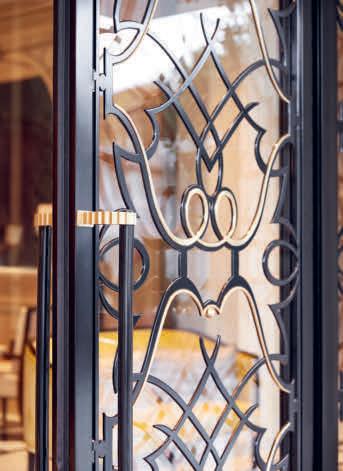
James McDonald | Baur's
George Fakaros | Belvedere Mykonos
Tommy Picone | Hassler Roma
Oliver 63 | Hassler Roma
Thomas Biasotto | Rock of Ages
Brooke Pyke | Deep Devotion
Remi Chapeaublanc | Hatching a Vision
Matthias Mederer | ramp.pictures
Weingut Salzl, Illmitz, Austria
The Leading Hotels of the World
Lithography
MXM Digital Service
Munich, Germany
printed by
Holzer Druck & Medien
Weiler | Germany
EDITORIAL
Dear Guest,
Welcome to Zurich, and welcome to the Baur au Lac. It is our privilege and pleasure to welcome you in the homely atmosphere of our newly renovated and, in part, redesigned entrance and lobby area. The driveway now glistens with a soft green granite hue, and black marble adds even sharper brilliance to our terrace. The warm wood shades on the wall panelling in the lobby are dotted here and there with an almost luminous blue and a striking red. And while all this was in progress, the Baur au Lac also engaged in a finely nuanced rebranding exercise.
VIEWS, too, seized the momentum and completely revamped its cover page. The new-look layout likewise leaves even more space for inspiration – introducing you to the hottest artists in the USA and Mexico, for example, and showcasing new »Leading Hotels of the World« for your next trip around the world. We also give you a fascinating insight into the commitment of our partners to sustainability and society.
We wish you an enjoyable and entertaining read.
THE MANAGEMENT
Verehrte Gäste
published by

VIEWS PUBLISHING
Joern Pfannkuch
Trogerstrasse 40
D-81675 Munich | Germany
Phone: +49 (0)89 982 86 51
info@views-magazine.de www.views-magazine.de
Copyright



VIEWS PUBLISHING
All rights reserved 2023/24
Herzlich willkommen im Baur au Lac und in Zürich. Wir freuen uns, Sie im neuen Ambiente unseres restaurierten und zum Teil neugestalteten Entrées zu empfangen. Die Vorfahrt schimmert nun in sanftgrünem Granit, schwarzer Marmor verleiht unserer Terrasse zusätzlichen Glanz. Zu den warmen Holztönen der Wandpaneele im Eingang haben wir punktuell ein leuchtendes Blau oder ein kräftiges Rot addiert. Parallel dazu wurde der Markenauftritt des Baur au Lac einem Rebranding unterzogen.
Dieses Momentum ergriff auch die VIEWS. Die Titelseite wurde gänzlich neu gestaltet. Das überarbeitete Layout gibt noch mehr Raum, Sie zu inspirieren. So, wenn Sie die angesagtesten Künstler aus den USA und Mexiko treffen oder einmal um den Globus reisen dürfen, um neue »Leading Hotels of the World« kennenzulernen. Last but not least geben wir Ihnen einen spannenden Einblick in das nachhaltige und soziale Engagement unserer Partner.
Wir wünschen viel Vergnügen bei der Lektüre
DIE DIREKTION
1
A Fifty Fathoms is for eternity.
Launched in 1953, the Fifty Fathoms is the first modern diver’s watch. Created by a diver and chosen by pioneers, it played a vital role in the development of scuba diving. It is the catalyst of our commitment to ocean conservation.
RAISE AWARENESS, TRANSMIT OUR PASSION, HELP PROTECT THE OCEAN www.blancpain-ocean-commitment.com
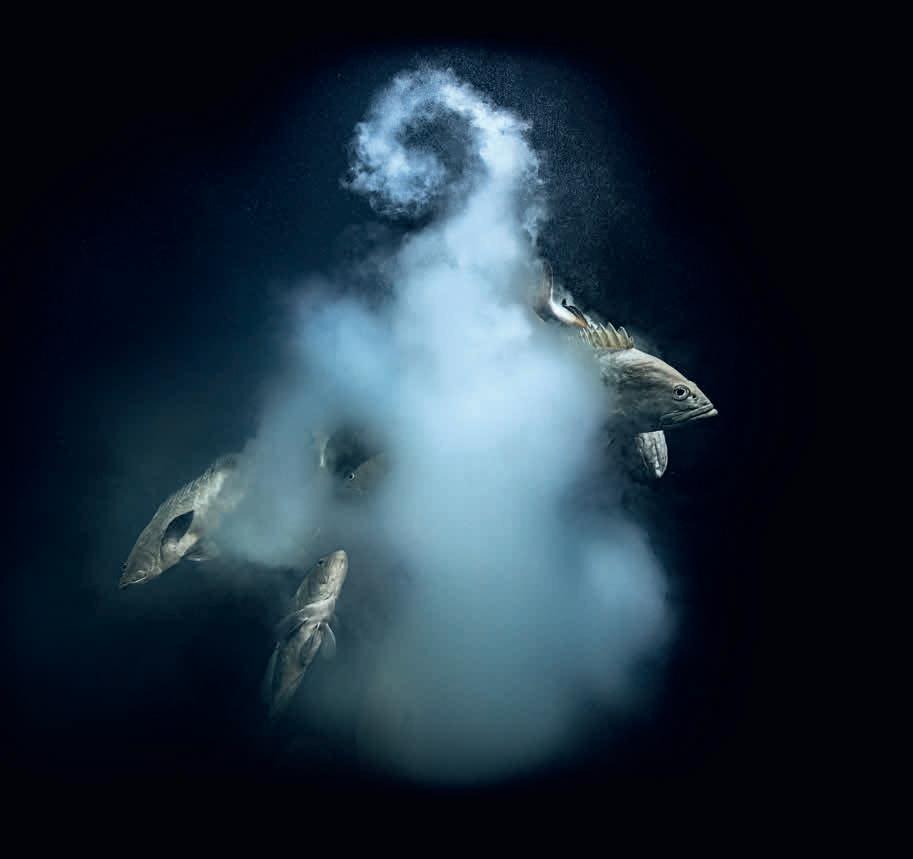 “Creation”
Wildlife Photographer of the Year 2021 Grand Title winner © Laurent Ballesta
“Creation”
Wildlife Photographer of the Year 2021 Grand Title winner © Laurent Ballesta
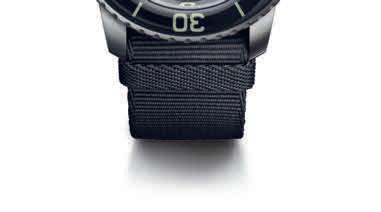



BOUTIQUE ZÜRICH · BAHNHOFSTRASSE 28 · PARADEPLATZ · 8001 ZÜRICH · TEL. +41 (0)44 220 11 80 BOUTIQUE GENÈVE · RUE DU RHÔNE 40 · 1204 GENÈVE · TEL. +41 (0)22 312 59 39





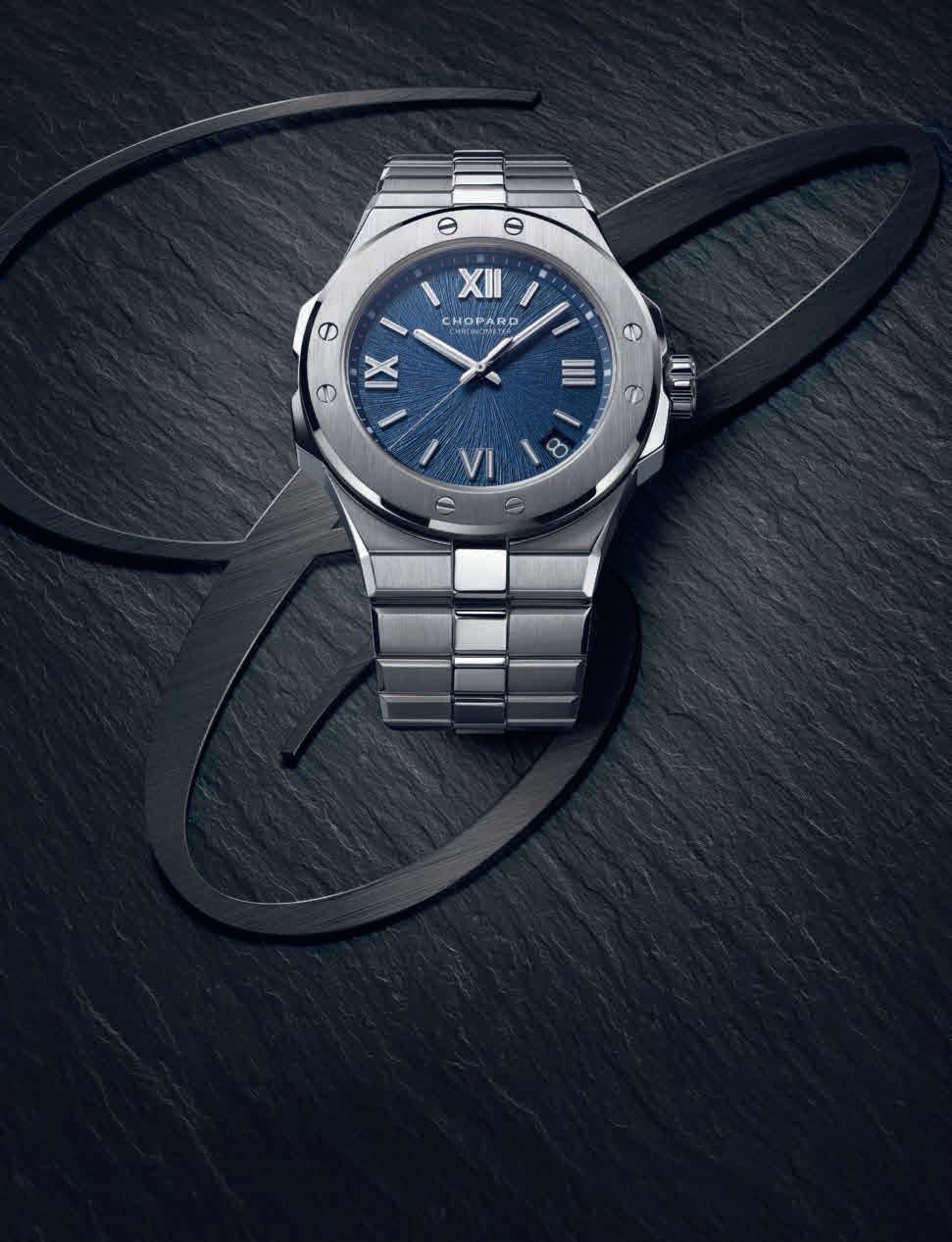

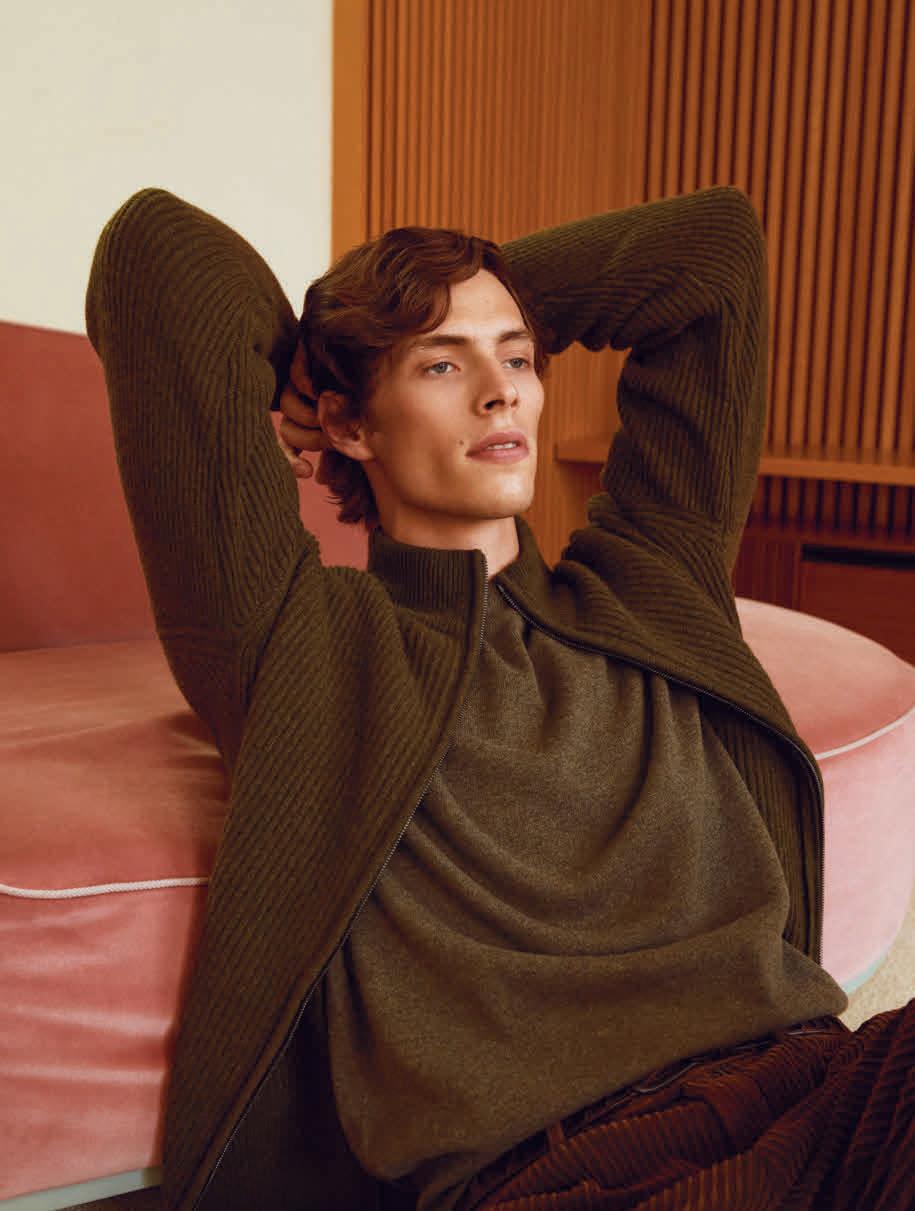

ZÜRICH - GENEVA - ST MORITZ - MILAN - SYLT - EDINBURGH - STOW-ON-THE-WOLD - TURNBERRY www.hawico.com
64


















VOYAGE OF DISCOVERY THE LEADING HOTELS OF THE WORLD SPECTACULAR NEW MEMBERS AROUND THE GLOBE
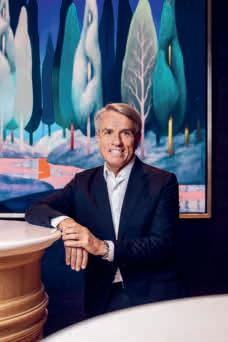









80






PAST HISTORIC. FUTURE PERFECT?
BAUR AU LAC x HASSLER ROMA TWO HOTEL DYNASTIES AT A TURNING POINT


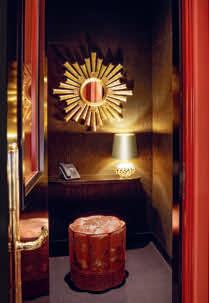




10 VIEWS MAGAZINE CONTENTS INHALT 01 EDITORIAL & PUBLISHER'S DETAILS 14 WHAT'S ON IN ZURICH? FUN, FACTS AND FREEDOM ON OUR DOORSTEP 20 REINVENTION OF AN ICON BAUR AU LAC A SMART EXERCISE IN REBRANDING 22 FRESH FACE, CONSISTENT CHARACTER BAUR AU LAC CONTINUITY RENEWED 44 OUT OF AUSTRIA BAUR AU LAC VINS FINE WINES WITH PREHISTORIC ROOTS 50 MAKE IT, LOVE IT, COLLECT IT SUNSHINE'S NOOK ART IS ALL, ALL IS ART


CONTENTS INHALT


84 DIGITAL ART TOUCHING THE REAL



86 ROCK OF AGES? CAPTURING THE FRAGILITY OF SWITZERLAND'S PEAKS

90 DEEP DEVOTION PLUMBING THE DEPTHS TO PRESERVE THE OCEANS
92
HATCHING A VISION RETURNING EAGLES TO THE ALPS

94
THE ART OF HIGH LIVING THE INTANGIBLE APPEAL OF HIGH-END SWISS REAL ESTATE

96 SUSTAINABLE GOLD ETHICAL INVESTMENT IN PRECIOUS METALS




98

TO LIVE AGAIN CHOOSING – AND RESTORING –THE SLOW LANE
100

»HOW EDGY WERE THOSE GUYS?«
RAMP MAGAZINE A CELEBRATION OF CLASSIC LAMBORGHINI RETRO-FUTURIST DESIGN

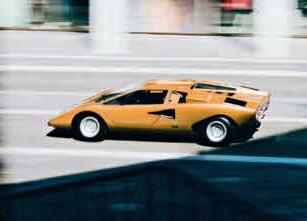
113
ONE-STOP SHOPPING GIVE YOUR DREAMS A HELPING HAND ON ZURICH'S BAHNHOFSTRASSE



12 VIEWS MAGAZINE

In Gassen 7 Zurich Switzerland +41 44 937 10 70 zurich@domeisen.com www.domeisen.com open by appointment
OPEN YOUR EYES












James Balog is a respected US-born nature photographer, geoscientist and mountaineer. He is also the founder of the Earth Vision Trust.



James Balog ist ein renommierter US-amerikanischer Naturfotograf, Geowissenschaftler, Bergsteiger und Gründer des Earth Vision Trust.


















In the heart of Zurich, world-leading science will line up alongside world-class photography for the first time starting on September 8. Acting in concert, the two disciplines will birth a new communication format. The focus –quite literally, in this case – will be on the UN’s 17 Sustainable Development Goals (SDGs) as a multinational compass for the development of a more peaceful and just world.















Generously dimensioned open-air installations will dovetail documentary photography with scientific insights across 17 exhibition ‘islands’, the whole adding up to a potent plea for peace, tolerance and togetherness rooted in a humanistic mindset. The magical aesthetics of the pictorial narratives will transform the parks, streets and public squares of Zurich into an entire cityscape of vivid imagery.
The Baur au Lac has stepped up as patron for SDG 13, »Action to combat climate change«, and will, for example, feature works by photographer James Balog. Over the past 20 years, the Baur au Lac has taken countless steps to reduce CO2 emissions by 72% - such as installing a system that uses water from Lake Zurich to cool and heat the building. The festival will be held every year between now and 2030 – by which time we will hopefully have resolved some of the most pressing problems…



Im Herzen der Stadt Zürich trifft ab 8. September 2023 erstmals Weltklasse-Wissenschaft auf Weltklasse-Fotografie. Gemeinsam kreieren sie ein neues Kommunikationsformat. Im Wortsinn stehen dabei im Fokus die 17 Nachhaltigen Entwicklungsziele der UN (SDG). Ein multinationaler Kompass zur Entwicklung einer friedlicheren und einer gerechteren Welt.



















































Grosszügige Open Air Installationen vereinen Dokumentarfotografie und wissenschaftliche Erkenntnis in 17 Ausstellungs-Inseln zu einem Plädoyer für Frieden, Toleranz und Miteinander, getragen von humanistischer Gesinnung. Durch die ästhetische Magie der Bilderzählungen verwandeln sich die Gärten, Strassen und Plätze von Zürich in eine Bilder-Stadt.






































Das Baur au Lac hat das Patronat SDG 13 übernommen. Es beinhaltet »Massnahmen zum Klimaschutz« unter anderem mit Arbeiten des Fotografen James Balog.




In den letzten 20 Jahren hat das Baur au Lac unzählige Massnahmen ergriffen, um den CO2 Ausstoss um 72% zu vermindern, darunter eine Anlage, welche das Wasser des Zürichsees nutzt um das Gebäude zu kühlen und zu heizen. Das Festival wird bis 2030 jährlich stattfinden – vielleicht haben wir die dringendsten Probleme ja bis dahin gelöst...

14 VIEWS MAGAZINE
Stop. Think. Feel. Act.
Copyright: James Balog/Open Your Eyes




















juliusbaer.com WHO SAYS WEALTH MANAGEMENT IS JUST ABOUT MONEY? How we invest today is how we live tomorrow.
FEEL THE BEAT

Fans of techno music love the moment when the hypnotic rhythm of the bass drum fuses the ecstatic crowd into a single, seething mass – the moment when something greater than the surrounding reality comes to life.
Every August, hordes of music lovers, global nomads and assorted party animals descend on Zurich to celebrate the Street Parade: the biggest house and techno festival in the world. Guests at the Baur au Lac enjoy an especially privileged box seat when the 30 or so »love mobiles« boom past the hotel’s private park on their riotous tour of the city. Let’s rave!
Techno-Begeisterte lieben dieses Gefühl, wenn die Masse im Sog der bassdrum-betonten Rhythmen miteinander verschmilzt. Dann entsteht etwas Grösseres als die Realität um einen herum.
Alljährlich im August finden sich in Zürich »music lovers, global nomads, and party animals« für das grösste House- und Technofestival der Welt zusammen. Die Gäste des Baur au Lac haben einen ganz besonderen Logenplatz, wenn die rund 30 »Love Mobiles« auf ihrer Tour durch die Stadt am Privatpark des Hotels vorbeifahren. Let’s rave!



16 VIEWS MAGAZINE
AGENDA ZURICH
Zurich Street Parade
© Nobilis Estate AG, Zug lllu stration: Daniel Müller nobilis estate ag Schweizweit besondere Immobilien Alpenstrasse 12 | CH- 6302 Zug | T +41 (0)41 709 0 0 14 Englischviertelstrasse 24 | CH- 8032 Zürich | T +41 (0)44 266 60 39 Schloss Fürstenau | CH- 7414 Fürstenau | T +41 (0)81 632 30 20 www.nobilis-estate.com BY APPOINTMENT TO MANY HAPPY CLIENTS: NOBILIS ESTATE AG
Timeout: Discover Lake Zurich in a historical saloon boat.

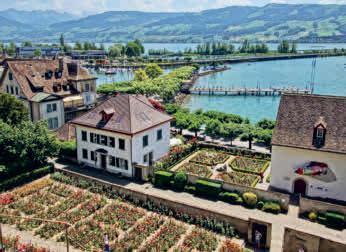
SEAS THE DAY!
Entschleunigung: Den Zürichsee mit einem historischen Salonboot entdecken.
The son of legendary hotel founder Johannes Baur was the first to establish a regular shipping line up and down Lake Zurich to and from the picturesque town of Rapperswil. At the close of the 19th century, Theodor Baur – the blood of a visionary father coursing through his veins – was keen to develop the unique combination of vibrant city and relaxing lake as a tourist attraction. He wanted the lake to be accessible to as many people as possible. To this day, a trip out on the water remains the most delightful way to explore the city’s surroundings in almost contemplative tranquillity.
One might say that history is now repeating itself at the Baur au Lac: The Kracht family has purchased the »Tugenia«, one of the oldest saloon boats, whose number is strictly limited on the lake’s hallowed waters. Built in 1904 on the wharf of one Johannes Faul, its home until 2005 was the Vierwaldstätter Lake near Lucerne. Now fully restored and electrified, the »Tugenia« accommodates eight to twelve guests. In the summer months, its crew will serve refreshing aperitifs on the lake, lay on romantic excursions for two, cook up traditional cheese fondues for family outings and host small company events.

Theodor, Sohn des legendären Hotelgründers Johannes Baur, gilt als Initiator einer regelmässigen Schiffsverbindung über den Zürichsee bis ins pittoreske Rapperswil. Das Visionäre seines Vaters im Blut, wollte er Ende des 19. Jahrhunderts damit die atmosphärisch einzigartige Verbindung von lebendiger Stadt und erholsamem See als Tourismusattraktion entwickeln und für viele zugänglich machen. Bis heute ist eine Fahrt auf dem Zürichsee die schönste Möglichkeit, Zürichs Umgebung in geradezu meditativer Ruhe zu entdecken.
Das Baur au Lac knüpft nun wieder an seine eigene Geschichte an. Mit der »Tugenia« erwarb die Familie Kracht eines der ältesten Salonboote, deren Zahl auf dem Zürichsee streng limitiert ist. Es wurde 1904 in der Werft von Johannes Faul gebaut und war bis 2005 auf dem Vierwaldstätter See beheimatet. Die im Zuge der Restaurierung inzwischen elektrifizierte »Tugenia« bietet Platz für acht bis zwölf Gäste. In den warmen Monaten lädt ihre Crew zu erfrischenden Apéros, romantischen Ausflügen zu zweit, Käsefondue im Kreise der Familie oder kleineren Firmenanlässen ein.
18 VIEWS MAGAZINE
AGENDA ZURICH
»A BOAT IS LIKE A MAGIC WORLD, LIKE A LITTLE ISLAND.«
Renzo Piano
Rapperswil
Degussa: Your concierge for investments in precious metals.


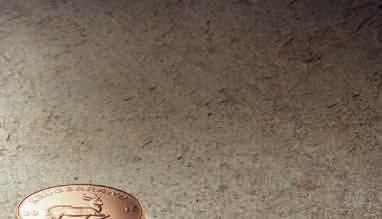







Gold has been the strongest currency for 6,000 years and is therefore considered a solid long-term investment. As the largest independent precious metal trader in Europe outside the banking system, Degussa is able to offer you comprehensive advice in our Swiss branches in Zurich and Geneva. We help you compile your personal investment portfolio with a wide selection of Degussa-branded gold bars. Degussa bars are produced in Switzerland. Furthermore, they are LBMA-certified and bear a bank security number. Our bullion coins represent an alternative investment opportunity. For safe storage, we provide state-of-the-art safe deposit box facilities to protect your assets 24/7.


Further information and online shop at: DEGUSSA-GOLDHANDEL.CH

Memberships:

Bleicherweg 41 · 8002 Zurich · Phone: +41 44 403 41 10 Quai du Mont-Blanc 5 · 1201 Geneva · Phone: +41 22 908 14 00 ZURICH I GENEVA I FRANKFURT I MADRID I LONDON
ACS N T H E CODE T O WIN GO L D
Reinvention of an icon





To succeed, rebranding has to slot a historic continuum seamlessly into the present day. This is the idea Marguita Kracht ran with in crafting the new brand image of the Baur au Lac.
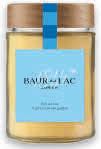


Gelungenes Rebranding ist wie ein Kontinuum, angekommen in unserer Zeit. Diese Idee verfolgte auch Marguita Kracht mit dem neuen Markenauftritt des Baur au Lac.



Rebranding began with the question: What is the identity of the Baur au Lac brand? The answer was found in the hotel’s intimate links with the family who owns it and the city where it stands. The love of detail, lived out for nigh on 180 years now, was another vital ingredient. Armed with this understanding, the team trooped into the archives, listened to anecdotes from decades past and synchronised both sets of findings with today’s expectations and hunger for authentic experiences.




To visualise such a cornucopia of past and present perfection, more expressive verve has been injected into the serifs on the logo. The connecting »au« has been downsized in keeping with its function, but also in recognition of the fine details whose role in completing the big picture is by no means negligible. The lion that has graced the Baur au Lac logo for over a century in a nod to Zurich’s coat of arms also displays a fresh shot of panache. Vivacious in style, the creature has now launched a solo career: Logotype and lion are no longer a fixed duo. They are a flexible team in which each supports the other.
There was never any question that blue would remain the dominant colour. Notwithstanding, the reflecting surface of the lake prompted the choice of a lighter background hue that again and again conjures playful, surprising accents around an eye-catching and very Swiss red. The revised colour scheme finds expression especially in the informative illustrations that both walk guests through the day and now also accompany the stories of the Baur au Lac in their own inimitable way.




Zu Beginn des Rebranding-Prozesses stand die Frage, was für die Marke identitätsstiftend ist. Antwort gaben die beiden starken Verbindungen von Familie und Hotel sowie Hotel und Stadt, schliesslich die seit 180 Jahren täglich gelebte Liebe zum Detail. Mit dieser Vorgabe begab man sich in die Archive, hörte Geschichten zu, die sich im Laufe der Jahrzehnte zugetragen haben und glich beides mit unseren heutigen Erwartungen ab, die auf echte Erlebnisse sinnen.














Um all das sichtbar zu machen, erhielten die Serifen des Logos mehr Schwung. Das vermittelnde »au« wurde kleiner gestellt, einerseits um seine Funktionalität auszudrücken, andererseits um zu zeigen, dass es Feinheiten sind, die zu einem vollkommenen Gesamtbild führen. Der Löwe, der seit hundert Jahren das Baur au Lac Logo ziert und auf Zürichs Wappentier referiert, erhielt ebenfalls mehr Elan. Lebendig in Szene gesetzt, tritt er nun solo auf – Schriftzug und Löwe sind kein Duo mehr, sondern ein Team, das sich gegenseitig unterstützt.



Farblich bestand nie Zweifel daran, dass Blau weiterhin den Ton angibt. Die Reflektion des Sees führte zur Wahl eines helleren Grundtons, der immer wieder mit Überraschungsmomenten in »Schweizer« Rot spielt. Zum Ausdruck kommt das besonders in den informativen Illustrationen, welche durch den Tag führen und nun die Geschichten des Baur au Lac auf ihre Weise begleiten.

20 VIEWS MAGAZINE BAUR AU LAC



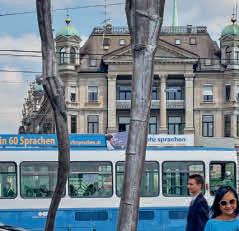










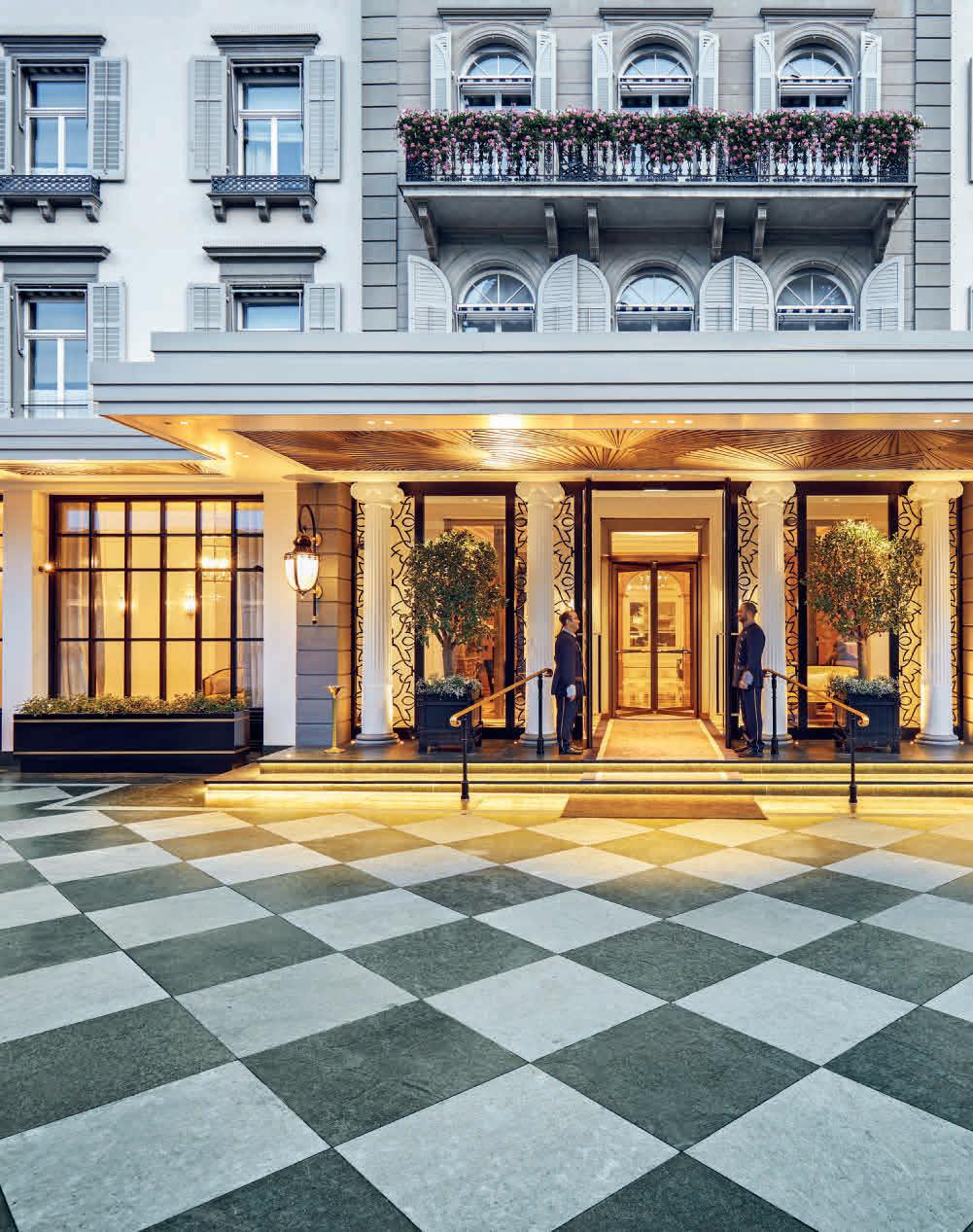
Fresh face, consistent character
Constantly reinventing yourself while never compromising your distinctive personality is an art form the Baur au Lac has mastered for 180 years.
Es ist eine Kunst, sich permanent neu zu erfinden und dabei die eigene Persönlichkeit zu bewahren. Dem Baur au Lac gelingt das seit 180 Jahren.

23



Natural predispositions and accumulated experience are said to be the bedrock of one’s character – an insight for which the 180-year history of the Baur au Lac could almost serve as a live demonstration. Founder Johannes Baur was hailed as a visionary from day one, and his ideas have shaped the hotel on Lake Zurich to this day. His intention was nothing less than to reinvent comfort, luxury and individuality. Yet for all his avant-garde entrepreneurial zeal, he still managed to weave calm continuity into the fabric of his noble establishment. His mental agility always sought to balance the preservation of what had already been so lovingly crafted against the ability to anticipate what the future held – preferably while playing a part in shaping that future.
None of the subsequent generations have ever questioned his original plan: neither the design aspects, nor the running of the hotel.
On the contrary: Baur’s blueprint took on sharper contours over time and became a centre of gravity. The result? For international guests and locals alike, the entire property to this day exudes a profound sense of confidence and familiarity. Never given to passing fads and fancies, the Baur au Lac has calmly and assuredly done what it does best, setting new trends for others to follow.
Maybe that is the reason why relentless renovation has never seemed to change the hotel’s atmosphere? The tried and trusted is preserved, the new adeptly and harmoniously slotted in. The overriding priority is, has always been, that regular guests should feel as at home as they have always done, and that first-time visitors should be enchanted by the hotel’s peerless style the moment they arrive at the door.


Es heisst, die Mischung aus Veranlagung und Erfahrungen sei Grundlage einer Persönlichkeit. Die 180jährige Geschichte des Baur au Lac mutet gleich einer Blaupause für diese wissenschaftliche Erkenntnis an. Bereits Gründer Johannes Baur galt als Visionär, seine Ideen prägen bis heute das Haus am Zürichsee. Mit dem Hotel wollte er nicht weniger als Komfort, Luxus und Individualität neu erfinden. Dabei gelang es ihm bei allem avantgardistischen Gespür eine ruhende Kontinuität einzuflechten. Seine Ambidextrie war stets darauf gerichtet, zu erhalten, was er mit so viel Liebe bereits erschaffen hatte und zu antizipieren, was kommen wird – um es möglichst mit zu prägen.
Von keiner der folgenden Generationen wurde dieser originäre Entwurf infrage gestellt – weder was die Gestaltung, noch die Leitung des Hotels anbelangt. Im Gegenteil. Er verfestigte sich, wurde zu einer Konstante mit dem Ergebnis, dass das Haus – ob für die internationalen Gäste oder die Zürcher – bis heute Vertrauen und Vertrautheit gleichermassen ausstrahlt. Kurzen Modetrends ist man im Baur au Lac nie hinterhergelaufen, vielmehr immer Trendsetter geblieben.
Dies mag die Grundlage dafür sein, dass die permanenten Renovierungen niemals das Ambiente des Hotels veränderten. Altes wird bewahrt und Neues in gekonnter Harmonie hinzugefügt. Wichtigstes Kriterium bleibt, dass der Stammgast sich wie eh und je zuhause fühlt und Erstbesucher vom unvergleichlichen Stil sogleich begeistert werden.

26 VIEWS MAGAZINE
From the tiniest detail to the biggest feature, everything was restored to pristine condition during renovation.

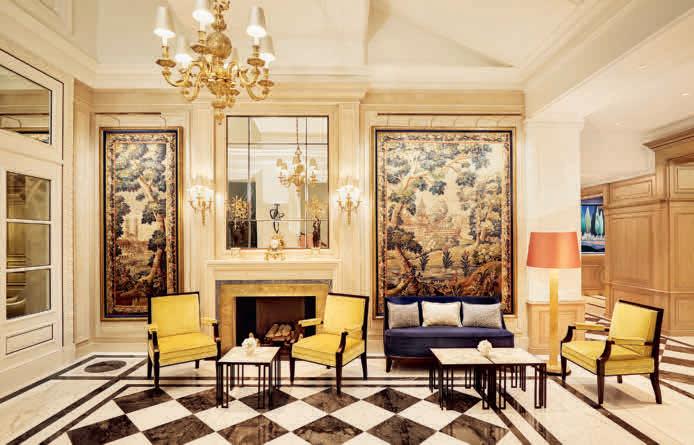
Jedes kleine und grosse Detail wurde im Zuge der Renovierung perfektioniert.




On the watch of Andrea Kracht, sixth-generation owner of the Baur au Lac, this oasis of tranquillity has seen no let-up in terms of ongoing renovation. Though always undertaken while the hotel is in service, the work of modernisation is barely noticed by guests. The objective, every time, is simple: to powerfully underscore the hotel’s claim to being one of the best in the world.
The most recent transformation is a case in point: It took barely ten months to complete a facelift that literally revamped the entirety of the hotel’s ‘first impression’, from the wrought-iron gate to the carpeting in the stairwells. Even the tiniest detail was minutely inspected and, where necessary, reforged, upholstered, repainted or updated with more modern fabrics. The terrace feels fresher but has lost none of its flair. Italian granite with a green lustre adds an impressive new dimension to the driveway. In the lobby and reception area, every one of the listed and historical wood panels has been gently and lovingly restored by local artisans. Even the antique tapestries now glow with fresh vitality. The fireplace has been treated to a splendid stone facing made of pierre de France. But the real head-turner is an original work by Nicolas Party – a reflection of the Kracht family’s own passion for contemporary art, which again accentuates Johannes Baur’s visionary philosophy. A hundred and eighty years on, Baur would, no doubt, still instantly recognise his hotel.

Unter der Ägide von Andrea Kracht, Besitzer des Baur au Lac in sechster Generation, hat das so viel Ruhe in sich tragende Haus in Sachen Renovierung – stets im laufenden Betrieb, doch selten für die Gäste spürbar – keine Pause eingelegt und dabei seinen Anspruch, zu den weltweit Besten zu zählen, kräftig unterstrichen.
Das zeigt ganz besonders das Ergebnis der neuesten Transformation. Gerade mal zehn Monate dauerten die Arbeiten, welche den kompletten »ersten Eindruck« ins Visier nahmen. Angefangen vom schmiedeeisernen Eingangstor bis zu den Teppichen auf den Treppen wurde jedes kleine und grosse Detail überprüft und bei Bedarf neu geschmiedet, gepolstert, lackiert oder seine
Textur in die Moderne versetzt. Die Terrasse fühlt sich bei gleichbleibendem Flair frischer an, die Auffahrt beeindruckt jetzt mit grün schimmerndem Granit aus Italien. Im Lobbyund Rezeptionsbereich wurden sämtliche historischen, unter Denkmalschutz stehenden Holzvertäfelungen von lokalen Handwerkskünstlern behutsam restauriert, die antiken Wandteppiche erstrahlen in neuem Glanz. Das Cheminée bekam eine prachtvolle Steinverkleidung aus »Pierre de France«. Absoluter Blickfang ist indes das Original Kunstwerk von Nicolas Party mit dem Familie Kracht auch ihre Passion für zeitgenössische Kunst einfliessen lässt und Johannes Baurs visionäre Prägung für das Haus neu zur Geltung bringt. Er würde sein Hotel auch nach 180 Jahren sofort wiedererkennen.
31
For regulars a home from home, as ever; for first-time visitors a pleasant surprise.
Für Stammgäste bleibt es ein Zuhause, für Erstbesucher eine Überraschung.
The tried and trusted is preserved, the new adeptly and harmoniously slotted in.

Altes wird bewahrt und Neues in gekonnter Harmonie hinzugefügt.
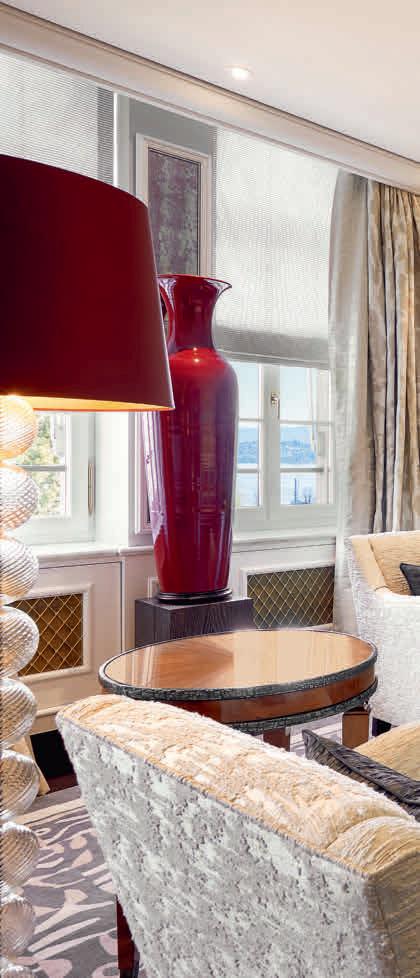
32 VIEWS MAGAZINE
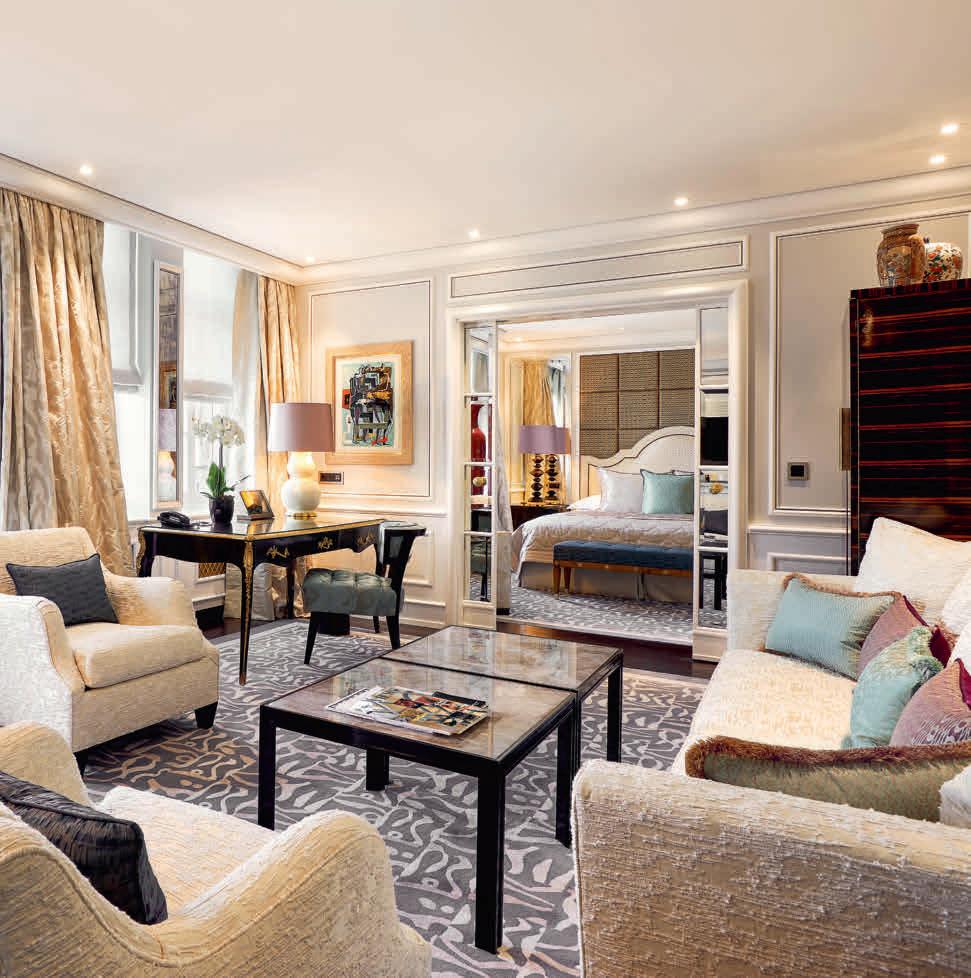
33









34 VIEWS MAGAZINE









35
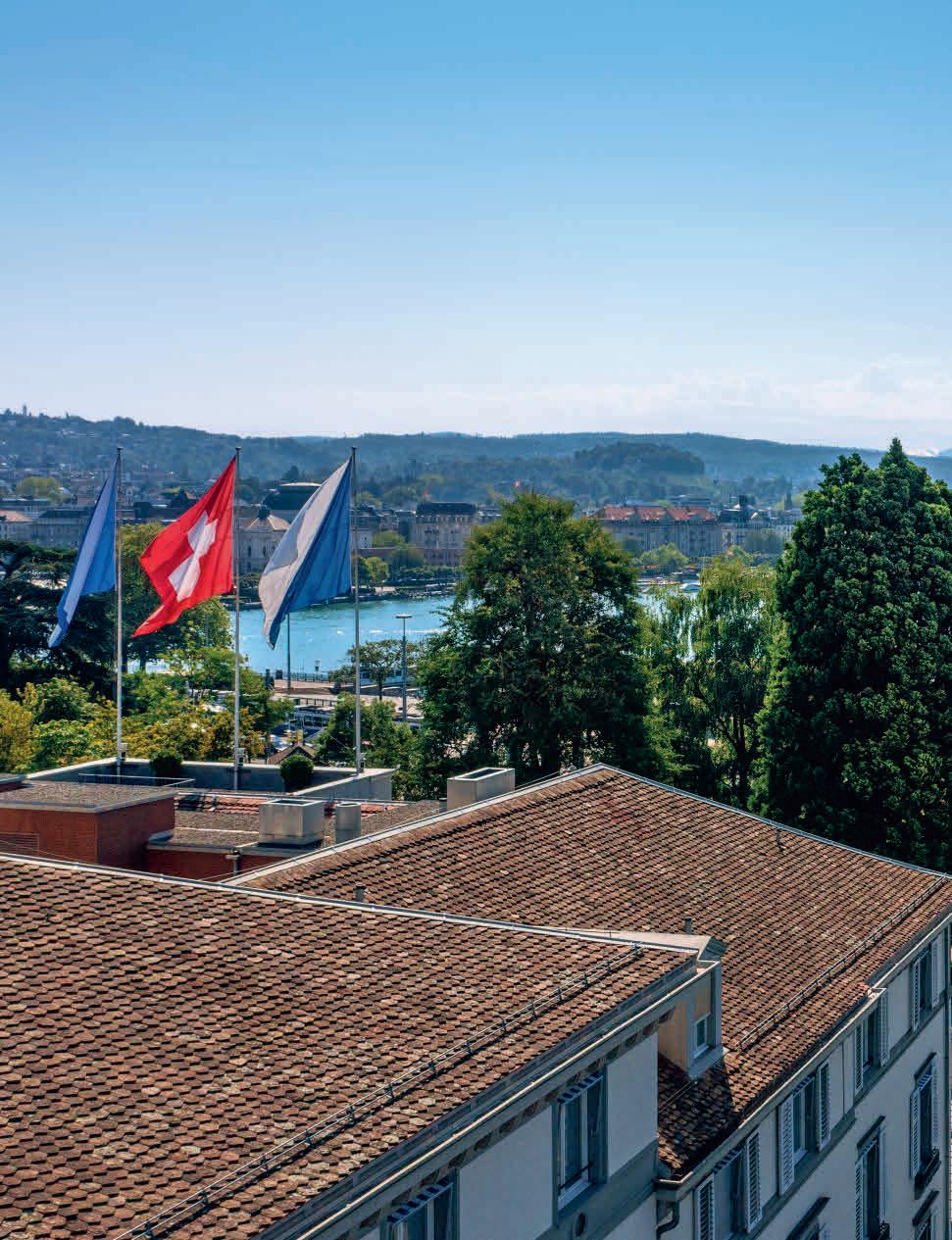



The park and terrace: where the living is easy




So, what is the best part of the day in Zurich?
It’s hard to say. If we might venture a suggestion, though? Spend a little time on the Baur au Lac terrace, under the imposing royal blue canopy which keeps off the heat of the sun and the occasional drop of rain. The dim sum ‘Chef’s Selection’ is a tasty summer snack indeed, as is the organic salmon tartare, or the superfood plate with wild broccoli, pomegranate and quinoa. And no, it doesn’t always have to be caviar. Although, sitting here and taking in the lakeside view and the Alpine panorama: Why not? Head sommelier Marc Almert has once again curated an exquisite wine list, while cocktail drinkers too will find plenty to their taste. And who would ever be averse to an aperitif among the olive trees and the scent of rosemary? Enjoy the summer!
Schwer zu sagen, wann der Tag am schönsten ist. Ein Vorschlag: bei einem Besuch auf der Baur au Lac Terrasse. Unter dem imposanten königsblauen Schirmhimmel, der vor der Sonne oder vereinzelten Regentropfen schützt, verheissen die Chef’s Selection Dim Sum, das Bio Lachs Tatar oder die Superfood Plate mit wildem Brokkoli, Granatapfel und Quinoa einen herrlichen Sommer-Snack. Und nein, es muss nicht immer Kaviar sein, aber hier mit Blick auf den See und das Alpenpanorama darf es. Gerne sogar! Chef-Sommelier
Marc Almert hat wieder eine erlesene Weinkarte kuratiert und auch Cocktail-Liebhaber kommen auf ihre Kosten. Und wer möchte nicht den Apéro zwischen Olivenbäumen und dem Duft von Rosmarin geniessen? Enjoy the summer!
38 VIEWS MAGAZINE

Baur's: whatever you want it to be
To step inside Baur’s Bar is to soak up the flair of the »roaring ’twenties«, when Art Déco first brought floral forms and vivid colours indoors. Red velvet sofas promise a cosy, enjoyable evening – on your own, as a couple or in the company of friends. Original photos by Annie Leibowitz contrast with patterned fabric panelling and compete with overhanging Murano-glass chandeliers. At the bar, talking shop about cocktails with the barkeeper is always an enjoyable pastime.
Wer die Baur’s Bar betritt, fühlt das Flair der »Années folles«, als Art Déco dem Interieur elegante rankende Formen und starke Farben bescherte. Samtrote Sofas laden zu einem gemütlichen Abend allein, zu zweit oder unter Freunden ein. Originalfotos von Annie Leibowitz kontrastieren die gemusterten Stoffpaneele und konkurrieren mit dem ausladenden Muranoglasleuchter – an der Bar darf man gerne mit dem Barkeeper über Cocktails fachsimpeln.


40 VIEWS MAGAZINE
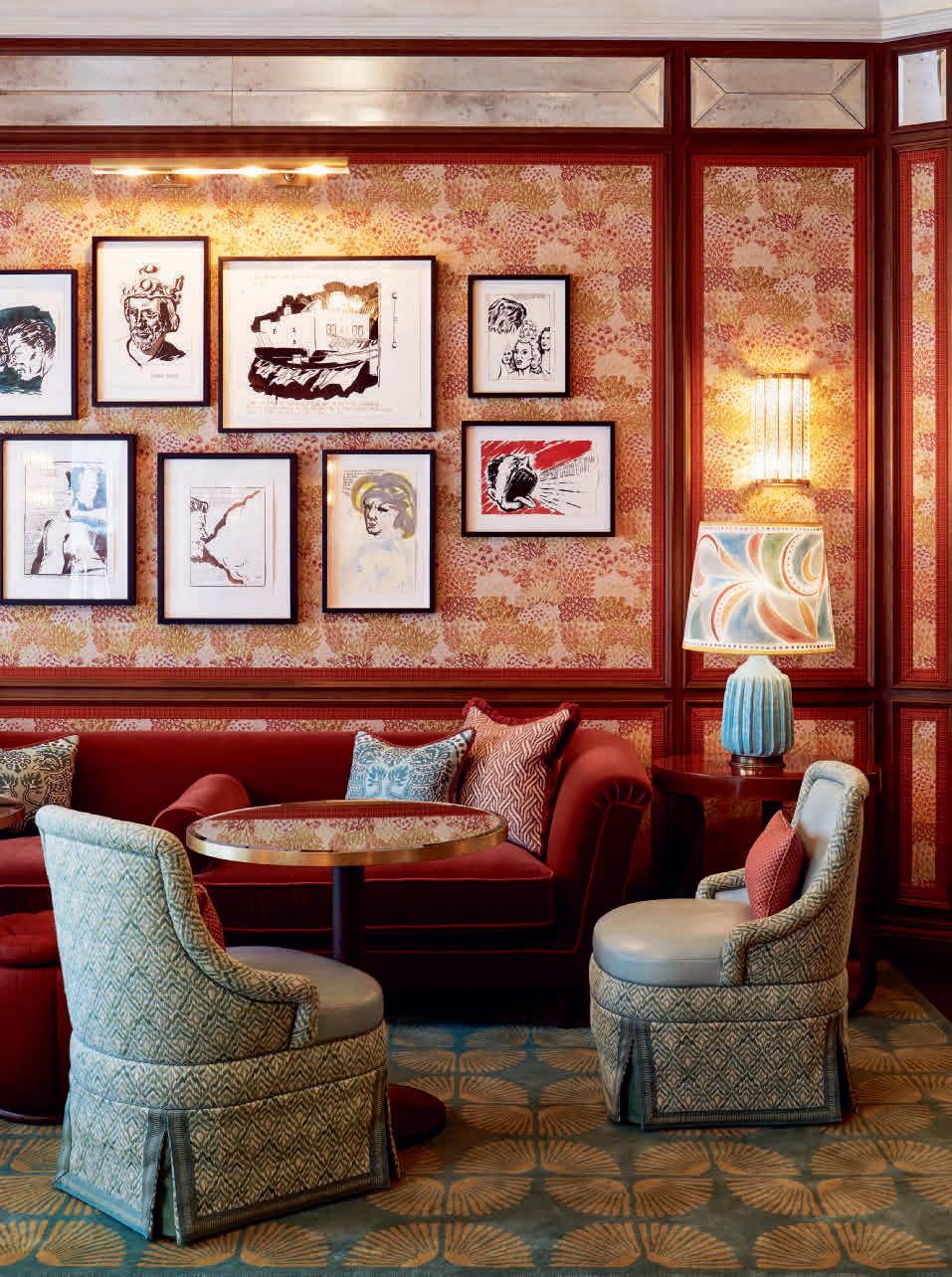
Your personal pitstop with Mark Arnall

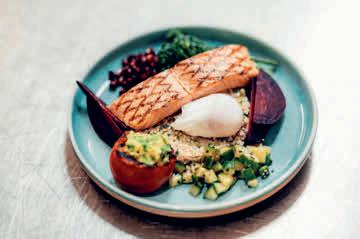



Every year, Formula 1 grand prix are hosted in 23 countries around the globe. And routinely criss-crossing time zones was perhaps the biggest challenge for performance coach Mark Arnall, who spent 20 years keeping world champions such as Sebastian Vettel and Kimi Räikönnen in good shape – which primarily meant free from jetlag – for the whole season. Today, guests at the Baur au Lac can make good use of Arnall’s expertise. Finding the sweet spot between travel preparation, actual travel and recovery is at the core of his program. Recipes aligned with his nutritional concept are prepared in situ by the hotel’s chefs.
In 23 Ländern rund um den Globus wird die Formel 1 jährlich ausgetragen. Dieser Ritt durch die Zeitzonen war wohl die grösste Herausforderung des Performance-Coachs Mark Arnall, der zwanzig Jahre lang Weltmeister wie Sebastian Vettel oder Kimi Räikkönen fit, heisst vor allem Jetlag-frei, durch die Saison bringen musste. Seine Expertise gibt er nun an die Gäste des Baur au Lac weiter. Mark Arnalls Programm basiert auf einem perfekten Zusammenspiel von optimaler Reisevorbereitung, Training und Erholung. Die Rezepte zu seinem Ernährungskonzept werden von den Köchen des Hauses vor Ort zubereitet.

42 VIEWS MAGAZINE




The Salzls may have been growing wine since 1840, but the latest three generations, headed by son Christoph, are bound together by more than family ties: They also share a pure, unadulterated passion for viticulture.





Seit 1840 bauen die Salzls Wein an. Die heutigen drei Generationen unter der Leitung des Sohnes Christoph, verbindet dabei nicht nur das Familienband, sondern auch die pure Freude und Leidenschaft für den Weinbau.
OUT OF AUSTRIA


The Lake Neusiedl National Park is home to grey cattle, water buffaloes, Przewalski horses, white donkeys and other old breeds of domestic animals.

Der Nationalpark Neusiedler See ist Heimat für alte Haustierrassen wie Graurinder, Wasserbüffel, PrzewalskiPferde und weisse Esel.
»Where wine is grown, the landscape is beautiful, the people are nice and the food is fantastic.« Together with his wife Verena, Christoph Salzl is the third generation of his lineage to take charge of the family-owned Salzl Seewinkelhof estate in Illmitz in the Austrian province of Burgenland. »Beautiful« is an apt, if far from satisfactory, description of the local countryside. Let’s start with the unexpected fact that the estate is situated in the lowest-lying part of Austria. Visitors arriving with notions of towering mountains or the cosmopolitan buzz of Vienna must first accustom their eyes to a vast expanse of steppes, the scorching heat of long summers and warm autumn days, though the wind can also be chilly. As Salzl himself puts it, the region is »like the African wilds without the lions.« In these parts, blue-eyed, snow-white donkeys and archaic steppe cattle have to make do.
What makes this UNESCO World Heritage region so unique are its salt lakes: shallow depressions in the landscape fed by a gigantic subterranean and mineral-rich body of water. In the winter months, rainwater fills them ankle-deep. In the summer, they dry out, exposing fissured beds on which pure white salt effloresces. Locals speak – fittingly – of »soda snow«.
The wind spreads this powdery snow across the surrounding vineyards, giving the wines an added elegance, zest and, above all, the salty mineral flavour that characterizes all the wines here. Sand washed up from Lake Neusiedl, gravel from the Danube and black earth – the legacy of what was once a littoral of the Pannonian Sea – cause the soil to shimmer alternately from rusty red to beige, from white to black. The combination also makes it light and porous, adding a distinctive warmth and softness to local wines. Following a strategic decision taken four decades or so ago by Christoph’s father Joseph, red wines dominate the family’s 80 hectares of vineyards, accounting for roughly three-quarters of all Salzl wines today. The principal variety, typically for this region, is Zweigelt, which enjoys perfect conditions under the influence of the nearby lakes and countless hours of sunshine. This is a special terroir indeed. The most widely cultivated variety in Austria, Zweigelt boasts a charming character, fruity aromas and soft tannins. Alongside Blaufraenkisch, the second indigenous grape, Cabernet Sauvignon, Merlot and Syrah add an international flair. On the white wine front, Chardonnay calls the shots.
»Wo Wein angebaut wird, ist die Landschaft schön, sind die Leute nett, die Kulinarik super.« Christoph Salzl verantwortet in dritter Generation zusammen mit seiner Frau Verena den Familienbetrieb Salzl Seewinkelhof in Illmitz im Burgenland. Mit »schön« ist ebendiese Landschaft durchaus treffend, jedoch reichlich ungenügend umschrieben. Das fängt mit dem unerwarteten Umstand an, dass das Weingut in der tiefstgelegenen Ortschaft Österreichs liegt. Wer das Land bisher primär mit hohen Bergen oder der Weltmetropole Wien in Verbindung gebracht hat, wird die Augen an eine immense Weite gewöhnen müssen, an Steppenlandschaft, sengende Hitze in langen Sommern, warme Herbsttage, aber auch kühle Winde. Oder, um es mit Christoph Salzls Worten wiederzugeben: »Wie das Outback von Afrika, nur ohne Löwen«. Dafür, so darf hier angefügt werden, mit blauäugigen weissen Eseln und archaischen Steppenrindern.
Die Besonderheit dieser UNESCO Welterberegion sind die Salzlacken – flache Vertiefungen in der Landschaft, gespeist von einem gigantischen unterirdischen Mineralwassersee. In den Wintermonaten füllen sie sich knöcheltief mit Regenwasser, im Sommer trocknen sie aus. Dabei hinterlassen sie rissige Lackenböden, auf denen sich weisse Salzausblühungen – treffenderweise auch Sodaschnee genannt – bilden. Indem sie sich mit dem Wind über die umliegenden Weingärten verteilen, geben sie den Weinen zusätzliche Eleganz, Frische und vor allem eine salzige mineralische Note, die sich besonders stark in den Süssweinen ausprägt. Sand, angeschwemmt vom Neusiedler See, der Schotter der Donau und die hier im ehemaligen Ufergebiet des pannonischen Meers entstandene Schwarzerde, lassen den Boden nicht nur zwischen rostrot, beige, weiss und schwarz changieren, sondern machen ihn auch leicht und durchlässig, geben so den Weinen ihre einzigartige Wärme und besondere Weichheit.
46 VIEWS MAGAZINE
Auf der achtzig Hektar grossen Rebfläche der Familie dominieren Rotweine – eine grundlegende Entscheidung, die Vater Josef vor rund vierzig Jahren eingeleitet hat und die heute rund 75 Prozent der Salzl’schen Weine ausmacht. Die Leitrebsorte ist der regionaltypische Zweigelt, der unter dem Einfluss des Seewinkels mit seinen vielen Sonnenstunden geradezu ideale Bedingungen vorfindet und das besondere Terroir ergibt. Diese meistangebaute Rotweinsorte Österreichs begeistert mit ihrem charmanten Charakter, fruchtigen Noten und weichen Tanninen.
Neben der zweiten heimischen Rebsorte, dem Blaufränkisch, sorgen auch Cabernet Sauvignon, Merlot und Syrah für eine internationale Stilistik. Beim Weisswein ist der Chardonnay die tonangebende Sorte.

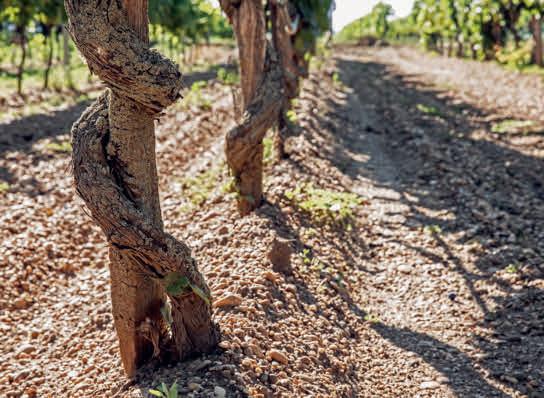
The Salzl family today tends about 80 hectares of vineyards. Their focus is on producing red wines known for their softness and warmth – typical attributes of the Seewinkel locality.





Derzeit bewirtschaftet Familie Salzl eine Rebfläche von ca. 80 Hektar. Der Fokus liegt auf der Produktion von Rotweinen, die für ihre Weichheit und Wärme bekannt sind – typische Eigenschaften für den Seewinkel.
PANNONIAN POTION

Christoph Salzl is chairman of the DAC (Austria’s equivalent of appellation d’origine contrôlée, or AOC) for the Lake Neusiedl region and an ambassador for all things to do with Zweigelt. He is convinced that, given the development of a suitable DAC Reserve quality standard, the wine can certainly mature for ten years. On this point, Salzl draws a comparison with the classic white Grüner Veltliner, which is »similarly versatile and convincing at every level of quality, from the plain and simple to the grand vin.«
In

prepared the ground for the success of the family business today. His son Christoph got involved in 2005.
In den 1980er Jahren setzte Josef Salzl mit der Neuakzentuierung Richtung Rotwein den Grundstein für den heutigen Erfolg des Familienbetriebs. 2005 stieg Sohn Christoph mit ein.
BAUR AU LAC VINS
HEADQUARTERS & FLAGSHIP STORE
Adlikerstrasse 272, CH–8105 Regensdorf
Phone: +41 44 777 05 05
HOTEL SHOP

Börsenstrasse 27, CH–8001 Zurich
Phone: +41 44 220 50 55
HAUPTBAHNHOF SHOP
ShopVille, CH8001 Zürich

Phone: +41 44 212 50 50






MÄNNEDORF SHOP
Seestrasse/Dorfgasse 46, CH–8708 Männedorf
Phone: +41 44 920 07 47






TIEFENBRUNNEN SHOP
Bellerivestrasse 263, CH–8008 Zürich

Phone: +41 44 777 05 90
www.bauraulacvins.ch












When he took the reins of the company in 2005, the young vintner wasted no time in demonstrating both this conviction and his own abilities, vinifying a monovarietal Zweigelt bursting with vigorous fruitiness. SACRIS – a play on words derived from his initials, SA-lzl ChRIS-toph – has been a top-of-the-range Salzl product ever since. Its optimal blend of typical cherry fruit and salty minerality have given it a tenured slot on national and international wine cards alike. Maturing for nearly two years in small oak barrels, Sacris perfectly encapsulates the vitality of the sun and the warmth of the Pannonian lowlands.

Christoph Salzl ist Obmann des Vereins Neusiedlersee DAC und Botschafter in Sachen Zweigelt, der – so seine Überzeugung – bei entsprechendem Ausbau als Neusiedlersee DAC Reserve durchaus zehn Jahre reifen kann. Salzl zieht an der Stelle den Vergleich mit der weissen Paradesorte Grüner Veltliner, der »ähnlich vielseitig ist und vom unkomplizierten bis zum grossen Wein auf allen Qualitätsstufen überzeugen kann«.
Mit SACRIS – ein Wortspiel aus seinen Initialen SAlzl ChRIStoph – hat der junge Winzer 2005 mit der Übernahme des Familienbetriebs sogleich diese Überzeugung und sein Können unter Beweis gestellt und einen reinsortigen Zweigelt voller Frucht und Kraft vinifiziert. Bis heute steht Sacris an der Spitze der Produktpalette aus herausragenden Weiss, Süss und eben Rotweinen und ist in seiner perfekten Kombination aus typischer Kirschfrucht und salziger Mineralität von nationalen und internationalen Weinkarten nicht mehr wegzudenken. Sacris spiegelt die Kraft der Sonne sowie die Wärme der pannonischen Tiefebene perfekt wieder und reift für knapp zwei Jahre in kleinen Eichenholzfässern.
48 VIEWS MAGAZINE
shifting the emphasis to red wine back in the 1980s, Josef Salzl

ALPA.SWISS Neptunstrasse 96 / 8032 Zürich
MAKE IT LOVE IT COLLECT IT
SUNSHINE'S NOOK
BY GIGI O. KRACHT
ART IS ALL AND ALL IS ART
Art is always – has always been – an affair of the heart. For some, the creative process is an irresistible urge, an all-consuming passion. Others drop their jaws and stand in awe at the sublime works of the former. They could maybe never produce it themselves; but they feel it, reverberating, echoing, calling to somewhere very deep inside. Still others are driven to preserve art for posterity, making accessible what is out of reach of so many. Over the past year, I have had the privilege of meeting with and getting to know so many stand-out individuals, each with a unique personal touchpoint for the art that is the love of my own life. So, step inside, read on and meet a few of them for yourself…

50 VIEWS MAGAZINE
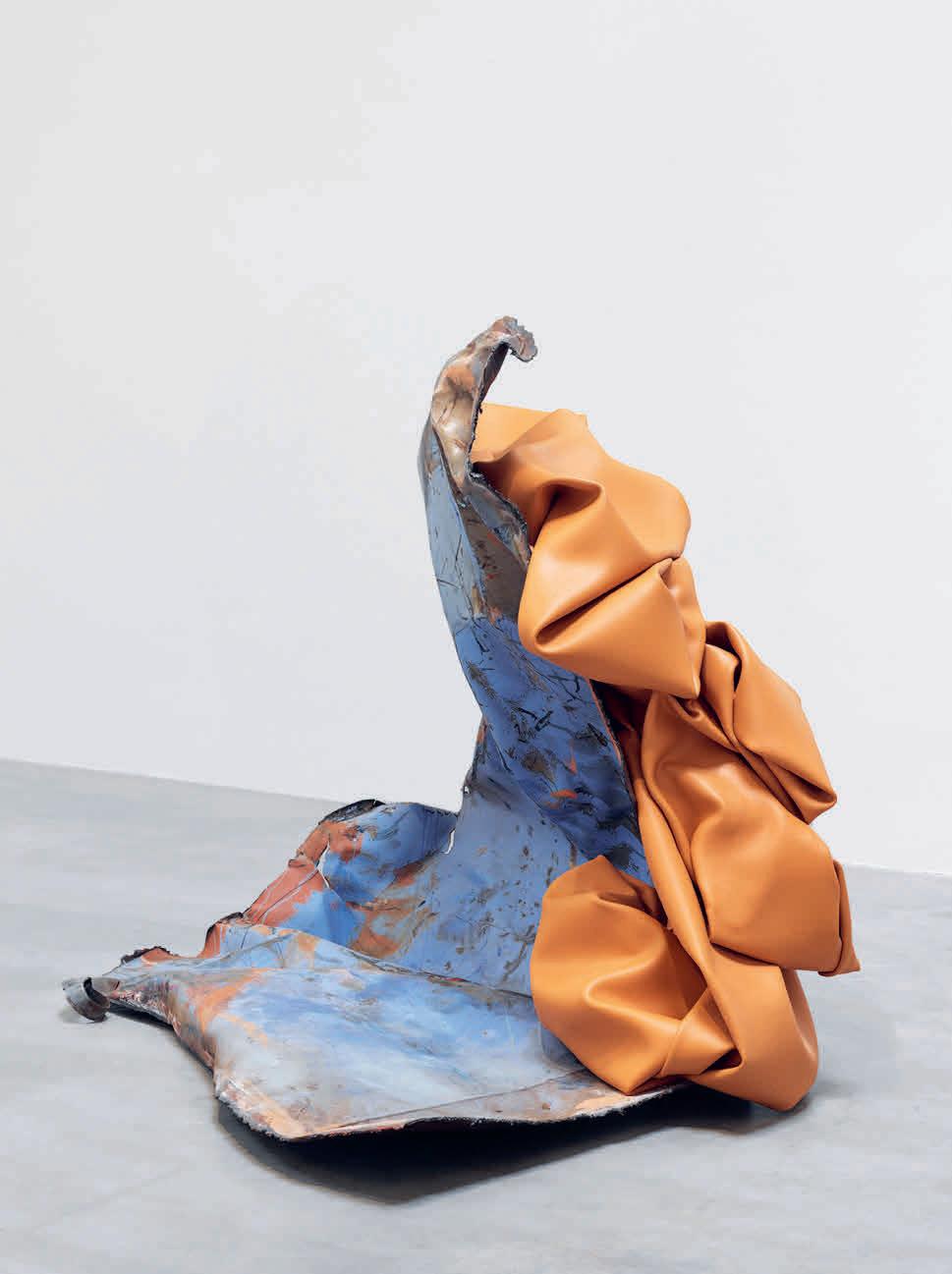 KENNEDY YANKO
Photos by Genevieve Hanson. Courtesy of the artist and Jeffrey Deitch, New York.
KENNEDY YANKO
Photos by Genevieve Hanson. Courtesy of the artist and Jeffrey Deitch, New York.
KENNEDY YANKO
Who should recently have been listed as one of the most profoundly exciting and sought-after young artists in the current generation but Kennedy Yanko?

The former yoga teacher has developed a peerless method in the space between painting and sculpting, employing repurposed metal and paint skins in a manner perhaps best described as gravity-defying alchemy! Esoteric as this may sound, the ‘production process’ is more prosaic – and nothing if not strenuous. To create her skins, the artist pours industrial-strength paint onto tarp-covered ground and peels it off again when it is dry. Next, she attaches the skins to the metal armatures she so painstakingly torches, welds and bends. Some of her works – »Agate« being a prime example – take on an anthropomorphic quality, subtly addressing the conflict which so often rages between human perceptions and societal expectations.
Kennedy Yanko, born in St. Louis, Missouri, in 1988, lives and works in Brooklyn, New York. Her works have been exhibited internationally, her huge installations gracing shows from the Brooklyn Museum to Art Basel Unlimited in 2022, the Albertina Museum in Vienna in 2023 and the Kentucky Museum of Art and Craft. In 2021, she spent a period perfecting her methodology as artist-in-residence at the Rubell Museum of Art in Miami.
Getting where you are today must have been a wild ride, Kennedy. I send you my congratulations and my profound admiration!

52 VIEWS MAGAZINE
Photos by Genevieve Hanson. Courtesy of the artist and Jeffrey Deitch, New York.
Photo by Sofia Johansson
While others brandish brushes and easels, Kennedy Yanko produces gravity-defying alchemy with welding torches and tarpaulins.
Now-Brooklynite artist Amy Feldman was actually born in Windsor, New York State, on April 23, 1981. Her iconic paintings invite the viewer to join a challenging conversation around the physical and formal languages of abstraction expressed in her grey-on-grey works. Armed with this consistently minimalist palette, Feldman has stripped decoding down to the bare bones and, in doing so, conjured up an uncanny focus on neutrality. To the uninitiated, the idea of grey, grey and more grey may sound drab and uninspiring; but only until the almost subliminal force of her circles and shapes bursts through, itself conveying a clear statement on how signs and imagery are interpreted, remembered –and indeed misremebered!
Working from small doodles made with a marker at her Brooklyn studio, Feldman completes a painting in a single serious session. She hardly revises her works at all when they are done. When made aware of this allor-nothing art-making process, viewers are struck by an unexpectedly performative feel, a weighty sense of the dizzying proximity of success and failure.
Feldman’s works are by no means expressive in the conventional sense. Rather, the dull sheen of her acrylic paints coupled with an almost dogged reliance on what could be regarded as nondescript mid-greys actually conceals aspects that are there to be found if anyone looks hard enough. To my mind, the artist avails herself of a kind of visual
Zen signal which is perceptible to anyone, though the immediate viewer may first have to take a step back…
Feldman received her bachelor of fine arts from the Rhode Island School of Design and her master’s degree from Rutgers University. To date, she has exhibited in Berlin, San Francisco, Chicago, Milan, Stockholm, New York and even the Eva Presenhuber Gallery in my native Zurich. She has variously received the Joan Mitchell Foundation Grant in 2013; the John Simon Guggenheim Memorial Foundation Fellowship in 2018; and the Pollock-Krasner Foundation Grant in 2021.

Dear Amy, what Michael Wilson has called the »bulbous, bouncy, exuberant forms« in your pictures are truly spectacular in any artistic vernacular. To view your work is a gift from heaven! More of the same, please!

AMY FELDMAN
Photos by Bjorn Iooss
Who needs 50 shades of the stuff when two or three will do?! Amy Feldman’s acrylics give voice and presence to a largely overlooked colour.
CAMILLE HENROT
Henrot has been presented with the 2014 Nam June Paik Award and the 2015 Edvard Munch Award. Her works have been acquired by the Guggenheim Museum, the Hirshhorn Museum, the Sculpture Garden, the Los Angeles County Museum of Art, the Museum of Modern Art and the Pinault Collection. Need one say more?
One stellar trailblazer in the world of contemporary sculpture is French-born artist Camille Henrot, whose body of work, according to the artist herself, »deals with the different strategies humankind has invented to deal with desire, frustration, the fear of death and exhaustion«. At Art in the Park XX, Henrot showcased her versatility and creative force in five sculptures that vacillated between visceral depictions of the postpartum body and more imaginative renderings verging on the monstrous and non-human. »There is beauty to sagging flesh,« the artist explains. »The figures seemed to be disintegrating. Yet they also stand tall like a kind of soldier or a weapon. The
»private individual and a global citizen in a connected and overstimulated world«. Henrot studied at the École National Supérieure des Arts Décoratifs, the decorative arts school in France where she specialised in animation. After graduating, she moved to the Big Apple and initially worked as assistant to another French artist, Pierre Huyghe. Her videos caught the attention of the art world, prompting her to venture into longer film formats. And her big break came when Massimiliano Gioni incorporated her video Grosse Fatigue in his Encyclopedic Palace concept at the Venice Biennale in 2013, where she won the Silver Lion Award for promising young artists.
A few highlights of her numerous solo exhibitions worldwide include the New Museum, New York; the Schinkel Pavilion, Berlin; New Orleans Museum of Art; Fondazione Memmo, Rome; Tokyo Opera City Art Gallery, Japan; and the National Gallery of Victoria in Melbourne, Australia. Current and upcoming solo exhibitions include »Mouth to Mouth« at the Munch Museum in Oslo, Norway (2022-23); a show at the Lokremise in St Gallen, Switzerland (2023); and another one at the Fondazione ICA in Milan, Italy (2023). Camille Henrot lives and works in New York City.
emptied breasts are sharp like knives!«
Over the past two decades, the native Parisian has developed an acclaimed practice which encompasses not only sculptures but also painting, drawing, film and installation, all of which is informed by a distinctly playful research process. She takes poetry, cartoons, literature, even the banality of everyday life as her inspiration. Her work mirrors the complexity of living as both a
Inspired by Bambara masks from Mali, Henrot went on to fashion sculptures out of car parts. Throughout her assorted media, the artist explores globalisation, the digital realm and issues of anxiety. Despite the serious nature of her subject matter, her works are invariably tinged with humour, wit, anthropological sensibility and a disarmingly gentle charm.
Camille, you have become an influential voice in the contemporary art world, ever striving to reach even higher ground. Having your sculptures in our park unleashed a whole gamut of emotions in me, from anger to unabashed tenderness. I really have no words to explain your works! Bravo, Camille!

54 VIEWS MAGAZINE
Photo by Josep Fonti
Henrot’s work mirrors the complexity of living as a »private individual and a global citizen in a connected and overstimulated world«.
Anyone who knows the name Tschabalala Self will not be surprised to find her in these pages!
An American artist born in Harlem, New York, on May 12, 1990, she attended the neighbourhood public school, studying for a bachelor’s degree at Bard College in 2012 before earning her master of fine arts degree in painting and printmaking from Yale. Today, she lives and works in New York and New Haven, Connecticut.

Tschabalala Self is deeply engaged in reimagining black female figures, often amid multiple patterned planes and bright, solid blocks of colour. Though she builds her kaleidoscopic canvases through a bricolage of printmaking, sewn textiles and collage-like cut-outs, most of her works identify primarily as paintings. The outcome? Avatars rather than individuals – but avatars that definitely depart from expected norms.
While this medium is her mainstay, she does make exciting excursions into sculpture and installation. Self’s art has been exhibited in New York, London, Berlin, Naples, Brussels and San Francisco, and is on display in the collections of the Astrup Fearnley Museum in
TSCHABALALA SELF
Oslo, the HOW Art Museum in Shanghai, the Hammer Museum in Los Angeles, the LUMA Foundation, the Perez Art Museum in Miami and the Yuz Museum in Shanghai. To date, the artist has held residences at the American Academy in Rome, the La Brea Studio in Los Angeles, T293 in Naples, Italy, and the Red Bull House of Art in Detroit. Self’s unconventional use of materials subverts the status quo, highlighting the unique shapes of each body and creating unusual points of emphasis. Some of her works are sexually explicit. Notwithstanding, the black female bodies in her work are often described as nonbinary or genderless – perhaps simply because they do not conform to
the Westernized concept of beauty that is still so widely predicated in the world of art. Tschabalala Self is keen for her art to challenge received social wisdom. While shying away from stereotypes and generalisations about the black female body, her practice clearly absorbs elements of accepted fantasies and attitudes. The artist herself calls her works »celebratory in nature« despite their »destructive rhetoric«.
Tschabalala, it was so much fun speaking with you. I love it that the women depicted in your works show vulnerability but carry no shame. They are as uninhibited as the exuberant style of your paintings themselves!
Courtesy the artist and Pilar Corrias, London.
Photo: Daniel Gurton.
Are Self’s bodies »nonbinary or genderless« simply because they do not conform to the Westernized concept of beauty?
have also risen to prominence, of course, but traditional markets such as the Merced still bustle with hawkers of live chickens, tortillas and charcoaled corn-on-the-cob. Chapultepec Castle, the Independence Monument, the Pemex Fountain and countless other memorials attest to past dreams and future aspirations amid a chaotic web of avenues congested with interminable lines of honking cars, of endless neighbourhoods built on the dry bed of Lake Texcoco.
FRIDA KAHLO

Mexico City has been described as a »nexus of muralism, modernism and the revolutionary and communal thinking behind both movements«. It stands up to comparison with New York City, Shanghai and Mumbai in many ways. One difference, however, is that this vast metropolis is home to fully one fifth of Mexico’s total population, representing one of the world’s most significant ratios of capital-to-national inhabitants. Its crammed citizenry has yielded an unparalleled concentration of power and wealth for the urban elite, though not for the denizens of its sprawling shanty towns and lower-income neighbourhoods.
The country’s rich heritage is nevertheless clearly visible on local streets, in magnificent colonial-era churches, amid the ruins of the main Aztec temples, in the mix of 19th-century French-style mansions, but also in the marble shopping malls one would perhaps expect to find in Beverly Hills. Supermarkets
On one visit to this remarkable city with my Guggenheim group, the first item on our agenda was to visit Frida Kahlo’s Casa Azul Magdalena Carmen Frida Kahlo y Calderon was a self-taught Mexican painter who became one of the most world-renowned Latin American artists. She was known above all for her conflicted self-portraits and rebellious works influenced by the nature and artifacts of Mexico and Marxism. Located in the Colonia del Carmen neighbourhood of Coyoacán, the striking cobalt-blue structure where Kahlo lived and took her last breath with her husband, Diego Rivera, was built in 1904 by the architect Juan O’Gorman. Once rather diminutive in size, it is now a 2,625-square-foot edifice. Diego and Frida filled it with strong colours, folk art and pre-Hispanic pieces to show their admiration for the people and culture of Mexico. The interior has been maintained virtually intact.
Since 1958, four years after Kahlo’s death, the ten-room house has operated as the Frida Kahlo Museum. Intellectual and avant-garde activities remain its lifeblood to this day, and it is a gem to behold. Would I go back to see Kahlo’s Casa Azul again? Without a moment’s hesitation…

May the reader enjoy the few snaps I took. Perhaps they will inspire you, too, to visit or revisit this historical, magical blue house sometime soon!

56 VIEWS MAGAZINE
Born of a lifetime of suffering, Kahlo’s famous Casa Azul lives on and continues to host a buoyant celebration of all that is Mexican.
Gigi O. Kracht
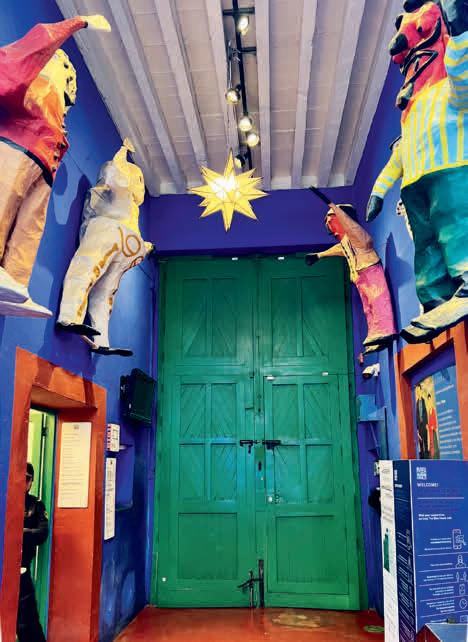














AGUSTIN & ISABEL COPPEL
Agustin Coppel is a son of Enrique Coppel Tamayo, who built a Mexican retail empire targeted at low-income shoppers. The family’s youngest child, he was born in Culiacán, Mexico, on August 28, 1961. He today serves as chairman and chief executive of his father’s holding company, Grupo Coppel. Together with his brothers, he also maintains interests in a bank, a retirement fund management company and real estate.
Coppel and his beautiful wife have assembled the Isabel and Agustin Coppel Collection (CIAC), one of Mexico’s most remarkable bodies of contemporary art. Alongside works by indigenous artists of the calibre of Francis Alys, Gabriel Orozco, Melanie Smith, Abraham Cruzvillegas and Damian Ortega, it also features pieces by an endless stream of global names, from Gordon Matta-Clark and Terence Koh to John Chamberlain and Luc Tuymans. The CIAC is a non-profit association with a mission to promote contemporary art and make it more accessible to the general public.


In 2011, the Coppels lent 100 works from the collection to the Museum of Latin American Art and the Museum of Contemporary Art in San Diego, California, for a show called »Mexico: Expected/ Unexpected«. This stellar exhibition panned out across multiple media – painting, photography, installations, video art and sculptures – in a thought-provoking treatment of ideas as disparate as death and mortality, »Mexican-ness«, the poetry of craftsmanship and the uncertainties of everyday life.
It was an immense pleasure to meet you both – a pleasure I hope we will repeat again very soon!
58 VIEWS MAGAZINE
The Coppels have devoted their non-profit association to promoting contemporary art and making it more accessible to the general public.
Lorena Ruiz de Villa is an art historian who was born in Barcelona. As a young girl, she was used to seeing paintings and sculptures at her parents’ house. However, after graduating in art history in her home city and earning a master’s degree at the University of Manchester, she felt drawn to see more of the artistic world outside the confines of her own home, to find out what she liked, what she wanted and what her place was in this, her chosen field.
She seems to have found more than satisfactory answers in the meantime: Aside from her own collecting activities, Ruiz de Villa works as an art advisor and has personal dealings with a multitude of artists.

At her home in Madrid, which we visited with friends from Kunsthaus Zurich, she showed us an immense painting by Spanish artist Hermenegildo Anglada Camarasa (1871-1959), who lived in Paris and won the gold award at the Venice Biennale in 1907. Quite obviously, this painting has found its rightful home: It was meant to be in her fold!
I asked how she chooses a piece of art. »[It is] almost like love at first sight,« she replied. »It has to touch my heart. Once I feel the emotion, I delve into the career of the individual artist and, on attaining an overview of the artist's oeuvre, I arrive at a definitive answer.«
See you soon in Zurich, Lorena!
LORENA RUIZ DE VILLA
59
Photo: family archive
An avid collector and art adviser, Ruiz de Villa clearly believes in giving good art a good home.
CANDELA ÁLVAREZ SOLDEVILLA
Spain’s densely populated capital is the second-largest city in the European Union, with almost 3.6 million inhabitants and a metropolitan area nearly twice as populous. On a recent art trip there with Kunsthaus Zurich, we were privileged to view the private collections of Candela Álvarez Soldevilla and Lorena Ruiz de Villa.
A native of Asturias in northern Spain, Soldevilla is a lawyer by trade but also holds a degree in business. Besides her ‘day job’ – administering a group of companies and serving as director for a number of high-tech hotels – she has masterminded Studiolo to house and safeguard her personal art collection in Madrid (and as a popular meeting place for artists, writers and other creatives).
Soldevilla used her first salary to buy her first work of art from a small gallery on the Rive Gauche in Paris: an oil-painting of the Seine by a local artist. The transaction clearly whetted her appetite, as she has since accumulated 350 paintings, drawings, sculptures and photographs! Although drawn very much to the avant-garde, she also has a weakness for contemporary art in general and certain emerging artists in particular. Her impressive collection includes works by Leonard Foujita, Millares, Anish Kapoor, Louise Bourgeois, Barcelo, Tony Cragg and Tony Oursler, in addition to young artists such as Xavier Gonzalez Arnau, Ivan Cantos Figerola and photographer Javier Abella, all of whom she gladly supports.
Candela Álvarez Soldevilla is, in other words, an active collector who understands collecting as a public commitment with social purposes. In keeping with this ethos, she is a member of the board of directors of 9915 (the Association of Private Collectors of Contemporary Art in Spain), but also collaborates with private organisations such as the Lazaro Galdiano Foundation, the Royal Academy of Rome, the Santander, DKV and ABC Foundations and the Alcobendas Art Centre.
Meeting you was a wonderful treat and a sheer pleasure, dear Candela. I hope you’ll come and visit me soon in Zurich!
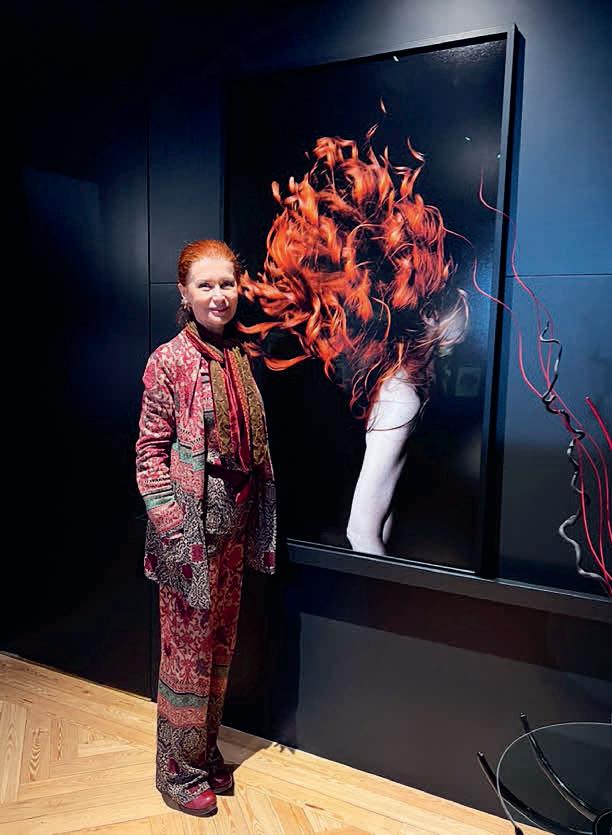
60 VIEWS MAGAZINE
For Candela Álvarez Soldevilla, collecting art is a public commitment with a clear social purpose.
Far more than a modern-day fashionista, Cindy Chua-Tay sits on some very serious boards!
Raised in Singapore, the city-state where she was born on March 23, 1970, Chua-Tay moved to the USA at the age of 17 to study for a bachelor’s degree in communication arts at the University of Wisconsin. Her ensuing career in fashion saw her work with the likes of Calvin Klein, Céline and Chaumet. Never one to limit her own horizons, however, she also plunged into a raft of cultural and art projects. As a pioneering member of the National Dance Company in her native country, she performed with the group before it became established as the Singapore Dance Theatre, the nation’s first professional ballet company. She was also affiliated with the Singapore Symphony Orchestra, where she conducted several gala benefit events.
Together with her husband Liam, Chua-Tay was honoured by the National Arts Council with a Patron of the Arts Award, given in recognition for exceptional philanthropy towards national arts programs.
The couple commutes between Hong Kong (where they currently live), New York (where they have an apartment) and Singapore (which aways fits in somewhere on their busy itinerary!). After joining the Guggenheim Museum in 2013 as a member of the International Directors Council, she was appointed two years later to its Board of Trustees, making her one of the youngest and also the first Asian board member at a foundation established in 1937.
In 2022, Chua-Tay was also appointed as a member of the Acquisitions Committee of the M+ Museum in Hong Kong, the first global museum of contemporary visual culture in Asia dedicated to collecting, exhibiting and interpreting visual art, design, architecture and moving pictures.
As a child, she remembers visiting the Guggenheim with her parents, standing in awe in the atrium, staring up through the rotunda with the natural light streaming through. Although she now sits on the museum’s board, she still repeats the same ritual, suffused with a keen sense of responsibility and ever reminding herself »how sacred and important it is to be in this role«.
Cindy Chua-Tay and her husband have been conscientious collectors of art for over 15 years, mostly gravitating towards Western contemporary genres.
Cindy, you are doing a masterful job at the Guggenheim. Maybe I will see you at one of our future IDC meetings or on a trip somewhere?
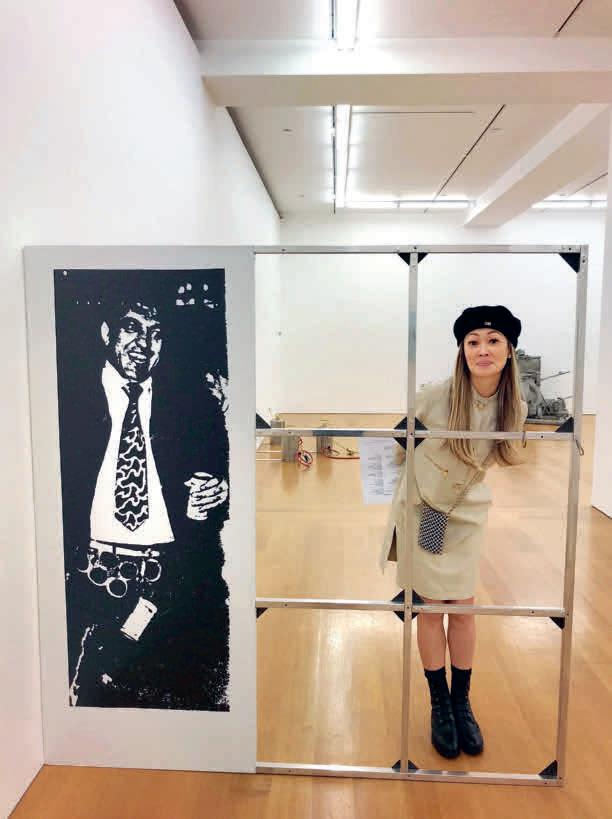
CINDY CHUA-TAY
61
A true global citizen with eclectic art interests, the native of Singapore today sits on the Board of Trustees at the very museum she once venerated as an awestruck child.
JAMES KOCH
Born in London on November 7, 1973, James Koch is an Executive Director and Partner at Hauser & Wirth – a gallery with which Art in the Park has collaborated closely and well in recent years. The Englishman’s remit at the pre-eminent Swiss art gallery is to oversee its spaces on Zurich’s Bahnhofstrasse and at a semi-private chalet in Gstaad. In his capacity as a lawyer, he »advises private clients on legal issues pertaining to the management of their financial portfolios and their art holdings«.
His background is indeed primarily legal. Koch studied law at the University of Zurich and the University of St. Gallen (HSG) before working for a leading Swiss law firm and later serving as director of a top executive search company. From my own experience, his business acumen and legal expertise can only be described as first-rate.
Yet alongside his professional interests in law, he has, in parallel, always maintained a passion for the arts and culture, even working for a time as assistant stage director at the Opera House in Zurich and the Royal Opera House in Covent Garden, London. He was also instrumental in establishing the museum-based music festival Les Musiques, for which he served as executive director.
It therefore comes as no surprise to find that, before joining Hauser & Wirth in 2014, Koch served as Managing Director of Fondation Beyeler, playing a key leadership role in continuing the success of this outstanding museum of modern and contemporary art after the passing of its founder Ernst Beyeler. To this day, Koch remains a member of the Board of Trustees of Fondation Beyeler. He is also Vice-Chairman of the Friends of the Zurich Opera.

James, working with you and your gallery has always been a wonderful experience. Long may it continue!

62 VIEWS MAGAZINE
Photo: Sven Germann
If ever there was a blueprint for a perfectly synched left and right brain, James Koch – a consummate legal professional with an intense affection for art and culture – would be its true embodiment.
Richard Armstrong has been Director of the Solomon R. Guggenheim Foundation since November 2008. His mandate takes in the eponymous museum in New York City plus the foundation’s other establishments throughout the world, including Bilbao, Venice and (soon to be completed) Abu Dhabi.

Widely loved as a director, Armstrong has succeeded in focusing on the pivotal role of the New York Museum and its collection while also providing strong leadership and astute management across the other Guggenheim satellites. He and his senior staff have proven singularly adept in all aspects of the foundation’s operations: the permanent collection, exhibitions, loans, acquisitions, programs, scholarships and conservation.
Armstrong began his curatorial career at the La Jolla Museum of Contemporary Art in California, moving in 1980 to serve on the Artists’ Committee that organised the Museum of Contemporary Art (MOCA) in Los Angeles. An eleven-year stint at the Whitney Museum of American Art followed, ahead of an even longer stay at the Carnegie Museum of Art in Pittsburgh. The latter immediately preceded his Guggenheim appointment.

The native of Kansas City, Missouri, graduated with a BA in art history from Lake Forest College, Illinois, and went on to study at the Université de Dijon and the Sorbonne.
Today, Richard Armstrong sits on: the Advisory Board of the Victor Pinchuk Foundation, Kyiv, Ukraine; the Artistic Council, Fondation Beyeler, Basel, Switzerland; the Al Held Foundation and the Judd Foundation, both in New York; and, in the capacity of director, the Fine Family Foundation in Pittsburgh. He is also a member of the Association of Art Museum Directors.
Richard, we at the International Directors Council will sorely miss your guidance – and your sense of humour whenever a red flag is waved! But whenever you are in our neck of the woods, you will always have your homefrom-home waiting for you at Talstrasse 1!
RICHARD ARMSTRONG
63
Copyright: The Solomon R. Guggenheim Foundation, NYC
Boasting a curatorial career that spans several decades, Richard Armstrong is that rarest of creatures: a »widely loved director« – in his case at the Solomon R. Guggenheim Foundation.


Unforgettable experiences are what »The Leading Hotels of the World« is all about. So, welcome aboard a whirlwind tour of just some of the stunning new additions to this, the world’s premier alliance of independent luxury hotels.

Unvergessliche Erlebnisse – dafür steht »Leading Hotels of the World«. Entsprechend ereignisreich sind die folgenden Seiten, auf denen wir erlesene Neuzugänge der weltweit führenden Allianz unabhängiger Luxushotels vorstellen.
VOYAGE OF DISCOVERY
– THE UNFORGETTABLE AWAITS
NEW MEMBERS OF THE LEADING HOTELS OF THE WORLD
Jackalope Hotel

MORNINGTON PENINSULA AUSTRALIA
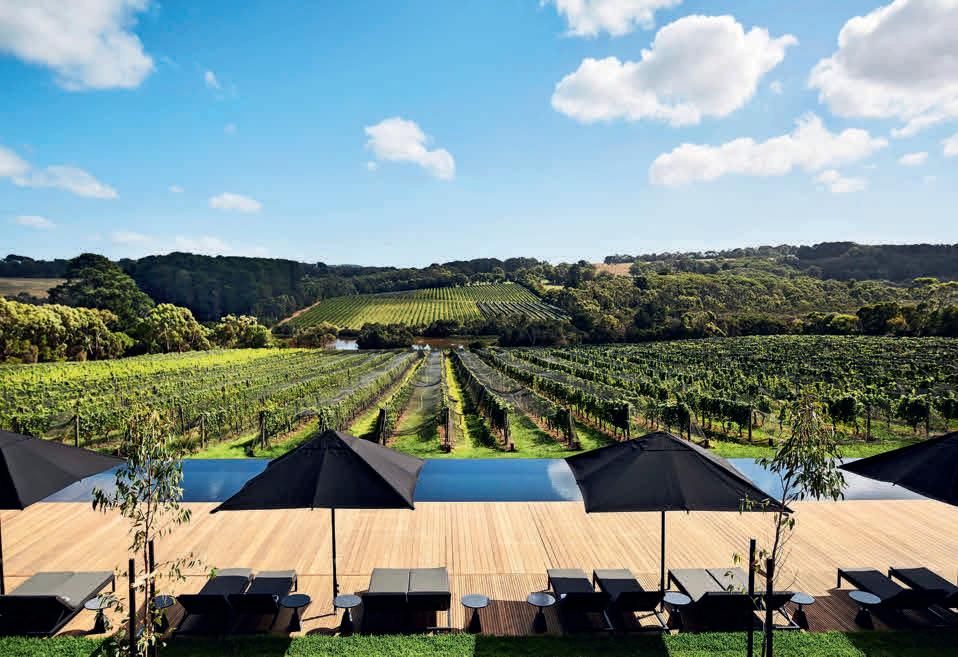
The jackalope – America’s counterpart to mythical European beasts such as Bavaria’s wolpertinger and Sweden’s skvader – is now making its Antipodean debut. Standing an intimidating 23 metres tall, the outsized sculpture greets guests outside the entrance of the eponymous hotel near Melbourne. The hotel’s art collection fancies itself as a bit rebellious, luring guests into the emotional world of Rick Owens, Rolf Sachs, Emily Floyd et al. Its ambition is to redefine hospitality. Mostly black, the exalted residence invites sojourners to embrace its art, surrender themselves to sunsets over Willow Creek Vineyard or simply relax in an Autoban armchair.
Der Jackalope, die US-amerikanische Version des Bayerischen Wolpertinger, gibt jetzt sein Debut in Australien. Mit beeindruckenden 23 Metern Höhe grüsst er als überdimensionale Skulptur die Gäste am Eingang des gleichnamigen Hotels nahe Melbourne. Die Kunstsammlung des Hauses will rebellisch sein, will die Gäste mit Werken u.a. von Rick Owens, Rolf Sachs und Emily Floyd auf eine Reise in die Welt der Emotionen mitnehmen, will Gastfreundschaft neu definieren. Das weitgehend in Schwarz gehaltene Anwesen lädt dazu ein, sich auf die Kunst, auf die Sonnenuntergänge über Willow Creek Vineyard zu konzentrieren oder in einem Autoban Sessel zu entspannen.

NEW MEMBERS OF THE LEADING HOTELS OF THE WORLD
tHe orient Jakarta


CENTRAL JAKARTA, INDONESIA
»Ups, he did it again...!« When hotel designer Bill »No Limits« Bensley is quoted as being »proud to be quirky«, you can be sure that escapism and maximalism have gone forth and been fruitful. The Orient Jakarta is outrageously sensuous, reawakening the Batavia of yesteryear, cherrypicking the best the modern day has to offer and packing the whole into a blueprint for the perfect tomorrow.
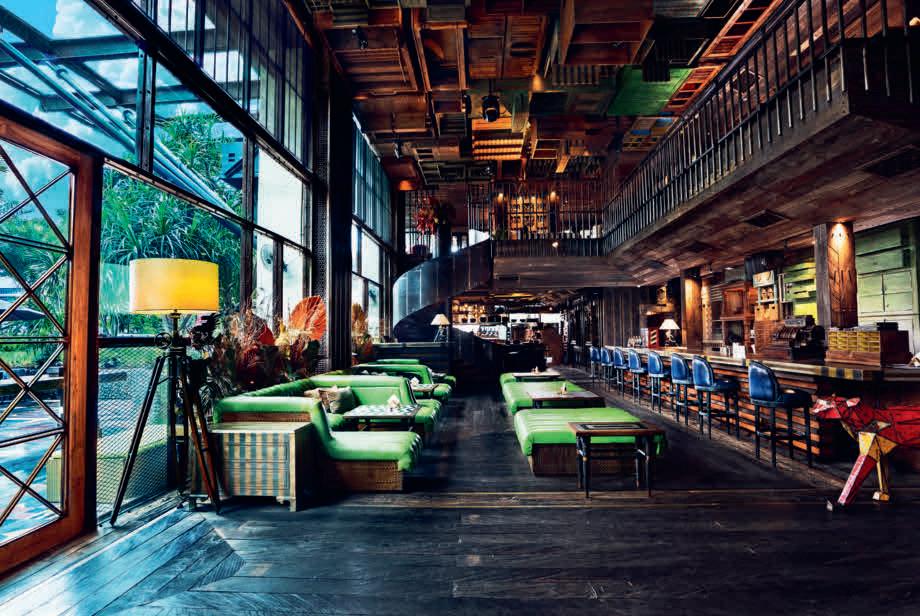
»Ups, he did it again...!« Wenn Hoteldesigner Bill »No Limit« Bensley mit den Worten »Proud to be quirky« zitiert wird, dann reimt sich das auf Eskapismus und Maximalismus. Das Orient Jakarta ist ungeheuerlich sinnenfreudig, spiegelt das einstige Batavia, stiehlt das Schönste aus dem Heute und packt alles in einen Entwurf für ein perfektes Morgen.


Mari Mari natural reserve experience
HACIENDA PARGA S/N LOS MUERMOS, CHILE
It all began with an undiscovered beach, a raging sea of wild, whitecrested waves and rock formations of fascinating variety. Fauna and flora had clearly dispatched the best performers they could find to these parts. Even Noah, it seems, must have saved his animals just for this sublime spot of heaven on Earth. Then came the Mari Mari, a silent observer blending into the scenery. Ever since, the latter’s unbridled passion has been for visitors too to taste and see every facet of this unspoiled virgin nature – giving horse and rider moments of unrestrained freedom, anglers a place of pure contemplation, photographers a surfeit of exotic motifs. Raise your eyes to the heavens and you will also discover teeming, unique birdlife. Ageold paths line the coast and traverse the rainforest. And whenever a whale blows, you could almost think our world was pristine once again.
Am Anfang ward ein unentdeckter Strand, ein tosendes Meer mit wilden weissen Schaumkronen, Felsformationen von faszinierender Vielfalt. Fauna und Flora hatten offensichtlich ihre besten Künstler hierher entsandt und –da sind wir uns ganz sicher – Noah seine Tiere bis genau zu diesem paradiesischen Flecken Erde gerettet.

Dann kam das Mari Mari, schmiegte sich als stiller Beobachter in die Szenerie und sorgt seitdem mit viel Leidenschaft dafür, dass auch seine Gäste diese Ursprünglichkeit in all ihren Facetten erleben – Momente grösster Freiheit für Pferd und Reiter, ein Ort purer Kontemplation für Angler, ein Überangebot an exotischen Motiven für Fotografen. Wer den Blick gen Himmel schweifen lässt, wird eine einzigartige Vogelwelt entdecken, uralte Pfade führen entlang der Küste, durch Regenwald und wenn der Wal bläst scheint unsere Welt endlich wieder perfekt.
Patagonia’s breathtaking natural surroundings set the stage on which the Mari Mari conjures a truly unique experience for children and grown-ups alike.
Die atemberaubende Natur Patagoniens bildet den Rahmen, das Mari Mari zaubert für Erwachsene wie Kinder eine »unique experience« hinein.
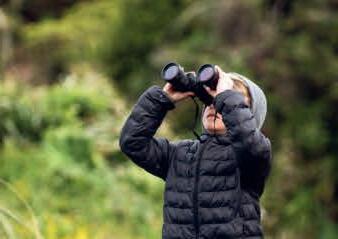


68 VIEWS MAGAZINE
NEW
OF THE
HOTELS OF THE WORLD
MEMBERS
LEADING
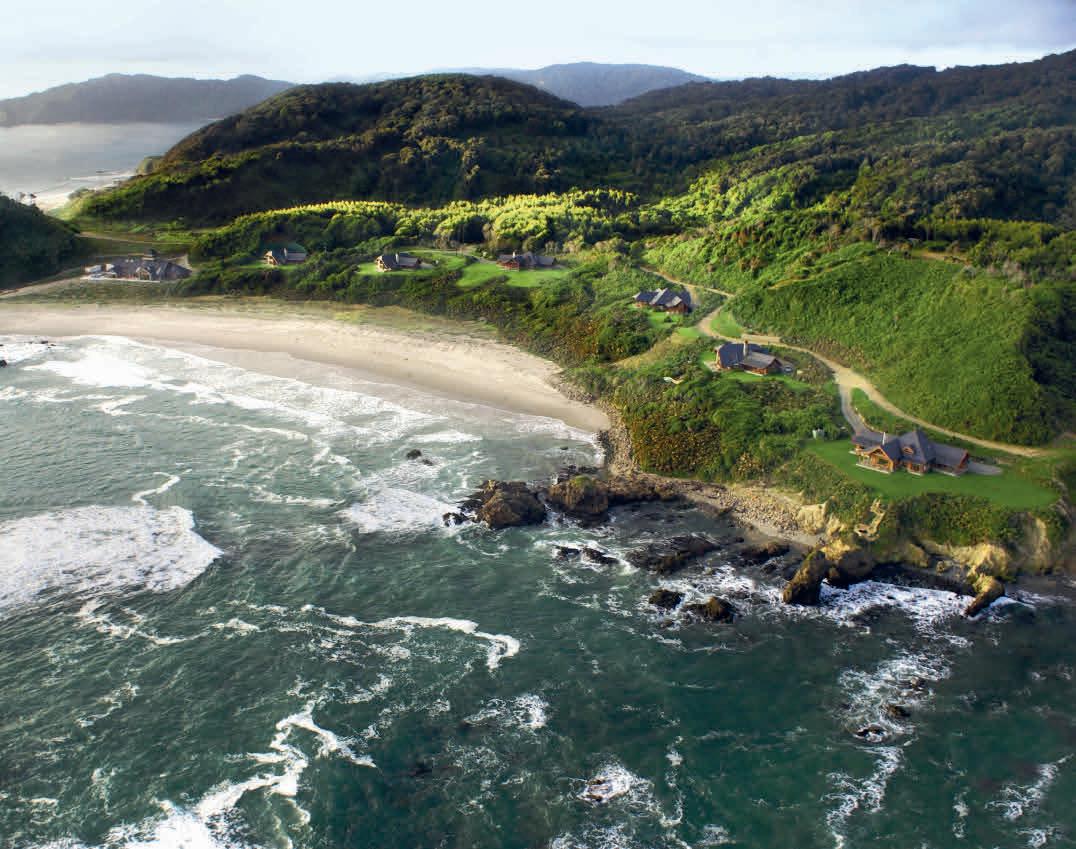
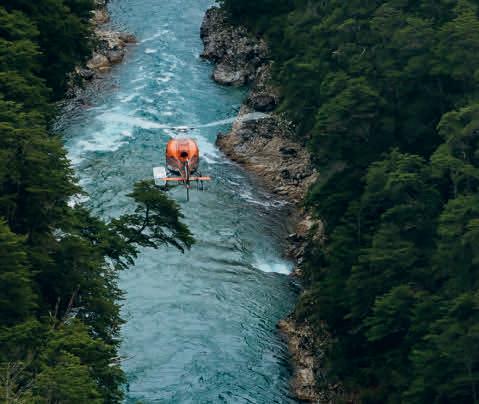

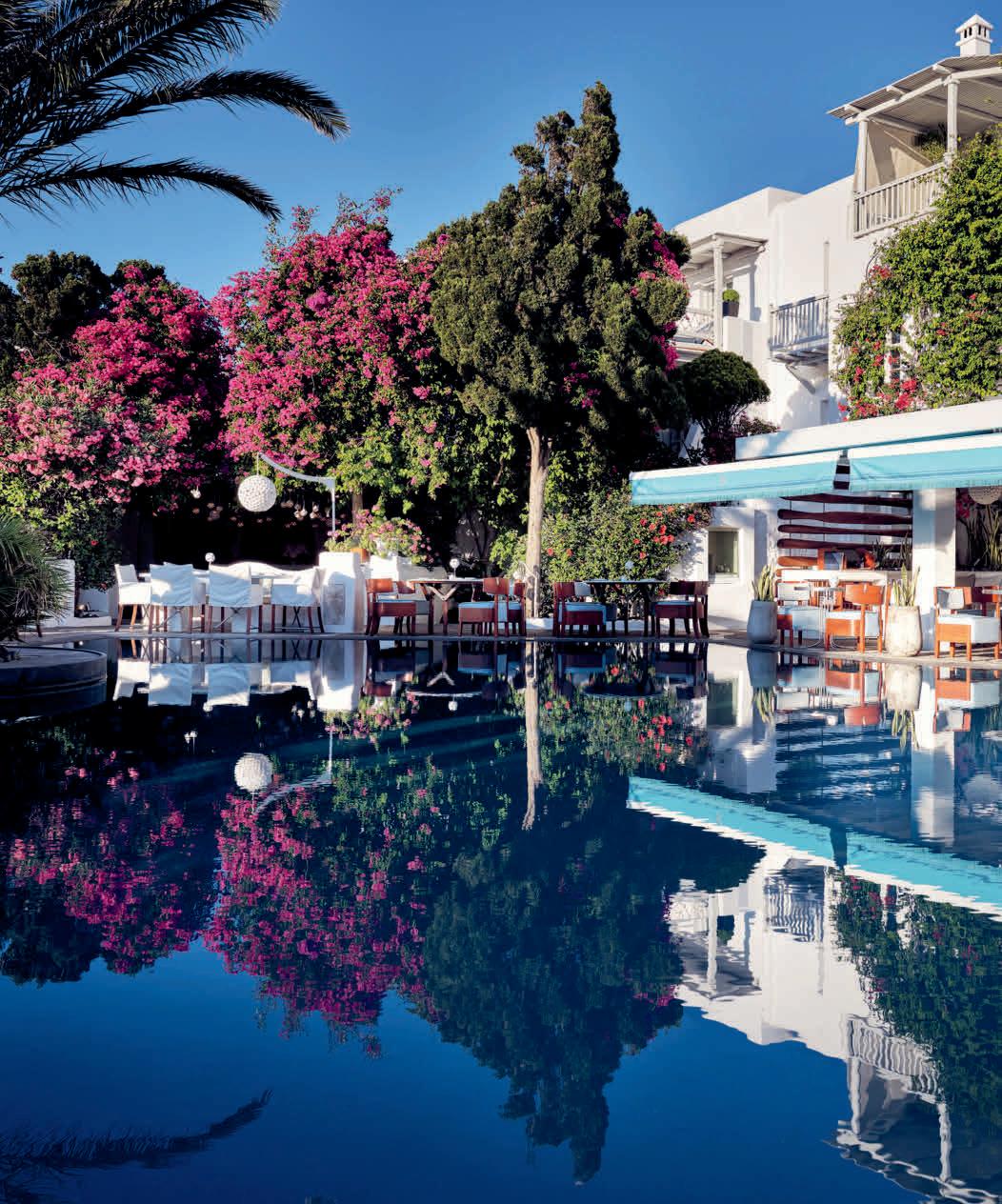
69
lido palace
 RIVA DEL GARDA, ITALY
RIVA DEL GARDA, ITALY
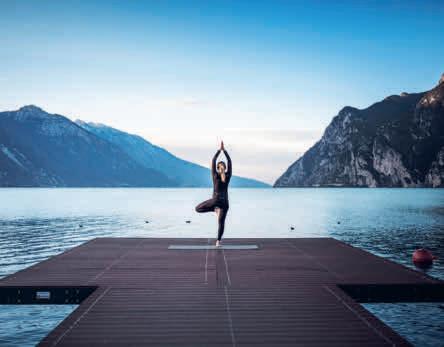

Decode and recompose. In keeping with this philosophy, architect Alberto Cecchetto has made deft use of metal and glass to transport the venerable Belle Époque edifice into the here and now. Yet in so doing, he has also magnificently preserved the spirit, the magical beauty of what was once a holiday resort for the Habsburgs and, later, for artists and philosophers.
Dekodieren und neu zusammensetzen. Architekt Alberto Cecchetto hat entsprechend seiner Philosophie die Mauern des altehrwürdigen Belle Époque Gebäudes gekonnt mit Metall und Glas ins Hier und Jetzt versetzt, den Esprit des einstigen Urlaubsorts der Habsburger Königsfamilie – später der von Künstlern und Philosophen – in seiner magischen Schönheit perfekt bewahrt.
70 VIEWS MAGAZINE
NEW MEMBERS OF THE LEADING HOTELS OF THE WORLD
anantara n ew York palace Budapest
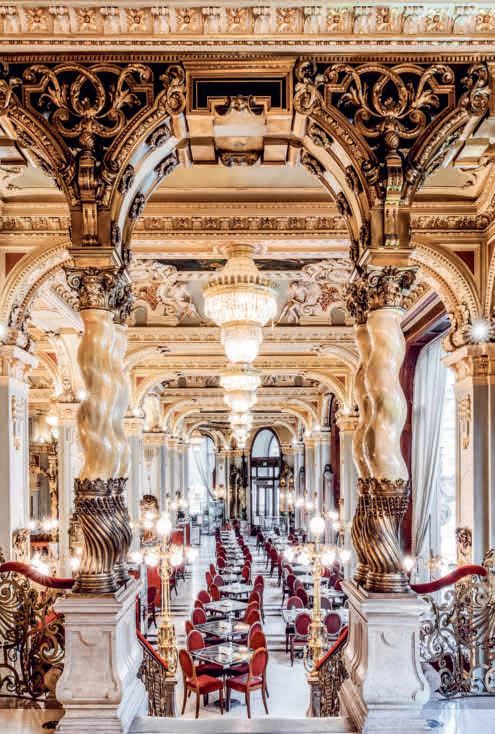
BUDAPEST, HUNGARY
Another journey back in time to the Belle Époque: Here, on the elegant Erzsébet Körút Boulevard, the Anantara »embraces« the legendary New York Café, home to the no less famous Poet Bar and once the intellectual heart of Hungary. It was here that artists met, writers breathed life into their protagonists, philosophers gave themselves to impassioned discourse.
Eine Zeitreise in die Welt der Belle Époque: Hier am eleganten Erzsébet Körút Boulevard »umarmt« das Anantara das legendäre New York Café mit der nicht minder berühmten Poet Bar, einst das intellektuelle Zentrum Ungarns, in dem Künstler sich trafen, Schriftsteller ihre Protagonisten zum Leben erweckten, Philosophen leidenschaftliche Diskurse führten.

GleneaGles t own H ouse
EDINBURGH, SCOTLAND, UNITED KINDGOM
»Gleneagles Townhouse is a place to gather and be glorious«. This distinctive lifestyle is underscored by a dazzling blaze of colours, fabrics and accessories. Here, opulence meets modernity, competing patterns rub shoulders, vintage embraces trendy. The Gleneagles seems to epitomise Edinburgh’s picturesque old town with its narrow alleys, courtyards, squares and enchanting gardens.
»Gleneagles Townhouse is a place to gather and be glorious«. Untermalt wird dieses Lebensgefühl mit einem Rausch an Farben, Stoffen und Accessoires – Opulenz trifft Moderne, Muster konkurrieren mit noch mehr Mustern, vintage umarmt trendy. Das Gleneagles mutet an wie ein Spiegelbild der pittoresken »Old Town« Edinburghs mit ihren verwinkelten Gassen, Höfen, Plätzen und bezaubernden Gärten.
THE LEADING HOTELS OF THE WORLD
NEW MEMBERS OF
saMarkand reGencY aM ir t e M ur


SAMARKAND, REPUBLIC OF UZBEKISTAN
Amir Temur built one of the greatest empires of Central Asia. He loved the arts and was a patron of literature. And in the shape of Samarkand he created what, at the time, was the region’s most impressive capital. The »Silk Road Samarkand« project is the Uzbeki government’s way of seeking to entice new life back to this fabled city. Lighthouselike, the luxury hotel Samarkand Regency Amir Temur presides over this smart new complex of office buildings, parks and cultural facilities.
Amir Temur schuf eines der grössten Reiche Zentralasiens. Er liebte die Kunst und förderte die Literatur. Mit Samarkand schuf er die damals beeindruckendste Hauptstadt Zentralasiens. Die usbekische Regierung will mit dem »Silk Road Samarkand« Projekt neues Leben in die sagenumwobene Stadt locken. Das Luxushotel Samarkand Regency Amir Temur ist der Leuchtturm in diesem Komplex aus OfficeGebäuden, Parkanlagen und kulturellen Einrichtungen.
TEL AVIV, ISRAEL
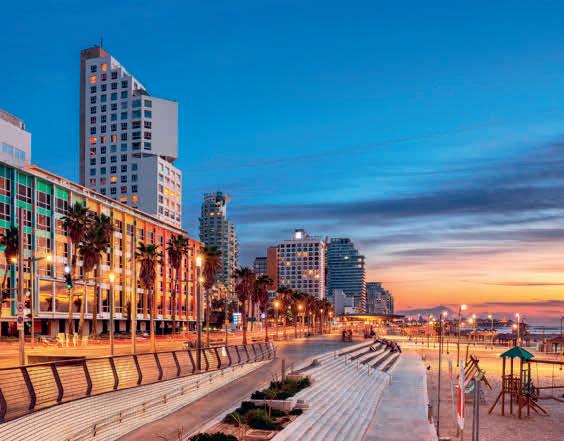
Roughly translated, »lisrom« means »to drift along«, »to let go«. That’s a lot of lifestyle in a little word, neatly encapsulating the zeitgeist that wafts freely through the streets of this thoroughly diverse city. The Dan overlooks the beach; and from any window you can see this unique attitude to life playing out – before going downstairs and letting go yourself.
»Lisrom« – bedeutet in etwa »sich vom Strom treiben lassen«, »locker machen«. Damit wird ziemlich viel Lebensgefühl in ein einziges Wort gepresst inklusive des Zeitgeists, der durch die Strassen dieser zutiefst diversen Stadt weht. Vom Fenster des Dan mit bestem Blick auf den Strand kann man diese einzigartige Lebenseinstellung beobachten, bevor man sich selbst in den Trubel mischt.
72 VIEWS MAGAZINE dan
tel aviv
tHe dYlan
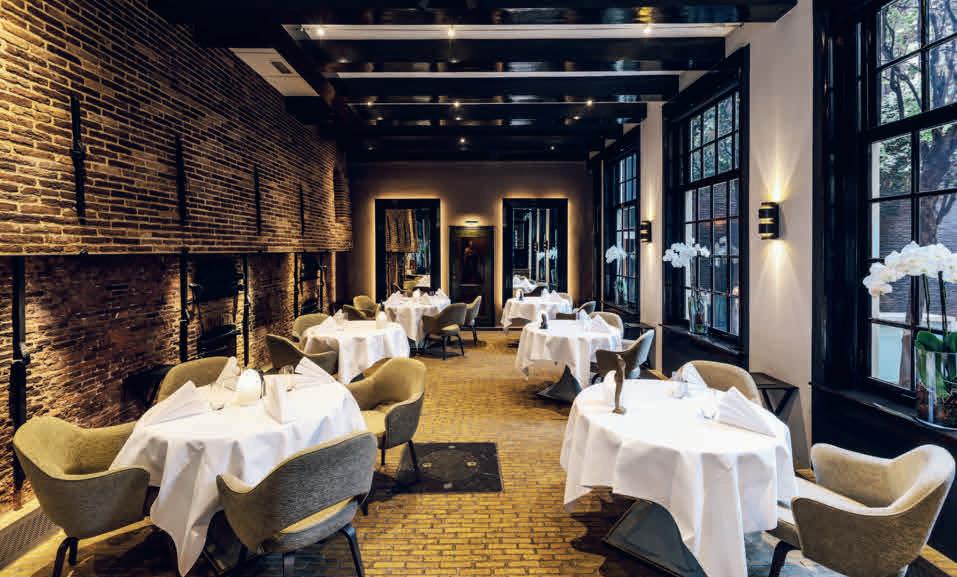
AMSTERDAM, NETHERLANDS
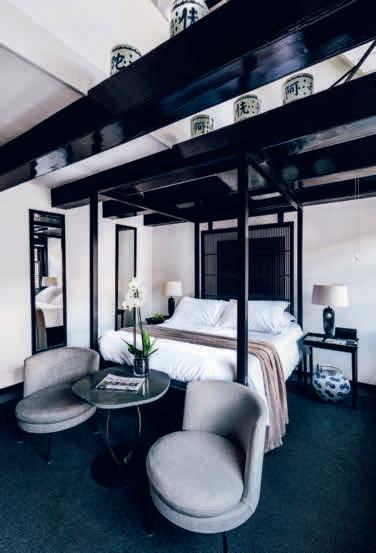
Rembrandt once worked on his paintings within these walls. His inspiration evidently lingers on: The Dylan shines brightest where black varnish abounds. The bricks have a soft appearance, the plurality of styles fuses into the singular, the glamorous feels familiar. You could almost forget you were in the middle of Amsterdam: Indeed, it almost seems preferable to tarry over a High Wine, partake of the awardwinning cuisine or soak up the tranquillity of the dreamlike garden.
Rembrandt malte einst in diesen Mauern. Offenbar hallt seine Inspiration nach, denn das Dylan leuchtet besonders hell, wo seine Flächen schwarz lasiert sind, die Klinkersteine wirken weich, der Stilpluralismus singulär, das Mondäne familiär. Fast möchte man vergessen, dass man sich inmitten von Amsterdam befindet – lieber noch in der Brasserie beim »High Wine« sitzen, die Sterneküche geniessen oder im traumhaften Garten des Dylan zur Ruhe kommen.

naYara Bocas del toro
ISLA FRANGIPANI BOCAS DEL TORO, PANAMA
A threehour flight from Miami and another hour from Panama City will get you to… Bali?! Well, at least to seemingly the biggest fans of the Indonesian island. No effort was spared to make the scattered villas to order in Indonesia and have them – complete with a hundredyearold restaurant – shipped half way round the world to Panama. It is hard to say which feels better: the profound love of intricate detail or the invigoratingly laidback flair.
Drei Flugstunden von Miami, eine weitere von Panama City findet sich…? Bali! Zumindest die grössten Liebhaber der indonesischen Insel. Daher wurden keine Mühen gescheut, die luxuriösen Villen in Indonesien massanfertigen zu lassen und das hundert Jahre alte Restaurant gleich mit um die halbe Welt nach Panama zu verschiffen. Dazu gesellen sich Liebe zum Detail und lebensbejahende Lässigkeit.

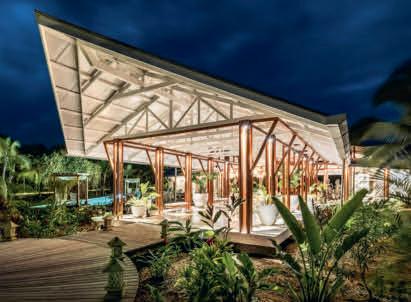


NEW MEMBERS OF THE LEADING HOTELS OF THE WORLD
eMerald FaaruFusHi resort & s pa

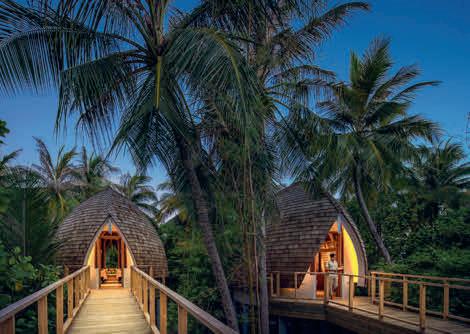
FAARUFUSHI, RAA ATOLL REPUBLIC OF MALDIVES

The Maldives: everyone’s dream of an island paradise. Of water in every nuance of blue and green. Of shimmering beaches, coral reefs and lagoons. And, of course, of the most luxurious pastime of all: doing absolutely nothing. Add the name »Emerald« in this farflung corner of the planet and you have pretty much nailed down the concept of luxurious elegance.
Malediven. Sinnbild für den wahren Inseltraum, für Wasser in seinen verschiedensten blauen und grünen Schattierungen, Strände, Korallen, Lagunen. Vor allem der luxuriösesten aller Ideen – der vom Nichtstun. Wer sich an diesem Ende der Erde zudem »Emerald« nennt, hat die Idee vollkommen durchdrungen, weiss die Eleganz mit dem berühmten Traum von der einsamen Insel zu kombinieren.
75
REVISITED
AEGEAN ARCADIA
When the Ioannidis family built a villa on the loveliest conceivable slice of Mykonos 130 years ago, they wanted to make it really special. Today, the charming Belvedere has a reputation of tangibly reviving the island’s authentic traditions.
Etwas Besonderes sollte entstehen, als die Familie von Tasos Ioannidis vor 130 Jahren eine Villa auf dem schönsten Flecken von Mykonos baute. Heute ist das elegante Belvedere bekannt dafür, die authentische Inseltradition wieder spürbar zu machen.

MEMBERS OF THE LEADING HOTELS OF THE WORLD
Belvedere Hotel
MYKONOS, GREECE
The story begins in the 1850s, when the Ioannidis family erected a proud villa in the most beautiful location they could find. Later, when Aristoteles Onassis stopped by – first with Maria Callas, then with »Jackie O« – and was followed by the jetsetters, stars and bohemians of his day, the Ioannidis clan took to renting Mansion Stoupa out privately to artists and politicians. Demand for such a jewel is brisk, however, so the villa ultimately morphed into the Hotel Belvedere. The Ioannidis siblings have taken all the (very many) positives of this lifestyle and, in profound deference to the island’s traditions, enhanced it with manifest skill and stylish luxury. The building’s Cycladic minimalism in general and the exceptional legacy of their greatgrandmother in particular have, after yet another round of extensive renovation, been enriched and immediately attracted the stars of the international designer scene. The Waterfront Villa & Suites were added, as were the Hilltop Rooms & Suites and a Six Senses Spa. Nobu Matsuhisa opened his first openair restaurant here back in 2003.
Alles begann, als in den 1850er Jahren die Familie Ioannidis in Mykonos' schönster Lage eine stattliche Villa errichtete. Später, als Aristoteles Onassis erst mit Maria Callas, dann mit »Jackie O« hier auftauchte und die Jetsetter, Stars und Bohemiens ihrer Zeit folgten, vermietete man die »Mansion Stoupa« privat an Künstler und Politiker. Doch solch ein Kleinod ist begehrt und so wurde aus der Villa schliesslich das Hotel Belvedere. Die Geschwister Ioannidis haben an das Positive dieses Lifestyles so gekonnt wie luxuriös angeschlossen und ihn mit Respekt vor der Tradition der Insel weiterentwickelt. Der kykladische Minimalismus im Allgemeinen und das besondere Erbe ihrer Urgrossmutter wurden nach erneut umfangreicher Renovierung mit noch mehr Komfort angereichert und lockten sofort die Stars der inernationalen Designer-Szene an. Waterfront Villa & Suites sowie die Hilltop Rooms & Suites kamen hinzu, ebenso ein Six Senses Spa und bereits 2003 eröffnete Nobu Matsuhisa hier sein erstes Open Air Restaurant.


Twenty years on, the master himself still attends the annual Nobu Food Festival in person.

Auch im zwanzigsten Jahr seines Bestehens kommt der Meister noch persönlich zum jährlichen Nobu Food Festival.

77
new MeMBers 2023
Becoming a member of The Leading Hotels of the World involves a strict selection procedure. Some 20 newcomers a year are welcomed into the illustrious ranks of independent luxury hotels.
Hotels müssen sich einem strengen Auswahlverfahren stellen, um Mitglied der Leading Hotels of the World zu werden. Jedes Jahr werden etwa 20 neue Häuser in den erlauchten Kreis unabhängiger Luxushotels aufgenommen.
LESANTE CAPE RESORT & VILLAS ZAKYNTHOS, GREECE
LIDO PALACE RIVA DEL GARDA, ITALY
MARI MARI NATURAL RESERVE EXPERIENCE LOS MUERMOS, CHILE
MAXX ROYAL KEMER RESORT KEMER/ANTALYA, TURKEY
NAYARA GARDENS LA FORTUNA DE SAN CARLOS, COSTA RICA
LEADERS CLUB
ANANTARA NEW YORK
PALACE BUDAPEST BUDAPEST, HUNGARY
NAYARA BOCAS DEL TORO ISLA FRANGIPANI, BOCAS DEL TORO, PANAMA
CASA ANGELINA PRAIANO, ITALY
DAN TEL AVIV
TEL AVIV, ISRAEL
DIAMOND ROCK TIGNES, FRANCE
EMERALD FAARUFUSHI
RESORT & SPA FAARUFUSHI, RAA ATOLL, REPUBLIC OF MALDIVES
EMERALD ZANZIBAR RESORT & SPA
ZANZIBAR, TANZANIA
GLENEAGLES TOWNHOUSE
EDINBURGH, SCOTLAND
UNITED KINDGOM
HOTEL MONTEVIDEO MONTEVIDEO, URUGUAY
JACKALOPE HOTEL MORNINGTON PENINSULA, MERRICKS NORTH, AUSTRALIA
HOTEL LAS MAJADAS
SANTIAGO, CHILE
THE ORIENT JAKARTA CENTRAL JAKARTA INDONESIA
PORTRAIT MILANO MILANO, ITALY
SAMARKAND REGENCY AMIR TEMUR SAMARKAND, REPUBLIC OF UZBEKISTAN
ROYAL SAVOY HOTEL & SPA LAUSANNE, SWITZERLAND


THE DYLAN AMSTERDAM AMSTERDAM, NETHERLANDS
VILLA LE BLANC, A GRAN MELIA HOTEL MENORCA, SPAIN
VILLA MARA CARMEL CARMEL, CA, USA
The dozen or so members of The Leading Hotels of the World portrayed on the preceding pages have doubtless whetted your appetite. The best way to discover the boundless variety of the more than 400 member hotels in all is to join the Leaders Club. This free bonus program guarantees you unique experiences at independent luxury hotels. But it also gives you preferential booking rates saving you 500 US dollars right from day one. Most of the local hoteliers have been devoted hosts for generations. Their consummate knowledge and experience thus gives travellers a fresh and intimate insight into even familiar destinations. Leaders Club members enjoy preferential treatment, qualify for free upgrades and can collect points for their next stay.
Ein Dutzend Mitglieder der Leading Hotels of the World auf den vorangegangenen Seiten haben sicher Lust auf Mehr gemacht. Der beste Weg, die Vielfalt der insgesamt über 400 Member Hotels zu entdecken, ist der Leaders Club. Das kostenlose Prämienprogramm garantiert nicht nur einmalige Erlebnisse in unabhängigen Luxushotels, sondern beschert auch vom ersten Tag an Buchungsvorteile im Wert von 500 US$. Die Insider-Kompetenz der lokalen Hoteliers, die meist seit Generationen leidenschaftliche Gastgeber sind, bringt dem Reisenden auch vertraute Destinationen auf ganz neue Art nahe. Leaders Club Mitglieder geniessen bevorzugte Behandlung, kostenlose Upgrades und können Punkte für den nächsten Aufenthalt sammeln.
78 VIEWS MAGAZINE
u
discover tHe
nexpected!
NEW MEMBERS OF THE LEADING HOTELS OF THE WORLD





CH – 1006 L ausanne T +41 21 613 33 33 reservation@brp.ch www.brp.ch THE SIGNATURE
SUITES
PAST HISTORIC. FUTURE PERFECT?
Change is in the air at two of Europe’s most venerable family-owned luxury hotels. While Marguita Kracht is gently easing into the driving seat at Zurich’s Baur au Lac under the watchful eye of father Andrea, Veruschka and Roberto Jr. Wirth have been thrown in at the deep end at the Hassler in Rome. Yet with the whole world around them in a state of flux, what does the future hold for the two respected dynasties?
Roberto Jr. and Veruschka Wirth are following in the formidable footsteps of a father who became a legend in his own lifetime. It is they who are now running the Hassler – a hotel, right opposite Rome’s fabled Spanish Steps –which has been family-owned since 1857. An hour and a half by plane to the north, Marguita Kracht, having built her own career in international hoteliery, represents the seventh generation of her family on the Board of Directors at the Baur au Lac in Zurich. She cut her teeth in this capacity by revamping the hotel’s corporate design. Now, she has officially taken her place alongside her father, Andrea Kracht, on the Board of H. Kracht’s Erben AG.
VIEWS talked to all four hoteliers about the responsibility that goes with such a stellar family heritage, and whether family-run luxury hotels still have a place in the modern age.



When you are born into a hotel dynasty, do you really have any choice but to become a hotelier?
Outsiders might look with envy at what they see as the fairy-tale life of »hotel children«: frolicking through the hallowed halls from an early age, sitting on the lap of the concierge, feeding on the finest pâtisseries. It sounds like the most natural thing in the world for a hotel’s offspring to grow into their predestined role.
The somewhat amused consensus from Zurich and Rome, however, is that the reality is completely different. The widespread (mis) conception that the children of a hotelier family effectively master their trade right from the cradle must be revised if only because none of our four interview partners actually grew up in the hotel. Both the Wirths and the Krachts lived off-site. All three heirs – and, in his youth, Andrea Kracht too – attended boarding schools far removed from hotel hallways and the everyday work of their parents.
80 VIEWS MAGAZINE
Andrea Kracht, sixth-generation owner of the Baur au Lac has no plans to step away from the hotel anytime soon. Yet the seventh generation – in the shape of his daughter Marguita – is already making sure that, when that day comes, the transition will be smooth and seamless.
Marguita enjoys working with her father but stresses that hotel management is still something you have to learn from scratch. Running a family-owned hotel demands profound and passionate commitment. And for all the weight of family tradition, shouldering such a great responsibility ultimately has to be a cold, clear-minded business decision.
None of the four ever felt pushed into the role. Each has followed their own heart and their own motivation. Andrea well recalls how his plans for the future were anything but clear when he began his training at the elite »École hôtelière de Lausanne« (EHL) co-founded by his great-great-grandfather Theodor Baur. Chopping vegetables was the first item on the curriculum, and his enthusiasm was not exactly boundless. That said, what was very probably happening at the self-same moment in the kitchen of the Baur au Lac? Vegetables were being chopped to be served as part of a gourmet dish to a guest seated in the Pavillon restaurant. This
realization was a key moment, as Andrea recalls: one tiny act, but one that had to be mastered to perfection because it was part of – and could materially influence – the whole. The spark in him was quickly kindled to a flame. And he finds it deeply gratifying to now see that same passion and vision for running the Baur au Lac ignited in his daughter, too.
For their part, the twins Veruschka and Roberto Wirth Jr. openly admit that they would gladly have spent many more years learning from their father. Despite being deaf, Roberto E. Wirth had a ubiquitous, largerthan-life presence and earned the esteem of a world far beyond the realms of global

Though thrust into their current role ahead of time, Veruschka and Roberto Jr. brush off any talk of this being a »burden«. Armed with a thoughtful, considered mindset, a generous helping of good humour and understanding beyond their years, the brother-and-sister team relish the thrilling challenge of taking the Hassler forward into a new era.
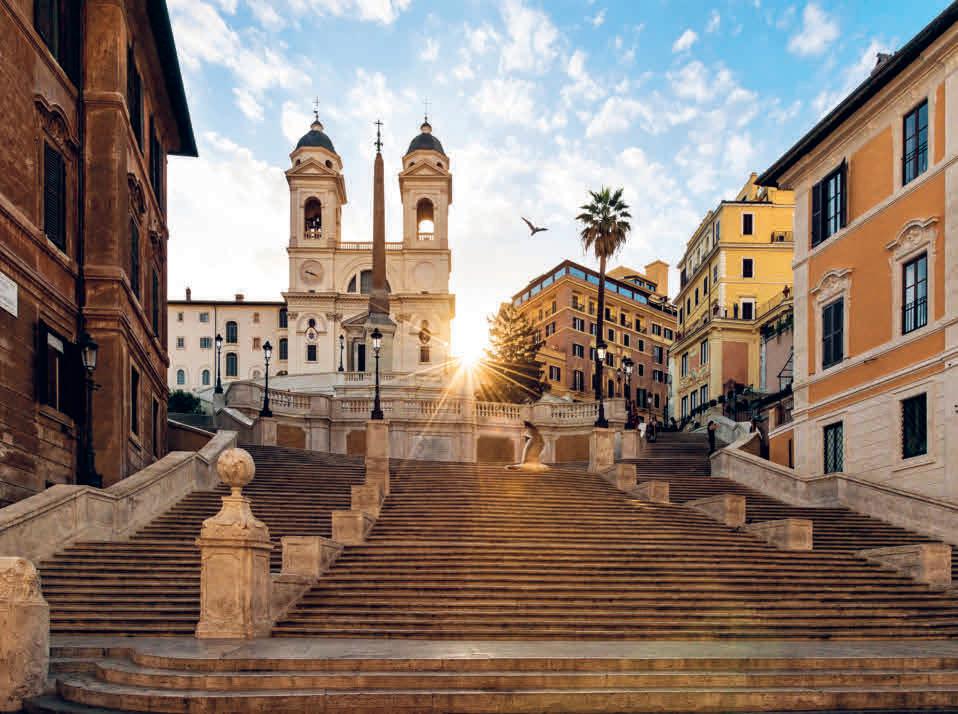
81
luxury hoteliery. For forty years, he insisted on personally welcoming the world’s elite, literally reading their lips – in four languages – to intuit and anticipate their every wish. His smile, too, was ever-present, as if he wanted to embrace the whole world in his unique brand of personal hospitality. Whenever he bumped into a staff member with a sombre look, his eyes would twinkle and he would draw a smiley face in the air with his finger. As a teenager, Veruschka felt embarrassed by this gesture – especially when he repeated it even to the staff of other hotels where they were staying as guests! Today, it is a trait missed by so many, and all the more so by his two children and heirs.
To what extent are your management decisions influenced by competition from the major luxury hotel chains?
All four hoteliers respond to this question with a relaxed shrug. Andrea Kracht points out how relatively new players on the market can enrich and inspire even such venerable, historic establishments, how each can cross-pollinate with the others. But he takes a dim view of attempts »to make big marketing waves by skimming small stones«, as he puts it: No hotel should have to communicate what everyone takes for granted, what is standard practice. The hotel business
essentially has one purpose and one purpose only, he says: to deliver overnight stays. That is why guests come. So, Kracht argues, they should always leave with the feeling of having experienced something special.

Our interviewees agree that a hotel’s public image should align with its character and standing – and that this is far more important than its marketing budget. One aspect is the family’s passion, its love for what they have inherited and what they will one day leave as a legacy. Another is the owners’ deep roots in their capacity as natives of Zurich and Rome respectively. They and their establishments are a living, formative part of either city and its culture; and vice versa. And that is something »mere luxury« simply cannot compete with.
What sets your two hotels apart from other establishments?

Andrea speaks of delivering a »unique experience« – a goal he helped cultivate for the 400 or so »Leading Hotels of the World« during his ten-year tenure as their chairman. These experiences are often imparted to guests through the supposedly little things, such as perfectly accentuated room lighting: Roberto insists that even the most lavish and luxurious room must also be practical enough
Luxury aside, all guests want to feel at home, enjoy their overnight stay and »leave with the feeling of having experienced something special«, in the words of Andrea Kracht.
for the guest to immediately feel at home. »Uniqueness« can also stem from contemporary art giving a hotel the feel of a fashionable gallery. Works by the likes of Rashid Johnson, Louise Bourgeois and Annie Leibovitz, part of the Kracht family’s estate, are unlikely to be found hanging on the walls of just any luxury hotel.
Marguita, a zurichoise through and through, again stresses the importance of being embedded in the local culture. Her father concurs, seeing this as vital for all LHW hotels. That is why local residents gladly mingle with hotel guests in the restaurants and bars of both hotels, because they too see the hotel as part of their life. Conversely, this experience immerses international guests in the local culinary scene almost incidentally.
Right now, Marguita bought a boat. Guests will be able to stage events not only with a view across the lake from the Baur au Lac’s private park, but actually out on the water itself. Again, not every hotel can do that: The number of boats is strictly limited. Veruschka puts the same innovative perspective in a different nutshell: She sees her role essentially in the sheer diversity and creativity surrounding the hotel’s core function of providing overnight accommodation.
82 VIEWS MAGAZINE
Do family-run hotels think differently?
Three things set a luxury hotel apart: impeccable service, a flawless product and, of course, a unique location. And who wouldn’t put the Spanish Steps in Rome or a private park on Lake Zurich in the latter category? However, both the Krachts and the Wirths affirm the importance of immediately reinvesting profits in the substance of their hotels – another point where hotel chains, however comfortable and luxurious, simply cannot keep up. On both the Limmat and the Tiber, shareholders’ interests play second fiddle to perfection, individuality and sheer, exuberant joy. To quote Veruschka once again: We invest in the sense of satisfaction of waking up every morning and transporting the tradition and vision of our forefathers into the present day. That, her brother adds, is possible only if you stay utterly focused on your goal.

To
what extent do events in the outside world affect your hotels?
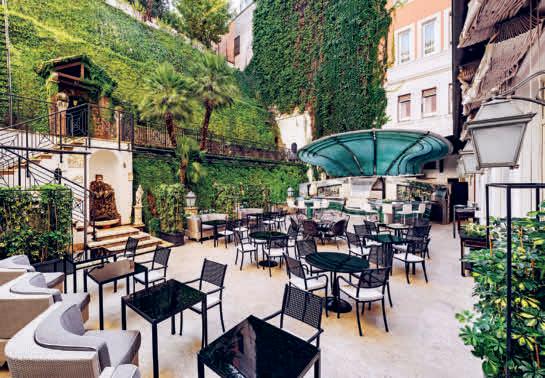
Our discussion with Zurich and Rome makes one point abundantly clear: Decades of experience and the fine art of flexibility are the trump cards that both families have to play day in, day out. Following the example set by past generations, creativity and cleverness are the skills needed to respond to whatever the outside world throws at you. Digitalisation is by no means the first technological
development to change the face of hotel processes, nor will Insta-mania be the last challenge to the marketing people. Megatrends, crises and a certain zeitgeist have always been there. They are constant companions and must always be taken seriously: Right now, for instance, both hotels are screening every process to see where sustainability can be improved without depriving guests of the luxury they expect and demand. Be that as it may, both also draw a clear distinction between their principal mission and outside influences. »History repeats itself,« is Roberto’s almost casual comment on the subject, convinced that he and his sister have what it takes to master this challenge, too.
Both sets of owners exude calm confidence, almost tranquillity, in the way they have risen to such daunting responsibility. And both clearly value innovation and ideas as the keys to giving every new arrival something they have never had before: their very own »unique experience«.
83
TOUCHING THE REAL THROUGH DIGITAL ART

In a world that is constantly evolving, digital art thrives at the forefront, pushing the boundaries of imagination and creativity. One name that stands out in this arena is Refik Anadol, an extraordinary visual and digital artist who specialises in immersive media art installations that explore the intersection of art, technology and science.
His projects often involve large-scale installations, utilising projection mapping, LED displays and other cutting-edge technologies to push the limits of what's possible in the digital art world.

One of his most visually stunning works is Julius Baer’s art commission »Glacier Dreams«, an immersive experience that takes viewers on a multichapter journey into the heart of nature and a mesmerising visualisation of the effects of global warming on our planet. »Glacier Dreams« was introduced as part of Julius Baer’s NEXT initiative, which examines the intersection of arts, science and technology and promotes the exploration of megatrends. The project launched at this year’s Art Dubai and unfolded in multiple chapters and locations, such as at the iLight Festival in Singapore and Art Basel.
Anadol's artwork is not only visually breathtaking but also thought-provoking. The artist hopes to raise awareness of climate change and rising sea levels through poetic, glacier-themed experiences, contributing to the study of glaciers with the help of artificial intelligence. In a world where technology and creativity are increasingly intertwined, Refik Anadol’s artistic practice stands as a testament to the boundless possibilities of digital art.
Eine Welt, die sich ständig weiterentwickelt, schafft beste Voraussetzungen für die digitale Kunst, welche die Grenzen der Vorstellungskraft und Kreativität verschiebt. Ein Name, der in diesem Bereich hervorsticht ist Refik Anadol, ein aussergewöhnlicher visueller und digitaler Künstler, der sich auf immersive Medieninstallationen spezialisiert hat, welche die Schnittstelle zwischen Kunst, Technologie und Wissenschaft erforschen. Zu seinen Projekten gehören oft grossformatige Installationen, bei denen er sogenanntes »projection mapping«, LED-Anzeigen und andere hochmoderne Technologien nutzt, um die Grenzen des Möglichen in der digitalen Kunstwelt zu erweitern.
Eines seiner visuell beeindruckendsten Werke ist die Auftragsarbeit »Glacier Dreams« für Julius Bär. Ein immersives Erlebnis, das den Zuschauer in mehreren Kapiteln auf eine Reise ins Herz der Natur mitnimmt und eine faszinierende Visualisierung der Auswirkungen der globalen Erwärmung auf unseren Planeten bietet. »Glacier Dreams« wurde im Rahmen der NEXT-Initiative von Julius Bär eingeführt, die die Schnittstelle zwischen Kunst, Wissenschaft und Technologie untersucht und die Erforschung von Megatrends fördert. Das Projekt startete 2023 auf der Art Dubai und wurde in mehreren Etappen und an mehreren Orten gezeigt, beispielsweise beim iLight Festival in Singapur und auf der Art Basel.
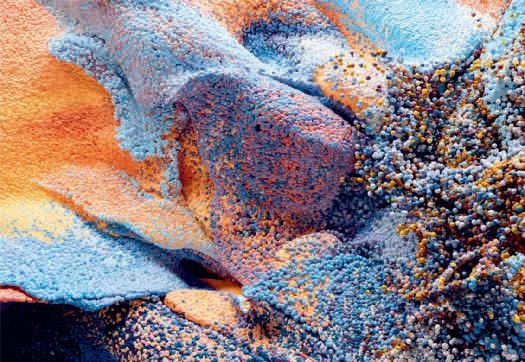
Anadols Kunstwerke sind nicht nur optisch atemberaubend, sondern regen auch zum Nachdenken an. Der Künstler hofft, durch poetische Erlebnisse zum Thema Gletscher das Bewusstsein für den Klimawandel und den Anstieg des Meeresspiegels zu schärfen und mit Hilfe künstlicher Intelligenz zur Erforschung von Gletschern beizutragen.
In einer Welt, in der Technologie und Kreativität zunehmend miteinander verflochten sind, ist Refik Anadols künstlerische Praxis ein Beweis für die grenzenlosen Möglichkeiten der digitalen Kunst.
Julius Baer’s new initiative ‘NEXT’ explores megatrends through artistic interventions in a first cooperation with Refik Anadol.
Die Bank Julius Bär begibt sich auf die Suche nach den Megatrends von morgen. Die Initiative »NEXT« startet in Zusammenarbeit mit dem Multimedia Künstler Refik Anadol.
 Refik Anadol @Efsun Erkilic
Photos: ‘Glacier Dreams’, 2023, ©Refik Anadol Studio
Refik Anadol @Efsun Erkilic
Photos: ‘Glacier Dreams’, 2023, ©Refik Anadol Studio
ROCK OF AGES?
How do you ignite passion? How do you set things in motion? You take some impressive protagonists, circulate pictures of them and tell stories about them. St. Gallen-born photographer Thomas Biasotto’s photobook MASSIV brings this strategy vividly to life.

Wie entsteht Begeisterung? Wie eine Bewegung?
Dafür bedarf es eines eindrücklichen Protagonisten sowie Bilder und Geschichten von ihm, über ihn. Der in St. Gallen geborene Fotograf Thomas Biasotto verfolgt mit seinem Bildband MASSIV genau dieses Kalkül.
Armed with just a camera, the 41-year-old immerses us in irresistible, archaic beauty. His protagonists? Mountain landscapes and the stories they tell: towering tectonic elevations embodying untold depths of yearning, casting down the gauntlet, luring mere mortals to excel themselves and (literally) attain to new heights. Jagged eminences whose bleak, merciless expanse drills us in the art of survival, whose raw essence terrifies, humbles the soul, raises us up to exultant ecstasy.
The pictures were taken with cameras from Alpa of Switzerland, whose technology has underpinned the aesthetics of such photographic greats as Karl Lagerfeld and Andreas Gursky.
Die Aufnahmen entstehen mit Kameras des Schweizer Herstellers »Alpa of Switzerland«, auf deren Technik und Ästhetik grosse Fotografen wie Karl Lagerfeld oder Andreas Gursky setz(t)en.
Yes, Thomas Biasotto consciously seeks to ignite passion. But not for its own sake. Not because he, a sought-after international photographer, brings the age-old beauty of the Alps – regal in their vul-
werden, Herausforderungen lauern. Die in ihrer schonungslosen Kargheit Überlebenskunst fordern, in ihrer Rauheit angsteinflössend sind – in denen wir Demut, Liebe und Hochgefühl empfinden.
Mittels seiner Kamera zeigt der 41jährige uns archaische Schönheit, derer man sich nicht entziehen kann. Seine Protagonisten sind Berglandschaften und deren Narrativ – mächtige tektonische Erhebungen, die tiefe Sehnsucht in sich tragen, Menschen über sich hinauswachsen lassen, wo Rekorde aufgestellt nerability, exuberant in their stillness – into focus for us all. Nor because, as an accomplished musician, he has the ability to blend marvellous sight with melodious sound. The aesthetic appeal of his work actually clashes with the growing threat to which we appear to have resigned ourselves, as if the current status quo were cast in stone for all eternity.
Begeisterung stiften möchte Thomas Biasotto jedoch nicht um ihrer selbst willen. Nicht, weil er als international gefragter Fotograf eben jene innerliche Schönheit der Bergwelt – stark und verletzlich, lebendig und doch so still – ablichten und damit für uns alle visibel macht.
Auch nicht, weil er als studierter Musiker das Talent mitbringt, seine Fotografien gleichsam melodiös »erklingen« zu lassen. Ihre Ästhetik kollidiert vielmehr mit der wachsenden Bedrohung, mit der wir uns abzufinden scheinen, als wäre der jetzige Status Quo für die Ewigkeit.
Swiss Alps JungfrauAletsch is a UNESCO World Heritage site: Stretching for 20 kilometres, the Great Aletsch in Valais is the longest glacier in the Alps. It is also the largest in terms of surface area.
UNESCO-Welterbe Schweizer Alpen JungfrauAletsch: Mit 20 Kilometern Länge ist der Grosse Aletschgletscher im Wallis flächenmässig der grösste und längste der Alpen.
86 VIEWS MAGAZINE

It is not. Biasotto’s lens captures this inherent conflict, revealing rocky cliffs at once as wonders of nature and as monochrome admonitions, stern warnings of the consequences of (in)action even for such immutable majesty. Gripping stories by seasoned experts of the calibre of mountaineering legend Reinhold Messner, extreme alpinist Evelyne Binsack and climate physicist Professor Reto Knutti accompany Biasotto’s photos, jar us awake, convey an inexorable urgency. Anecdote after anecdote oozes both love for these rocky giants and fear for their future. There is no finger-pointing here; only intense, untainted emotion.
Everyone does what they can. Musician and photographer Thomas Biasotto devotes his talents to the concerns that preoccupy him. And the rock-solid partners by his side – one of them the small, highly specialised, Zurich-based professional camera manufactory Alpa of Switzerland – are instrumental in realising his projects.
But does everyone really do what they can? The proceeds from the book will be donated to organisations committed to preserving the Alps.
Ist er nicht. Das vermittelt Biasotto in diesen fotografischen Momenten, zeigt Felsen als Naturwunder, zugleich als schwarzweisse Mahnmale, um uns jenseits ihrer Anmut dafür zu sensibilisieren, dass unser (Nicht-)Handeln Konsequenzen hat. Mitreissende Erzählungen ausgewiesener
Experten wie der Bergsteigerlegende Reinhold Messner, der Extrembergsteigerin Evelyne Binsack oder Klimaphysiker Prof. Dr. Reto Knutti begleiten Biasottos Fotos, rütteln auf, unterstreichen ihre Eindringlichkeit. Aus jeder Geschichte spricht wahre Liebe zu den felsigen Freunden, aber auch die Sorge um ihre Zukunft – keine Kritik des erhobenen Zeigefingers, vielmehr intensiv und zutiefst bewegend.

Jeder, wie er kann. Musiker und Fotograf Thomas Biasotto kämpft mit den ihm eigenen Talenten für sein Anliegen. Dabei verlässt er sich auf starke Partner, mit denen er sein Projekt realisieren kann. Eine zentrale Rolle spielt dabei der sehr spezialisierte Profi-Kamera-Hersteller »Alpa of Switzerland« mit Sitz in Zürich.
Jeder, wie er kann? Der Erlös des Buches wird an Organisationen gespendet, die sich für die Erhaltung der Alpen einsetzen.
MASSIV, Thomas Biasotto TB swiss creative GmbH
German/English, 400 pages ISBN: 978−3−033−08764−4


88 VIEWS MAGAZINE
Standing tall at 4,478 metres above sea level, the Matterhorn is one the highest mountains in the Alps. Its distinctive shape also makes it a classic symbol of Switzerland.

Das Matterhorn ist mit 4'478 m ü. M. einer der höchsten Berge der Alpen und wegen seiner markanten Gestalt Wahrzeichen der Schweiz.
Harsh, rugged and motionless one moment, lithe and kinetic the next: The Alpstein massif is situated to the south of the two Appenzell demicantons and is part of the eastern Alpine foothills.
Schroff, starr und harsch, dann wieder dynamisch und beweglich wie Wellen: Das Alpstein-Massiv erhebt sich im Süden der beiden Appenzeller Halbkantone und gehört zu den östlichen Voralpen.

DEEP DEVOTION


When Blancpain rolled out »Fifty Fathoms« as the first modern diver’s watch in 1953, the Swiss watchmaker also took the plunge and embarked on a mission to explore and preserve the world’s oceans. »Blancpain Ocean Commitment« (BOC) has since collaborated tirelessly with underwater explorers, photographers, scientists and environmentalists. One such partner is Biopixel, an Australian producer of nature films whose client list includes the BBC, National Geographic and Netflix. The Biopixel Oceans Foundation makes its footage available for scientific research. On its website or via the Ocearch app, the general public too can track sharks – including two whale sharks called Blancpain and Fifty Fathoms – as they meander through the Great Barrier Reef.
Blancpain’s cooperation with PADI, the world’s leading scuba diver training organisation, centres around the Adopt The BlueTM program. Harnessing the potential of thousands of dive sites and at a cost of millions of dollars, AdoptTheBlue is building the largest network of marine protected areas on the planet. The Sulubaaï Environmental Foundation, a Filipino-French outfit, is working towards the same goal under the oversight of local communities.
The Ocean Photographer of the Year (OPY) competition is looking for underwater photographers whose pictures can inspire others to play a part in preserving our oceans. The competition jury is bolstered by representatives of Blancpain and CEO Marc A. Hayek, himself an ardent diver and underwater photographer.
Als Blancpain 1953 mit der »Fifty Fathoms« die erste moderne Taucheruhr herausbrachte, tauchten die Schweizer zeitgleich in die Erforschung und den Schutz der Ozeane ein. »Blancpain Ocean Commitment« (BOC) ist seitdem kontinuierlich Kollaborationen mit Forschern, Fotografen, Wissenschaftlern und Umweltschützern eingegangen. Einer davon ist der australische Naturfilmproduzent »Biopixel«, zu dessen Kunden die BBC, National Geographic oder Netflix gehören. Die »Biopixel Oceans Foundation« stellt ihr Filmmaterial der Wissenschaft zur Verfügung. Auch die Öffentlichkeit kann über deren Webseite oder die gleichnamige App »Ocearch« Haie bei ihren Wanderungen durchs »Great Barrier Reef« verfolgen – so auch die beiden Walhaie »Blancpain« und »Fifty Fathoms«.
Herzstück der Kooperation mit PADI, der weltweit grössten Taucherorganisation, ist das millionenschwere »Adopt the BlueTM«Programm, das mittels tausender Tauchbasen das grösste Netzwerk von Meeresschutzgebieten des Planeten entwickelt. Daran arbeitet auch die philippinisch-französische »Sulubaaï Environmental Foundation«. Die Verwaltung wird von lokalen Gemeinschaften übernommen.
Der Wettbewerb »Ocean Photographer of the Year (OPY)« sucht Unterwasserfotografen, welche die Fähigkeit besitzen mit ihren Bildern andere dazu zu inspirieren, einen Beitrag zur Erhaltung der Ozeane zu leisten. Die Jury wird dabei ergänzt von BlancpainVertretern unter der Leitung ihres Präsidenten und CEO Marc A. Hayek, selbst begeisterter Taucher und Unterwasserfotograf.


Initiatives to which Blancpain is profoundly committed help explore and conserve the oceans – and have added more than four million square kilometres to the world’s marine protected areas.
Die von Blancpain mit viel Engagement unterstützten Initiativen zur Erforschung und zum Schutz der Ozeane haben die Fläche der weltweiten Meeresschutzgebiete um mehr als vier Millionen zusätzliche Quadratkilometer beträchtlich ausgeweitet.
The latest special »Female Fifty Fathoms« (FFF) prize, offered by Blancpain, went to Australian photographer Brooke Pyke.
Der von Blancpain ausgelobte Sonderpreis
»Female Fifty Fathoms« (FFF) ging zuletzt an die australische Fotografin Brooke Pyke.
91
HATCHING A VISION

Not a single sea eagle graced the skies over Lake Geneva for 130 years. That is as unacceptable as the relentless disappearance of species from the Alps, the most expansive contiguous ecosystem on our continent. What we need is a far-sighted vision. A passion. A will to bring change. And the understanding that even the smallest deeds can have Earth-changing repercussions.
Karl-Friedrich Scheufele, Co-President of Chopard, is said to possess all these attributes – a constellation which culminated, in 2021, in the Alpine Eagle Foundation. The eagle was chosen as the emblem of this initiative, whose philanthropic endeavours explicitly embrace the entirety of the Alpine ecosystem. Indeed, the sweeping wings of the airborne raptor itself seem to reach out across this 190,000 km2 region as if to shield it from harm. Scheufele is seconded by falconer Jacques-Olivier Travers, a man whose heartfelt love of these awe-inspiring creatures enriches our awareness of their sheer power and gentleness: Imperial eagle Darshan’s flight from the Burj Khalifa has been viewed millions of times. And then there is Ronald Menzel, activist on YouTube and founder of Freedom Conservation, a movement dedicated to protecting endangered birds of prey.
The project to return sea eagles to their original habitat is making excellent progress. A veritable digital nomad of our day, the first young eagle was fitted with GPS and additional sensors to track its location, heart rate and feeding habits. Over the next eight years, a further eighty of its fellows will be released on the shores of Lake Geneva.
130 Jahre lang kreiste der Seeadler nicht mehr um den Genfer See. Das kann hingenommen werden, so wie das kontinuierliche Verschwinden der Arten in den Alpen, dem grössten zusammenhängenden Ökosystem unseres Kontinents. Oder man trägt etwas Visionäres in sich, eine Passion, den Willen und die Weitsicht etwas zu verändern sowie das Wissen, dass auch ein kleiner Stein eine Lawine ins Rollen bringen kann.
Karl-Friedrich Scheufele, Co-Präsident von Chopard werden all diese Eigenschaften nachgesagt. Sie kulminierten 2021 in der »The Alpine Eagle Foundation«. Der Adler wurde das Emblem der Initiative, die sich in ihrem philanthropischen Bestreben ausdrücklich auf das gesamte alpine Ökosystem bezieht – wenn auch der majestätische Greifvogel mit seinen weiten Schwingen das über 190‘000 km2 grosse Gebiet zu umarmen scheint. An Scheufeles Seite steht der Falkner Jacques-Olivier Travers – der Mann, der uns die Kraft und Sanftheit von Greifvögeln aus tiefster Liebe zu diesen Tieren unermüdlich ins Bewusstsein bringt – Millionen Mal wurde Kaiseradler »Darshans« Flug vom Burj Khalifa angeklickt. Last but not least, Ronald Menzel, Aktivist auf YouTube und Gründer der Freedom Conservation, einer Bewegung, die sich für den Schutz bedrohter Raubvögel einsetzt.
The Alpine Eagle Foundation strives to conserve the entire Alpine massif in all its multifaceted magnificence.


Die »Alpine Eagle Foundation« hat sich dem Ziel verschrieben, das Alpenmassiv in all seinen Facetten zu erhalten.
Ein erster Jungadler aus einem Vierer-Wurf wurde erfolgreich freigelassen nachdem er 81 Tage im Nest seiner Eltern verbracht hatte.
Das Ziel, den Seeadler wieder in seinem ursprünglichen Lebensraum anzusiedeln, ist auf bestem Weg. Ganz ein digitales Kind unserer Zeit, wurde der erste Jungadler mit GPS und speziellen Sensoren ausgestattet, um Standort, Herzfrequenz und Ernährung zu beobachten. In den nächsten acht Jahren werden weitere achtzig Seeadler an den Ufern des Genfer Sees ausgesetzt.
93
A first young eagle from a brood of four was successfully released after spending 81 days in its parents’ nest.
THE ART OF HIGH LIVING
There are tangible and intangible aspects to luxury. Ideally, the two will go hand in hand.
Luxus hat materielle und immaterielle Aspekte, die möglichst Hand in Hand gehen sollten.
»Four Elements«, Walchwil ZG: The view from the sunny slopes across Lake Zug and the mountains is breathtaking.
»Four Elements«, Walchwil ZG: Am Sonnenhang geniesst man eine atemberaubende Aussicht auf den Zugersee und die Berge.
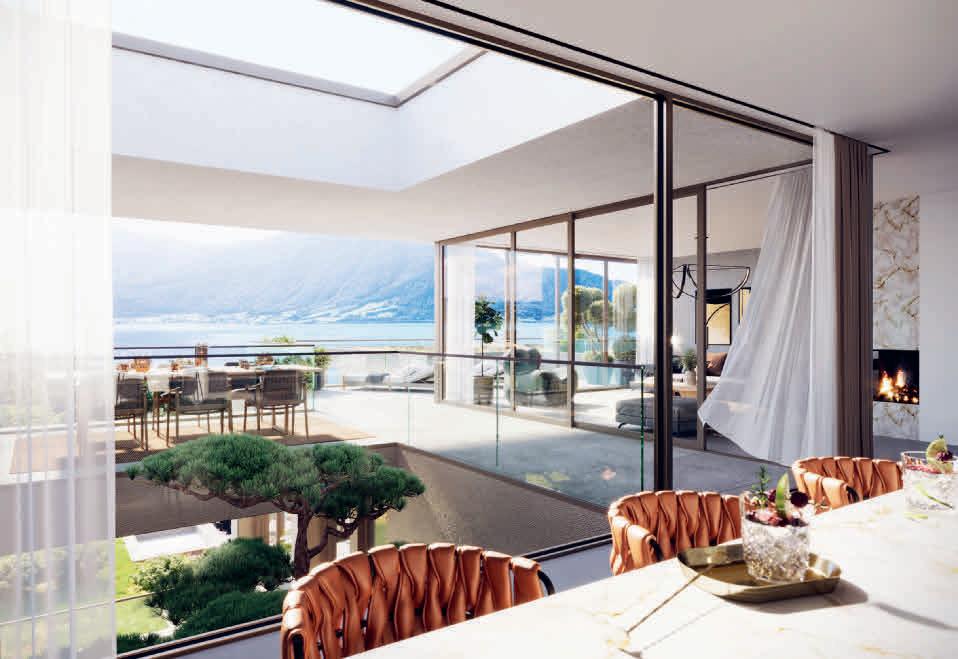
94 VIEWS MAGAZINE
If a well-balanced but luxurious life is what you are looking for, the right location is a key factor in the equation. As is a property in keeping with your personal needs and wishes: somewhere where the conditions for what you perceive as a comfortable and fulfilled life are all given. Switzerland is the perfect place to find real estate that is the stuff of such dreams. And the reasons are no secret: an enviable quality of life in stunning surroundings – and that in a country where safety is high, taxes are low and discretion is de rigueur
Two opposing forces shape the trend in demand for high-end properties: the magnetic pull of urban centres and the love of sun-drenched slopes. The most sought-after real estate is close to a village or town centre but still commands a tranquil location overlooking it, with exquisite vistas of lakes and countryside thrown in for good measure. Add in an Alpine peak or two in the background and what could be better?
Stability and continuity are two further desirable traits of Switzerland, which staunchly reveres its history and traditions. Buildings and their fittings are maintained and cared for almost religiously. Nor are the historic listed buildings that come onto the market the only ones in excellent condition: Even the nation’s new homes boast a superior architectural quality to those of other countries.
David Hauptmann, founder of Nobilis Estate AG, gave us a sneak preview of two standout properties that epitomise the high-end real estate market in Switzerland.

On the sunny slopes high over Walchwil, for example, the »Four Elements« is taking shape in a privileged, countrified setting. This high-class new ensemble features a luxury mansion, six exclusive maisonette and triplex apartments and three high-grade townhouses.
Set in the historic »Bündner Herrschaft« region, the picturesque village of Malans nestles between sun-kissed vineyards and towering mountains. Situated on the edge of the village centre, the palatial »Nobilis Estate No. 1« is a sight to behold with its baroque garden and eye-catching crenelated tower.
Eine wichtige Rolle auf dem Weg zu einem ausgewogenen, luxuriösen Leben spielt der richtige Wohnort – in einer Liegenschaft, die den individuellen Bedürfnissen und Vorstellungen entspricht und die Rahmenbedingungen für ein komfortables und erfülltes Leben schafft. Die Schweiz bietet die besten Voraussetzungen, eine Traumimmobilie für ein zufriedenes Dasein zu finden. Die Gründe sind hinlänglich bekannt: Die Eidgenossenschaft garantiert eine hohe Lebensqualität. Man lebt inmitten einer atemberaubenden Landschaft, geniesst Sicherheit, Diskretion und niedrige Steuern.
Bei der Nachfrage nach hochwertigen Liegenschaften sind zwei Tendenzen besonders ausgeprägt: Die Anziehungskraft der Zentren und der »Hang zum Sonnenhang«. Am begehrtesten sind Liegenschaften, die möglichst nahe am Dorf- oder Stadtzentrum und gleichzeitig in ruhiger Lage hoch oben liegen – mit schöner Aussicht auf See und Landschaft, am besten noch mit den Alpengipfeln im Hintergrund.
Mit Stabilität und Kontinuität hängt auch eine weitere Besonderheit der Schweiz zusammen: Das Alte und Historische wird hier noch wertgeschätzt. Gebäude und ihre Ausstattung werden kontinuierlich gepflegt und instandgehalten. Nicht nur sind die historischen und denkmalgeschützten Altbauten, die auf den Markt kommen, in überdurchschnittlich gutem Zustand. Auch die Neubauten in der Schweiz weisen eine höhere architektonische Qualität auf als in anderen Ländern.
David Hauptmann, Gründer der Nobilis Estate AG gab uns Einblick in zwei besonders markante Liegenschaften, welche beispielhaft für den High-End Immobilienmarkt der Schweiz stehen.
Am Sonnenhang hoch über Walchwil entsteht in einer privilegierten, ländlich geprägten Umgebung »Four Elements«, ein anspruchsvolles Neubauprojekt mit einer luxuriösen Mansion, sechs exklusiven Maisonette- und Triplexwohnungen und drei hochwertigen Townhouses.
Das malerische Dorf Malans schmiegt sich in der geschichtsträchtigen »Bündner Herrschaft« an die sonnigen Weinberge unterhalb der hoch aufragenden Bergmassive.
Am Rande des Dorfzentrums beeindruckt die schlossartige Liegenschaft »Nobilis Estate No.1« mit einem heiteren Barockgarten und einem markanten Zinnenturm.
»Nobilis Estate No.1« This patrician dwelling in Grisons currently comprises five separately usable apartments with any number of magnificent salons. Some also have balconies and outdoor patios. Behind every door, at the end of every hallway, spectacular new rooms await, each with its own unique atmosphere.
»Nobilis Estate No.1« Das Patrizierhaus in Graubünden umfasst derzeit fünf unabhängig nutzbare Wohnungen mit zahlreichen Salons, teilweise mit Balkonen und Aussenterrassen. Hinter jedem Flur, hinter jeder Tür eröffnen sich neue spektakuläre Räume mit festlicher Atmosphäre.


95
SUSTAINABLE GOLD
In 2013, some of Switzerland’s leading jewellers and watchmakers joined forces to create the Swiss Better Gold Association. Now, Degussa Switzerland – the market leader for investment-grade bars and ingots –is also on board.

Im Jahr 2013 bündelten einige der führenden Schweizer Schmuck- und Uhrenunternehmen ihre Kräfte und riefen die Swiss Better Gold Association ins Leben. Jetzt ist auch Degussa Schweiz als Marktführer für Anlagebarren der Vereinigung beigetreten.
As yet, responsibly produced gold is only available in very small quantities. Degussa has therefore launched its commitment by rolling out a five-gramme gold bar, playing its part in reinforcing high social and ecological standards in the gold business. The gold comes from small mines which have actively devoted themselves to improving their environmental and social impact. Some of the proceeds are reinvested into social and ecological projects around local mines. Moreover, Swiss Better Gold (SBG) accreditation ensures that every link in the value chain is fully traceable and transparent.
»We welcome this brand-new investment product,« says Diana Culillas, General Secretary of the Swiss Better Gold Association. »Gold produced by artisanal mines in line with environmental and social criteria now has a new channel via which to reach Swiss consumers.«
The Swiss Better Gold Association is the organisation behind the Swiss Better Gold Initiative, created in cooperation with the Swiss State Secretariat for Economic Affairs

96 VIEWS MAGAZINE
(SECO). The aim of the initiative is to promote small-scale gold mines as an important component of global gold production.
Artisanal und small-scale mining (ASM) for gold and other minerals gives work and sustenance to more than 44 million workers around the world. Including families and a bevy of service providers, it thus feeds around 100 million people.
Right now, artisanal producers face huge challenges in this sector. Their work exposes them to health risks, and fluctuations in the gold price have a direct impact on their living conditions. In response, the Swiss Better Gold Initiative provides technical support and training, channels financial investments into mine safety and enhanced productivity, and strives to achieve fair business conditions for all stakeholders.
Artisanal and small-scale gold mining is the source of 20% of the world’s gold production. As such, it has the potential to serve as an engine of economic growth to advance the sustainable extraction of minerals and promote new development projects.
»We are thrilled to be able to launch this world first and extend our portfolio to include the 5g SBG gold bars. In our capacity as the market leader in investment-grade gold bars and ingots, we are thus sending a powerful signal to private individuals in the market,« says Andreas Hablützel, CEO of Degussa Switzerland and all markets outside Germany, commenting on the launch. As a global player in the gold, silver and platinum markets, Degussa has, in just ten years, risen to become the market leader among Europe’s bank-independent precious metal traders. It also operates ten retail stores in Germany, as well as outlets in Madrid and London. Alongside bars, ingots, coins, numismatics and gifts in gold, clients also have access to online shops and services such as the secure custody of valuables in a personal deposit box.

Noch ist dieses verantwortungsbewusst hergestellte Gold nur in sehr kleinen Mengen verfügbar, deshalb startet die Degussa ihr Engagement mit der Auflage eines fünf Gramm Goldbarrens und leistet damit einen Beitrag, um die sozialen und ökologischen Standards im Goldgeschäft zu stärken. Das Gold stammt aus kleinen Minen, die sich aktiv der Verbesserung ihrer Umwelt- und Sozialverträglichkeit verschrieben haben. Ein Teil des Ertrags wird in soziale und ökologische Projekte von Minen vor Ort reinvestiert. Zudem sichert die SBG-Zertifizierung die vollständige Rückverfolgbarkeit der Wertschöpfungsketten. Diana Culillas, Generalsekretärin der Swiss Better Gold Association: »Wir begrüssen dieses neuartige Investmentprodukt. Nach Umweltund Sozialkriterien produziertes Gold vom Kleinbergbau findet so einen neuen Weg zu den schweizerischen Konsumenten«.
Die Swiss Better Gold Association ist die Trägerin der Swiss Better Gold Initiative, welche gemeinsam mit dem Schweizer Staatssekretariat für Wirtschaft (SECO) ins Leben gerufen wurde. Die Initiative verfolgt das Ziel, handwerkliche und kleine Goldminen als wichtigen Bestandteil der weltweiten Goldproduktion zu fördern.
Artisanal und Small-Scale Mining (ASM, Gold und andere Mineralien) schaffen Beschäftigung und Einkommen für über 44 Millionen Arbeiter weltweit und ernähren rund 100 Millionen Menschen, darunter Familien und verschiedene Dienstleister.
Der Sektor stellt gerade die KleinstbergbauProduzenten vor grosse Herausforderungen: Die Arbeit birgt gesundheitliche Risiken und die Schwankungen des Goldpreises wirken sich unmittelbar auf die Lebensverhältnisse aus. Die Swiss Better Gold Initiative stellt deshalb technischen Support und Schulungen bereit, lenkt direkte Finanzinvestitionen in die Minensicherheit und die Verbesserung der Produktivität und versucht faire Geschäftsbedingungen für alle Beteiligten zu schaffen.
Artisanal and Small Scale Gold Mining (ASGM) hat als Quelle von 20% der weltweiten Goldproduktion das Potenzial, als Wirtschaftsmotor zu fungieren, um die nachhaltige Gewinnung von Mineralien voranzutreiben und neue Entwicklungsprojekte zu fördern.
»Wir freuen uns über die Lancierung dieser Weltpremiere und die Erweiterung unseres Sortiments mit dem 5g SBG Goldbarren. Als Marktführer von Anlage-Goldbarren, setzen wir damit auch für Privatpersonen ein starkes Zeichen im Markt«, kommentiert Andreas Hablützel, CEO von Degussa Schweiz und allen Märkten ausserhalb Deutschlands, die Lancierung. Als weltweit operierendes Unternehmen für Gold, Silber und Platinmetalle ist die Degussa innert zehn Jahren zum Marktführer unter den bankenunabhängigen Edelmetallhändlern in Europa aufgestiegen. Darüber hinaus unterhält die Degussa zehn Ladengeschäfte in Deutschland sowie an den Standorten in Madrid und in London. Neben Barren, Münzen, Numismatik und Goldgeschenken stehen den Kunden Onlineshops und Services wie beispielsweise die sichere Verwahrung von Wertgegenständen in einem persönlichen Schliessfach zur Verfügung.
TO LIVE AGAIN
Back to nature, conscious living with your foot off the gas: Since time immemorial, creatives have sought refuge and inspiration in the remote villages of Ticino.
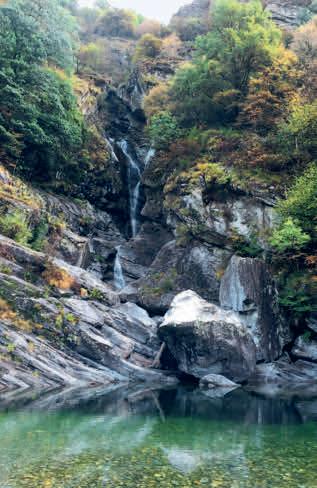
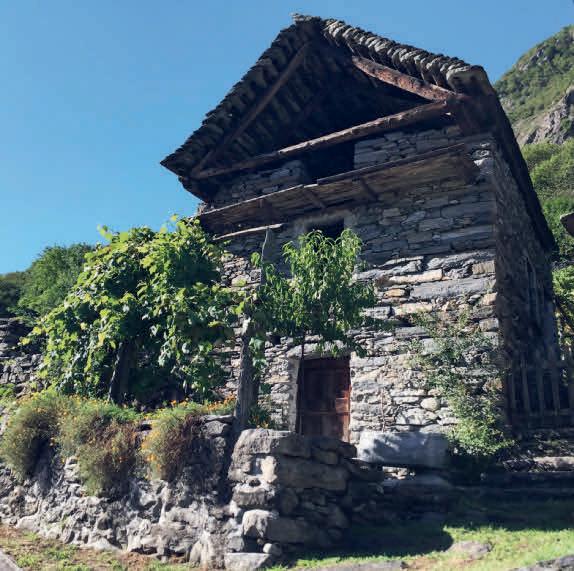
Entschleunigung, zurück zur Natur, bewusster leben: Seit jeher sind die abgeschiedenen Dörfer des Tessin Rückzugsort und Inspirationsquelle für kreative Menschen.
Giumaglio in the Maggia Valley is an isolated, largely unspoilt corner of the planet. In summer, the parched riverbeds exude an uncanny beauty. In spring, gentle streams morph into writhing, leaping, liquid devils as they romp down the mountainsides. Jagged rocks strain toward the sky. Rows of pergolas fashioned from fragrant Americana grapes provide aromatic shades. Chestnut trees defy wind and weather. Untamed nature shapes architecture and bonds the people here in a unique way.
In this microcosmic paradise, the Domeisens have collected run-down and abandoned vernacular architectural objects, a couple of rusticos and a grotto (cave) on an idyllic hillside at the periphery of the village's centre and the entrance to the long, upward hike to the Alps. For the family, who work as artists and jewellers in Zurich and Rapperswil, restoring these listed dwellings takes decades of commitment to preserving the authentic signature of the village while saving these historical objects from falling into disrepair. The family's dream is one day, together with the members of the village's Patriziato restoration committee, to create a Culture Park comprised of restored rusticos, a grotto, a vineyard and a studio for artists.
Giumaglio im Maggia Tal: ein abgelegenes, weitgehend unberührtes Fleckchen Erde –im Sommer strahlen die ausgetrockneten Flussbette eine eigentümliche Schönheit aus, im Frühjahr werden sie zu romantischdämonisch tosenden Gebirgsbächen, schroffe Felsen ragen gen Himmel, duftende Americana-Trauben sorgen für aromatische Akzente. Kastanienbäume trotzen Wind und Wetter. Die ungezähmte Natur prägt die Architektur und verbindet die Menschen hier auf einzigartige Weise.
In diesem paradiesischen Mikrokosmos haben die Domeisens einige verlassene Rusticos und eine Grotte auf einem idyllischen Hügel am Rande des Dorfzentrums erworben. Hier beginnt der Anstieg in die wilde Bergwelt. Für die Familie, die als Künstler und Juweliere in Zürich und Rapperswil tätig ist, erfordert die Restaurierung dieser denkmalgeschützten Wohnhäuser jahrzehntelangen Einsatz für den Erhalt des authentischen Charakters des Dorfes, gleichzeitig retten sie diese historischen Objekte vor dem Verfall. Der Traum der Familie ist es, eines Tages gemeinsam mit den Mitgliedern des Patriziato-Restaurierungskomitees des Dorfes einen Kulturpark zu schaffen, der aus restaurierten Rusticos, einer Grotte, einem Weinberg und einem Atelier
98 VIEWS MAGAZINE
für Künstler bestehen soll.
Even in the dry months, countless waterfalls bubble their idyllic way down into the valley: a glimpse of paradise, if ever there was one. Idyllisch plätschern die unzähligen Wasserfälle in den trockenen Monaten zu Tal, die Szenerie darf getrost als paradiesisch bezeichnet werden.


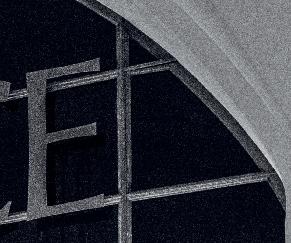












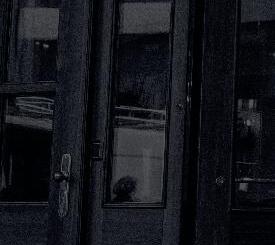









100 VIEWS MAGAZINE
»How badass were these guys?«
Photos Matthias Mederer ramp.pictures
Reproduced with the kind permission of ramp magazine and Lukas Hüni AG
Alright, throw caution to the winds. Just let the Countach hit your consciousness. It is so in your face. Every time. You see it, and … WOW! Its bizarre, rugged silhouette is like an apparition from another planet.

It also gives us the perfect opportunity to discuss all things Lamborghini with its owner.

101
Interview Michael Köckritz
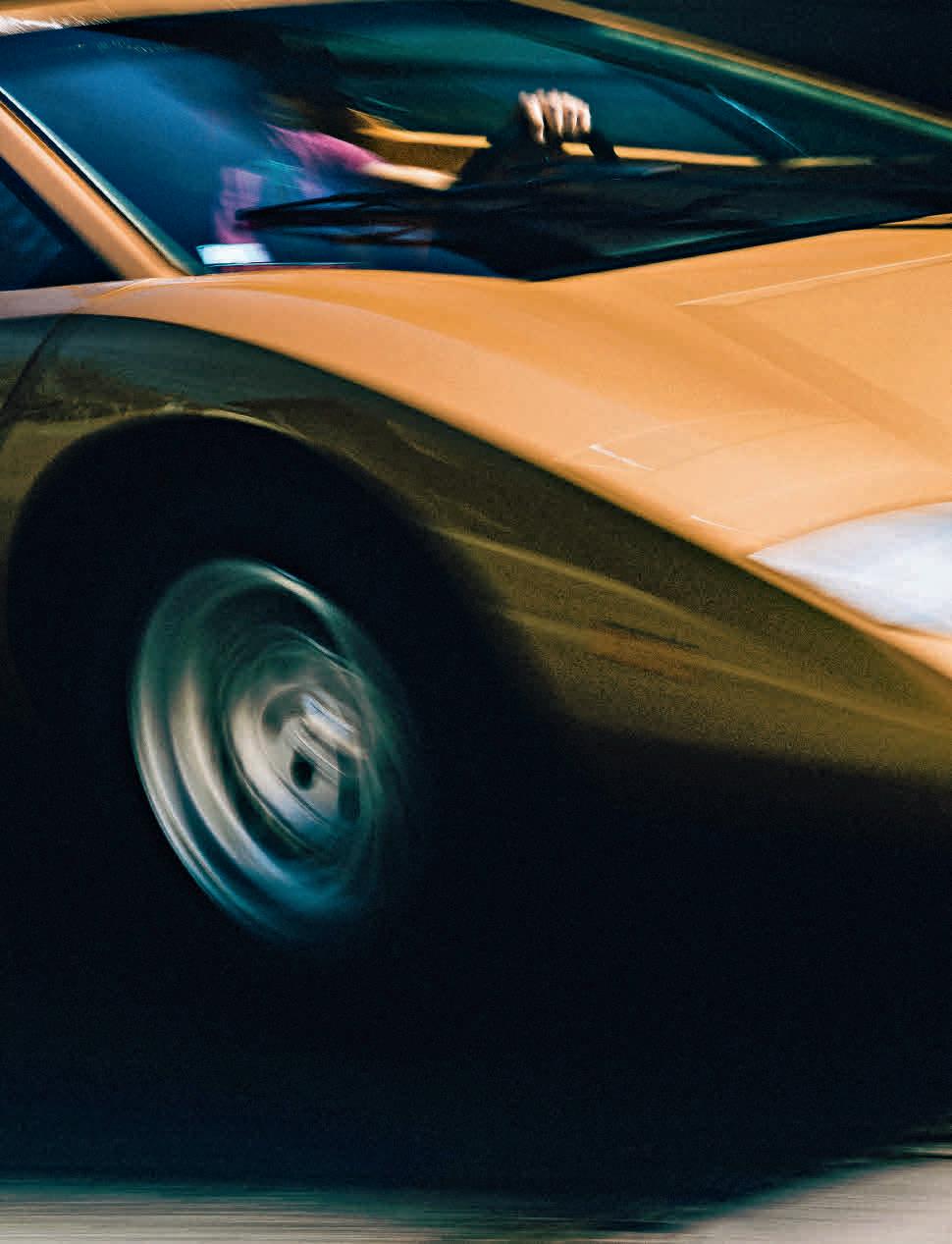



Mr. Pohl, how would you define the Lamborghini brand?
Lamborghini is likely the most emotional brand ever. It’s an uncompromising statement. Which also means that I don’t feel like driving my Lamborghini every single day. I have to be in the right mood for it. It’s always the same: When you drive up to or past people in a Lamborghini, it invokes an involuntary response. Either they are appalled and let you know it, or they celebrate you. It’s almost as if you feel offended when somebody ignores you. That says quite a lot about the brand itself.
And people are always looking at you … Exactly. Especially when you get out of the car. People are watching your every move. You should be confident about what you do and how you come across. And that’s what the brand is essentially about, in my opinion. Lamborghini is a highly emotional brand, and it’s awesome to drive. Irrespective of the technical differences among the individual models and their characters. A Huracán, for instance, with its V10 engine, is, apart from the lack of space, quite suitable as a daily driver. It’s an easy ride. You can drive it mercilessly, of course, but when you hit its limits on the racetrack, its good nature shows, I would say. The Aventador, on the other hand, is wicked. The sequential gearbox is vicious! To me, it always feels as if you’re trying to ride on a dragon. The first few moments aren’t really fun. You can always waver, somehow. That’s also Lamborghini. It’s a statement all by itself.
What was your first contact with the brand?
My first contact was a golden Miura from the late 1960s that I had in my Matchbox car collection in the early 1970s. At a scale of 1:24. I also had the same model in purple. These two were my absolute favourites.
Do you still have them?
I do, but they’re quite worn and don’t look so nice anymore.
Besides a Miura, you also drive a Countach. How did that come about?
That’s a good question. Actually, I found the Countach had too many spoilers and planks. It wasn’t my style, really. My first memories go back to red Countachs in the 1980s. I found them quite challenging. And the pimp image wasn’t my thing either. When I was in a position to afford these kinds of cars, I found the Countach quite okay, but preferred not to own one. That was because I had never seen a Periscopio before. I don’t know why I never came across it, not even online. But when I first laid eyes on it, I knew I had to have it. That one was like made for me. The purity of the design – just wow! Only then did I begin to study the car in greater depth and saw how close the design was to the prototype. I realised that they had really created a sculpture, as if it were cut from a single mould. At the same time, I was obsessed with the idea that I needed to own a golden
Lamborghini. And that’s exactly the car that had previously been offered to me. Only that I had, at the time, just purchased the Miura and didn’t want to spend so much money on yet another car. First, I wanted to be clear about what owning one does to a person and how it feels driving it.
And you were content?
[laughs] I was elated! And about one and a half years later I was positive that I also needed a Periscopio. I really regretted not having bought it when I had the chance. So I started to research and ultimately found it again. Then I bought it.
What makes this car special? It’s a very early Countach.
It’s an early model and that means it’s very low. That’s why it’s not comfortable for me to sit in. Of all the cars I own, it’s by far the most uncomfortable. In the Miura, I took out the original seat and replaced it with a bucket seat that we mounted on the base plate with the original screw fittings. The bucket seat looks almost like the original seat, but it offers me the few critical centimetres of head space that I need. The Countach hasn’t been touched yet. We have to see if a solution like that could work here too, because I obviously don’t want to drill a hole or make any significant changes. Just sitting more comfortably would be great. The car itself just rocks! When I’m on the road with it, people who see it almost seem to faint. It’s a surprisingly nice drive, too. Despite the narrow tires.
How tall are you, if we may ask?
One metre ninety. That’s not particularly tall, but I have quite a long torso. So when I sit, I need to tuck my pelvis quite far back to have enough space for my upper body. And I keep touching the indicator lever with my knees. Indicating left is almost impossible, unless I simultaneously step on the clutch; when I release it, however, I turn the indicator off again with my knee.
And apart from that?
Well, there’s one or two things where you can tell that it’s an early model that needed adaptations later on. Transverse engines, for instance, have a tendency to take their time at moderate speeds when you’re trying to rev it up. Downdraft carburettors like in the Miura don’t have this issue. The later Countach models also have a downdraft carburettor.
Why did they opt for the transverse engine in the early Countach?
One reason might be that the downdraft carburettors don’t look as appealing. Even this decision indicates that, back then at Lamborghini, they were completely uncompromising when it came to the design. The only compromise they most likely made were the now legendary air intakes in front of the engine that were simply necessary to cool it down. With the Periscopio, you can see that the design ruled every single decision. They wanted to build a wedge. They just wanted to design a car from another planet that defied any and all conventions, in terms of the exterior as much as the interior. And they pulled it off. That’s what impresses me the most.
What’s your favourite perspective?
Just the side view, slightly from above, when it’s passing by. From this point of view, the car appears very long. The wedge shape comes across very well and still you can see the entire structure and gimmicks they used. You see the roof that is unique to the Periscopio. And this crude idea of installing a periscope rear view mirror. It doesn’t work at all, but I do get the design intention perfectly. It must have been a brilliant time for designers – along the lines of »No matter what we do, it’ll be wicked.« This car is a symbol of that era.
How does it feel to drive it in daily life?
Driving a Periscopio doesn’t give you the right to judge others. Cars that old do have their individual quirks and flaws. Mine, for instance, has a problem starting up when the engine is hot. When the engine
104 VIEWS MAGAZINE
Armin Pohl was introduced to Lamborghini in the form of the Miura. For a long time, the Countach left him cold. Then he saw an early LP400 »Periscopio«. In gold. That fundamentally changed the way he saw the brand.

is running, it runs smoothly. But don’t try to start it again once it’s been warmed up. If that happens, you have to play around to get it going again. So I wouldn’t say it’s a car for every day. It’s got quite a spacious boot, though. You can actually use it for shopping.
And when you’re taking it for a sporty drive?
It’s surprisingly fit in this regard. There is very little load change in turns. And the gearbox purrs so beautifully, especially when it’s still cold. The mechanical, buzzing sound is quite something. And when it’s warmed up, it runs very smoothly. That’s great fun!
How do you get in and out?
Well, I get in with my butt first, and then I pull in the feet. Getting out, I put my left hand on the rocker panel, my feet out and then I pull myself up. I had to practice this a few times before my first stop at a petrol station. By the way, the car has a tank capacity of 120 litres, two tanks with 60 litres each. They are refuelled separately on the right and left sides. If you have the space, you can park between two pumps and fill both sides up at the same time. That’s something to see!
Where do you go when you feel like taking the Countach for a drive? Stuttgart?
No, it’s not so much fun in the city. I prefer taking it out into the Swabian Alb, driving down winding country roads at medium speed. The car also does great on the autobahn, it performs well under pressure. But I have to say that I haven’t pushed it to its limit. I’ve revved it up to 6,000 rpm, though it peaks at 7,500. According to my GPS, I hit 230 km/h, but the speedometer said 260. Back in the day, they used to be more generous in this regard. [laughs]
Do you see the characteristics of the Countach in any recent models?

To be honest, Lamborghini hasn’t made a new car since the Countach that has had a similarly formative impact on the brand. To me, the Miura is still the most beautiful car ever designed. Interestingly, Lamborghini made a complete U-turn afterwards and presented another ultra-avantgarde vehicle, the Countach, right after that. In my garage, the two models are parked right next to each other, and every time I see them, I think: »I can’t believe it! They made these totally different cars one after the other. How badass were they back then?« In my opinion, the Aventador with its aspirated V12 engine is in the direct lineage of the Countach. And most likely it’s also the last of its kind: scissor doors, a longitudinally mounted V12 engine. It’s clearly still got the wedge shape, but it’s technically advanced. You can see all the details, including the air intakes, that you find in the Countach. The same is true for the Huracán, slightly adapted and with a tencylinder engine. Only the Urus doesn’t follow in the lineage. I honestly don’t see any resemblance at all. But I’m also not the SUV type and wouldn’t buy a Urus. It’s for a different clientele.
Do people react in the same way to a new Lamborghini?
They definitely do to the Aventador. It’s got a very similar character to the Countach, as I said. It’s a bit of a beast: slightly too loud, too wide, too big. The Huracán has the same qualities but is a bit more accommodating. You can tell by how people react. Of course people turn their heads when they see a Huracán. But when a little boy sees an Aventador, he will literally fall off his bicycle as he turns his head to stare.
Which of the recent Lamborghinis do you prefer and for what occasions?
I like the Aventador SVJ in the summer, in part because it’s a roadster and everything works just slightly better than in the Aventador S. The Huracán Performante is the one for narrow bends.
Do you think Lamborghini as a brand has a future in the face of current industry developments?
I keep asking myself the same question. What will the inevitable post-combustion era bring? Will all old cars become unaffordable
because everyone wants to get one? The current sales figures suggest that, although it is to be expected that they will be banned from city centres in the near future. What will people do with them in that case? When self-driving cars become more widely used, they won’t be welcome on the freeway either. It really is a good question: Where will Lamborghini fit in?
What about a Lamborghini with an electric powertrain?
Lamborghini has already presented some electric concepts. I believe you can use this technology and still build a highly emotional car. I even think that Lamborghini will do it. The vehicles will, however, have to earn their status even more through extreme design language and a totally outrageous performance experience, beyond anything previously known. For me, the brand’s essence is a combination of design and exaggeration in any conceivable way.
Will premium customers go along with this?
I think we can already see a noticeable trend among the premium brands towards extreme racing vehicles that won’t get road approval. People will rent entire racetracks for a weekend and have a good time there. It’s not only that it’s no longer possible to take these cars for a drive on public roads, but also that social acceptance is dropping to zero. Today, you’re no longer celebrated for having a car like that; instead, people hate you for it. And you don’t want to expose yourself to this all the time. That’s why I think that owners of these kinds of cars will form their own elite circles and the general public will be left alone.
What’s the appeal of such ultra-extreme driving machines?
I guess it’s this primal vision of the open road and the feeling that man can tame the beast. That’s what Lamborghini has stood for, always. Thinking about this now, I have to admit that it would have been best to be young and wealthy in the 1960s. Ideally in Italy. We still feed on this dream today. But the social pressure is increasingly pushing this dream back into the world of imagination.
What does driving mean to you in general?
Total concentration and having as much fun as possible. I like to drive fast. But I don’t intend to put anyone at risk, including myself. But for me, driving is definitely more than just getting from A to B. Every metre counts.
You have two daughters. How do they feel about cars?
Surprisingly, they both celebrate cars, but in different ways. My younger daughter, who just turned eighteen, digs supersized American cars and drives them as if it were the most natural thing in the world. My older daughter loves all things Italian. For her, the sound of a V12 Aventador is the greatest thing ever! My wife prefers comfortable vintage cars. She’s also more critical of speed and doesn’t join me when I go out for a drive. Funnily enough, she enjoys watching Formula 1. But she hasn’t been on a racetrack yet. She prefers watching it on TV. That way she can follow the race better, she says.
106 VIEWS MAGAZINE
»Driving a Periscopio doesn’t give you the right to judge others.«





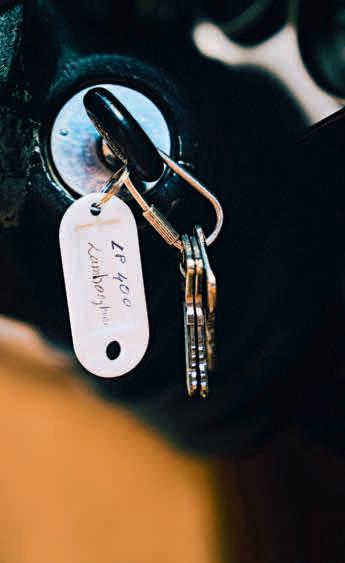


»The Aventador has got a very similar character to the Countach. It’s a bit of a beast: slightly too loud, too wide, too big.«

109
ARMIN POHL ( 54) is a graphic artist and CGI visionary. He joined Mackevision Medien Design in 1995 and quickly recognised the possibilities of computer generated imagery, leading the company to international success that included an Emmy win for its visual effects work on Game of Thrones. He retired from the company a year ago and now devotes most of his time to his cars and his orchard.

Lamborghini Countach LP400 »Periscopio«

ENGINE Naturally aspirated V12
DISPLACEMENT 3,929 cc




POWER 375 hp (276 kW) at 8,000 rpm
TORQUE 361Nm at 5,000 rpm
0-100 KM/H Approx. 5.4 s
TOP SPEED 288 km/h
110 VIEWS MAGAZINE
»It would have been best to be young and wealthy in the 1960s. Ideally in Italy.«



SUBSCRIBE ONLINE NOW! Visit our online shop at shop.ramp.space, order ramp/rampstyle and have it delivered directly to your home. Sign up for a combination subscription of ramp & rampstyle and save 20%! Legal notice: You have the right to cancel this agreement in writing within fourteen days, without needing to provide a reason, by writing to: ramp customer service · ramp@primaneo.de · T +49 40 236 703 856 · In the event of cancellation, there will be no further costs to pay. /ramp.space /ramp.space shop.ramp.space

ONE-STOP SHOPPING
»Everything comes to you at the right time, so just be patient,« they say. Fair enough. And for those who prefer to give fate a helping hand, there is always Zurich’s Bahnhofstrasse. Beginning right outside the Baur au Lac, this exclusive shopping boulevard with its side streets and arcades harbours no end of surprises. This is where your wishes come alive and your dreams come true.

113
SHOPPING VIEWS


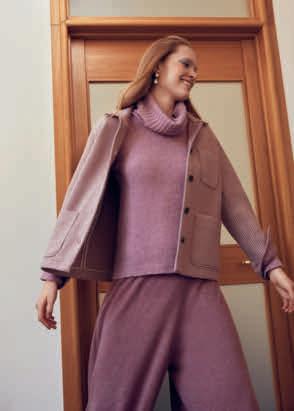
SHOPPING VIEWS
COLOUR ME ADVENT U ROUS
HAWICO
Hawico is proud to announce its latest collection: Autumn/Winter 2023. Inspired by exploration, togetherness and a sense of adventure, this collection includes a variety of new textures and colours.
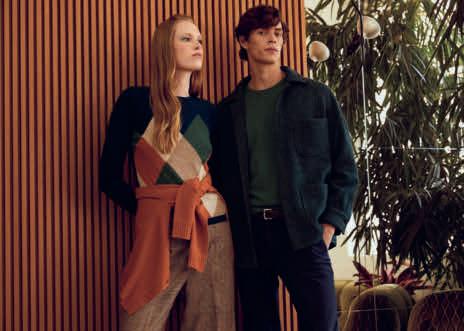

Referencing vintage motifs such as argyle, paired with modern shapes and new colours, the collection is about enjoying the new while giving a respectful nod to the past. This season, Hawico has crafted textures and designs that move with you. Jacquard houndstooth fabrics, flat knits and cable designs showcase its unique technical abilities and dedication to excellent quality. Great for layering and keeping warm outside, this collection’s pieces are ideal for embracing new adventures. Whether you’re off to discover uncharted territory or strolling through the local park, these cashmere designs are the perfect travelling companions.

Looking at the colours of this collection, you’re spoiled for choice. The rich tones of Fairisle, Blueprint, Goblin and Mauve are beautifully complemented by bold Green Jungle, Blue Gairney Water and Orange Spice hues. Rounding out the collection, Tea Green, Swansdown and Black work well as strong neutrals. Order any cashmere style in your favourite AW23 colour with our complimentary bespoke »create-your-own« service. Enjoy one-of-a-kind style, uniquely made for you in Scotland.
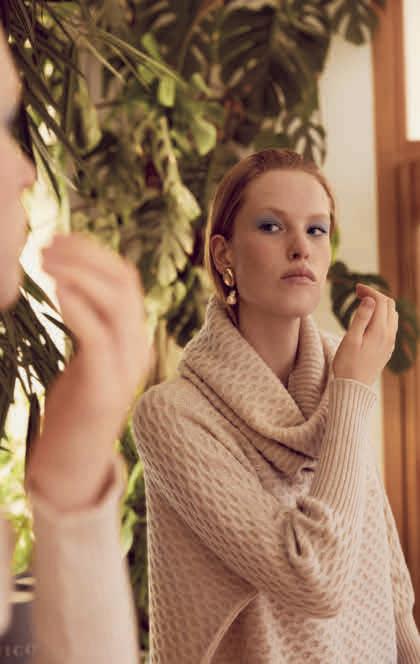
115
SHOPPING VIEWS
A ROYAL VISIT
HAWICO















In this special coronation year, VIEWS is dutybound to honour Charles III’s ascent to the throne.
Rummaging through the archives of cashmere specialist Hawico, we unearthed this 2019 snap of a heavily laden then-Prince Charles of Wales apparently sharing a joke with the company’s owners, father Jim, daughter Philippa and son Matthew. The items in His Majesty’s ‘haul’ are undoubtedly still fit for a king to this day.

FIND YOUR FRAGRANCE

OSSWALD PERFUMES


















Buying fragrances online? No way! Or is there? There is, and the perfume experts at Osswald are showing the way. The team has drafted a catalogue of questions which enable customers to find just the right scent.



An online tool on the website analyses the replies and puts together a selection of five individually curated fragrances. Osswald staff then bottle the scents by hand, label them, pack them into the newly designed »Osswald Find-YourFragrance-Box« and rush them off to you. In the comfort of your own home, you can try them out at your leisure, experiencing how each composition unfolds on your skin over time – and seeing which one draws the most compliments. Having each one bottled by hand lets you try out products that are not normally available as samplers. Either way, your fragrance of choice can be ordered at a generous discount once the test phase is completed.

116 VIEWS MAGAZINE
SHOPPING VIEWS
HISTORIC ALLURE
ASPREY
British jeweller and purveyor of luxury goods Asprey is synonymous with refinement. Especially the bejewelled handbags, but the plainer models too make unique investment pieces.

Rare skins and distinctive colour tones are guaranteed to attract attention. Named after the year of Asprey's inception, the 1781 collection delights the eye with a bouquet of fresh hues. The black Taylor Crossbody bag will definitely become a classic.

Asprey’s iconic Daisy Heritage collection
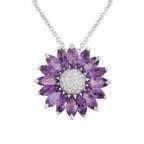
This is a present-day interpretation from the house’s archives, featuring modernised designs in a plethora of colour options. Hallmarks of the collection include individually set marquise stones forming the delicate petals of the English daisy. Variants are available in precious stones including amethyst, diamond and citrines, with the centre of each flower fashioned from brilliant-cut diamonds, all set in 18ct gold.

A TOAST TO THE KING!
ASPREY























To mark the coronation of King Charles III, each handmade, mouth-blown crystal decanter in this series is intricately etched with the official coronation emblem.
The matching tumblers are engraved with the royal cyphers of Their Majesties King Charles and Queen Camilla. The lion’s head, a signature element in Asprey’s quintessential series and chosen for its significance in the sovereign’s coat of arms, was hand-crafted by the highly skilled master artisans at Asprey’s London workshops, wrought from sterling silver gilt for this special edition. In keeping with time-honoured Asprey tradition, the first decanter set will be personally presented to His Majesty.

The Leigh jewellery case is part of a special edition of three cases realised in a new purple chevre leather and velvet interior. Each interior lid is hand-embroidered with the official coronation emblem designed by Sir Jonathan Ive.










117 SHOPPING VIEWS
T Y ING THE KNOT


GRAFF
The soft fluidity of a silk bow freshly tied by hand is embodied with exquisite grace on the Graff Tilda's Bow jewellery watch.
Delectably feminine, this exquisite time-telling jewel is powered by a quartz movement and borne on a three-row white diamond strap. The radiant curves of a freshly tied ribbon of pink diamonds illuminate the pavé diamond dial of this white gold Tilda’s Bow watch.

ST Y LE AND SIMPLICIT Y







GRAFF

Inspired by a peerless devotion to the world’s finest diamonds, the Laurence Graff Signature collection is a contemporary classic that translates the hypnotic beauty of diamonds into angular, multifaceted jewels.

The Laurence Graff Signature collection offers stylish wedding bands, engagement rings, bangles, pendants and earrings in rose, yellow and white gold. The wedding bands can be stacked with other designs to give each look a timeless appeal and more than a touch of chic. The beauty of these bands lies in the minimalist design, but also in the variety of stones: From traditional round diamonds to the more contemporary marquise, pear and heart shapes, the Laurence Graff Signature collection is made for the modern woman who loves simplicity. »Stone-led craftsmanship,« as Graff calls it, simply means that every piece is painstakingly hand-crafted in deference to the natural shape of the diamond.







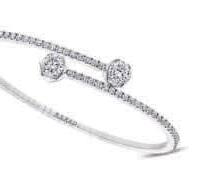




118 VIEWS MAGAZINE
SHOPPING VIEWS
FLAWLESS FANTASY















In January 2023, Graff unveiled an exceptional new creation during Paris Couture Week: a necklace of incomparable beauty and craftsmanship.



Featuring an extraordinary and rare 50ct D Flawless oval diamond accompanied by 100 carats of pear-shaped, emerald-cut, oval, round and baguette-cut diamonds, this breath-taking piece was unveiled in Paris. The design explores and expands on contemporary motifs first seen in the Tribal collection launched in 2021. Myriad layers of diamonds and contrasting cuts sculpt the light into bold new forms, enhancing the necklace’s exhilarating sense of depth and perspective.





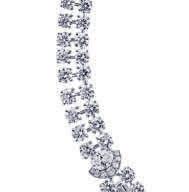
Centred around a magnificent 50ct oval diamond, every element of this powerful, abstract design is intended to emphasise the elegant, rounded silhouette of the stunning stone at its heart. Like the ripples that emanate outwards when a stone falls into water, the design tempo increases as the gems graduate in size on the necklace, reaching a crescendo with the centrepiece where the full force of the 50ct diamond is concentrated.


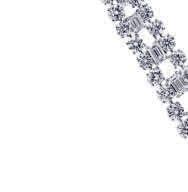
Discovered in Lesotho, source of the majority of the largest gem-quality diamonds found this century, the 50ct D Flawless stone measures more than 30 x 20 mm and is majestic in its beauty, boasting remarkable brilliance, fire and proportions.




Graded by the GIA as ExEx with excellent polish and symmetry, the stone’s incredible size, combined with its perfect colour and clarity, puts it firmly in the unparalleled league of important diamonds that Graff has collected and cared for throughout its 63-year history.


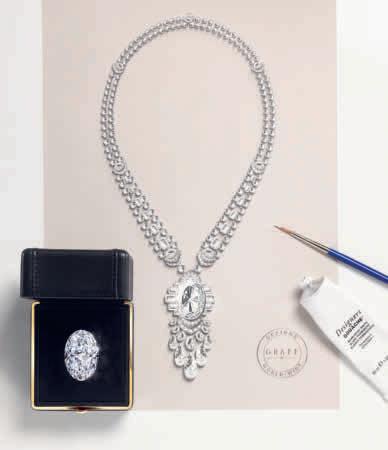
119
SHOPPING VIEWS
GRAFF Couture
AGELESS ARTWEAR






DOMEISEN









Each Domeisen jewellery piece becomes a wearable work of art that embodies ideas, value and character, where each sculptural jewelry form forges a symbiotic embodiment of gemstones and gold alloy.
Inspired by his father and the family’s rich legacy of numerous notable master goldsmiths of Zurich and Rapperswil between 1430 and 1750, Jörg Domeisen, a gemologist and master goldsmith himself, and his wife


Liz Kim, a visual artist, have been creating timeless masterpieces and collectibles for over two decades. They continuously present their newest work in their showroom and salon in the heart of Zurich at In Gassen 7.
Above: Three rings from the Butterfly Dream collection. Below: The Pompeii collection. Necklaces and bracelet derive from lineal compositions expressing time, rhythms, textures and light.
ORDER OUT OF CHAOS




BUCHERER

The Rock Diamonds collection from Bucherer Fine Jewellery is a set of sparkling creations whose out-of-the-ordinary forms are as enchanting as they are surprising.



Every item in the collection is a masterful play on contrasts that add up to a sublimely harmonious whole. The high jewellery pieces unquestionably rank among the highlights of this collection, reflecting the elegant but elaborately effortless interplay of choice elements. Asymmetric arrangements of trapezoidal diamonds share the stage with simple, polished gold elements and brilliant-cut diamonds in a fascinating play on forms, effects and luminant radiance. The idea was to reconcile balance to imbalance, creating profound harmony and elegance out of organized gemmological chaos. Even on closer inspection, the individual elements appear to hover in ethereal proximity to each other.

120 VIEWS MAGAZINE SHOPPING VIEWS
MEDI TERRANEAN MARVELS
BVLGARI
Bulgari showcases the pinnacle of high jewellery by retracing an imaginary trip across the Mediterranean Sea – the cradle of civilization, an inexhaustible source of inspiration layering multiple arts, traditions and crafts.
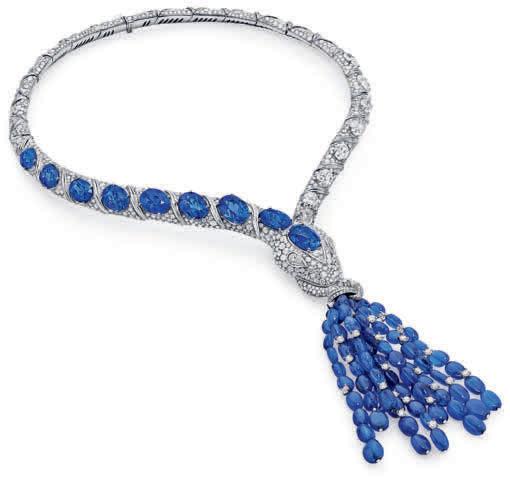
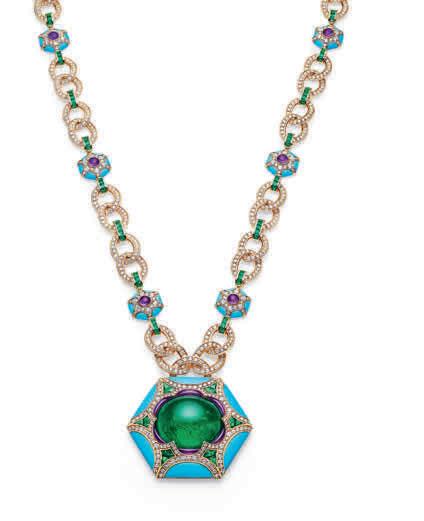

The Roman jeweller's newest collection of high jewellery and high-end watches, Mediterranea, is born of audacious creativity and exceptional craftsmanship – a masterfully multifaceted take on themes picked up in the nooks and crannies of time and space. Relentlessly inspired by the pioneering vision of the company’s founder, Sotirio Bulgari, who, like a modern Aeneas, left his homeland Greece and travelled across a range of Mediterranean countries before settling in Rome and building its outstanding success, Bulgari’s eclectic vision has experimented with an assortment of references, giving life to a kaleidoscopic collection of unparalleled jewellery creations.
Cross-pollination, eclecticism and syncretism become the key concepts in a captivating blend of Mediterranean inspirations connecting Eastern and Western cultures, Byzantine and Roman vibes, the spices of North Africa and echoes of southern Italian Baroque sumptuousness.
121 SHOPPING VIEWS
MAGIC AND MISCHIEF
CHOPARD
1 Red Carpet Collection Watch
A jewellery watch in Fairmined-certified ethical 18ct white gold, entirely set with diamonds and emeralds. Chopard's tireless Co-President and Artistic Director Caroline Scheufele once again gives vent to her zest for life, the eclectic tastes that drive her prolific inventiveness – and a dazzling capacity to arouse forceful jewellery emotions.

2 Animal World Peacock Watch
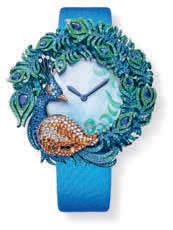
The adventure continues with a 'Peacock' jewellery watch from the Animal World Collection, reviving the world of mischief and infinite beauty that has made the collection such a success. This jewellery watch in ethical 18ct white gold and titanium is set with sapphires, Paraiba tourmalines, white, cognac, black and brown diamonds, tsavorites and luzalites.
YES, WE CANNES!
CHOPARD


To mark the 75th Cannes Film Festival, Caroline Scheufele chose the theme 'Chopard Loves Cinema' as the inspiration for the Red Carpet Collection.
She thus dreamed up 75 haute joaillerie creations as an epic saga tracing the grand adventure of cinema from its early blackand-white charms to its dizzying contemporary colours. Like a film director, this keen lover of the seventh art has devised a high jewellery collection liberally rooted in fabled scenes from Scheufele’s favourite movies. Chopard uses Fairmined-certified ethical 18ct white gold for this entire collection.
3 Bead necklace featuring peridots, tsavorites and apatites set with coloured sapphires, amethysts, sapphires, tsavorites, rubellites, mandarin garnets and spessartites.

4 Emerald bead necklace featuring a titanium medallion set with opals, sapphires, emeralds, Paraiba tourmalines and turquoises. 5 Earrings set with cabochon-cut emeralds, turquoises, moonstones, amazonite, agate, tsavorites, chrysoprase, jadeite, emeralds, chalcedony and Paraiba tourmalines. 6 Bracelet with a cushion-cut kunzite, a cabochon-cut sapphire, rubellites, diamonds, amethysts, blue sapphires, pink sapphires, tanzanites, emeralds and rubies.
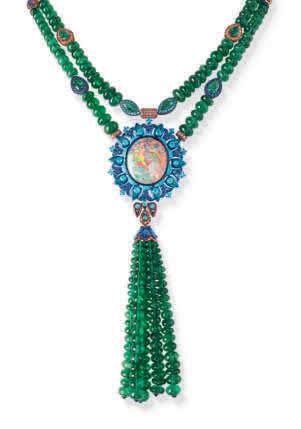
122 VIEWS MAGAZINE
SHOPPING VIEWS 1 2 6 3 4 5
LOVE ME SLENDER











CHOPARD
1 The Alpine Eagle collection of sporty-chic timepieces has been enriched by two 41 mm diameter models adorned with a dial in an original pine green colour. Like Aletsch blue, Bernina grey and absolute black, pine green is inspired by the palette of natural colours which shape the beauty of the Alpine biotope.


2 Alpine Eagle 33: Chopard has enhanced its collection with a new case size designed for smaller wrists. In addition to the existing 36, 41 and 44 mm sizes, the new models feature a 33 mm diameter case while preserving its customary harmonious sense of proportion and contemporary allure.





3 L.U.C XPS 1860 Officer: A 50-piece limited edition in ethical 18ct yellow gold. Distinction meets discretion in this ultra-thin timepiece with an officer-type back cover.

WATCH AND PLAY






CHOPARD















The Happy Sport collection welcomes three new creations in a delightful palette of blue.


4 Three dancing diamonds are at the heart of this 30 mm diameter watch designed to fit even the slimmest wrist. From case to bracelet, it is made entirely of stainless steel, framing a softly luminous sky-blue dial.



5 A second edition of the Happy Sport watch plays on the marriage of materials with a 36 mm diameter stainless steel case paired with a crown and cabochons in ethical 18ct rose gold. The navy-blue dial with its five twirling diamonds matches the colour of the leather strap. Both the hour-markers and the hands are gilded to reflect the tone of the crown and cabochons.
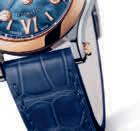

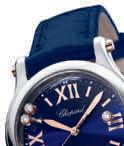
6 Finally, in a third and final 36 mm version, ethical 18ct rose gold adorns the bezel in addition to the crown and cabochons. The textured mother-of-pearl dial facilitates a fascinating blue colour gradient, setting the stage for the whirl of seven dancing diamonds.




123
SHOPPING VIEWS 3 1 2 4 5 6
PERPET U AL PERFECTION














ROLEX






















1 Oyster Perpetual Yacht-Master 42: The formidable fusion of form and function. Made in RLX titanium, a grade-5 alloy, this watch is both durable and lightweight. The intense-black dial is exceptionally readable. An Oysterlock safety clasp prevents any inadvertent opening of the bracelet.




2 The Oyster Perpetual 31 sports a ‘Celebration’ motif on its turquoise dial. This brand-new design revisits the bright colours used on the enamelled dials unveiled in 2020: candy pink, yellow, coral red and green bubbles set against a turquoise background.



3 Oyster Perpetual Day-Date 36: An 18ct white gold timepiece with a diamond-studded dial, diamond bezel and President bracelet. The turquoise dial is available exclusively on the gold and platinum models. 4 Oyster Perpetual Explorer 40: Crafted from solid Oystersteel, this model features typical Chromalight 3, 6 and 9 digits on a striking black dial. The Oyster Perpetual Explorer 40 injects fresh élan into the clear lines of its iconic predecessors.
5 This Oyster Perpetual Day-Date 36 seems to be bursting with joy and energy. Crafted from 18ct yellow, white or Everose gold, each model adopts an original face. Rather than showing the day of the week, the arc-shaped aperture at 12 o’clock displays an inspirational keyword in English: ‘Happy’, ‘Eternity’, ‘Gratitude’, ‘Peace’, ‘Faith’, ‘Love’ or ‘Hope’. Every day, the window at 3 o’clock reveals one of 31 exclusive emojis in place of the date.
124 VIEWS MAGAZINE
SHOPPING VIEWS 1 2 3 4 5
RACY REFINEMENT ROLEX


























1 The Oyster Perpetual Sky-Dweller in 18ct white gold combines a gleaming bright-black dial with an Oysterflex bracelet. The reference time is visible on a 24-hour off-centre disc, while windows around the edge of the dial display the month.
2 The Perpetual 1908 boasts a 39-mm case in 18ct yellow gold, an alligator leather strap and the new Dualclasp opening and closing mechanism. A transparent case back clears the way for a stunning view of the aesthetic beauty of the movement and its exclusive decoration.
3 Oyster Perpetual Cosmograph Daytona: An ice-blue dial, Oyster bracelet and chestnut-brown Cerachrom bezel adorn this platinum timepiece. A characteristic bezel moulded with a tachymetric scale enables it to measure average speeds of up to 400 miles or kilometres per hour.
4 Oyster Perpetual Cosmograph Daytona: Resplendent in 18ct yellow gold and featuring a golden and black dial, this model sports an Oysterflex bracelet and a black Cerachrom bezel with an engraved tachymetric scale. 5 The Oyster Perpetual Cosmograph Daytona in 18ct Everose gold has a black and Sundust dial and an Oyster bracelet. The bezel is made of matching 18ct Everose gold with an engraved tachymetric scale.
125
SHOPPING VIEWS 1 2 3 4 5
EMBLEMATIC AESTHETICS

BLANCPAIN
The two new Blancpain Fifty Fathoms Bathyscaphe Chronographe Flyback models take the emblematic aesthetics of this line forward into a new dimension. The red gold model with the blue dial is an assured presence on any wrist, while the grade-23 titanium model with an anthracite dial opts for understated modesty. Whether the model is in red gold or titanium, the dial is graced with a sunburst pattern throughout and a snailed motif on the chronograph counters, designed to create a sense of depth and contrast.
DEEPLY DISTINCTIVE











BLANCPAIN


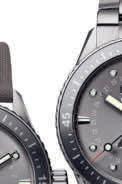










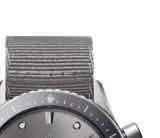
Blancpain presents two new takes on its Fifty Fathoms Bathyscaphe Quantième Complet theme: a red gold version with a blue-gradient dial; and a titanium version with an anthracite dial. The distinctive styles of these new models bring together a brace of emblematic Blancpain universes: the sporting DNA of its famous Fifty Fathoms diver's watch and its traditional complete calendar with moon phases. The Bathyscaphe Quantième Complet watch in red gold is available with a blue NATO or sailcloth strap. The titanium model comes with a titanium bracelet or a grey NATO or sailcloth strap.








126 VIEWS MAGAZINE
SHOPPING VIEWS
BLUE BELLES
BLANCPAIN
The venerable Swiss watchmaker has augmented its Air Command collection. A model with a 36.2-mm diameter is now taking its place among the manufactory’s sporty chronometers. Though slightly smaller than the AC02, the AC03 still has all the attributes of a big player. Its grade-23 titanium – a quality very seldom used in haute horlogerie – comes with a blue calfskin strap with white seams. A red gold model is also available. Mirroring Blancpain’s desire to include ladies’ models in all its collections, this new timepiece will doubtless appeal to even the most audacious feminine spirit.
T E CH TREASURES


BLANCPAIN


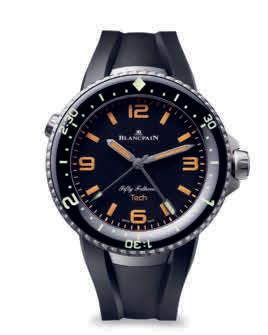





Fifty Fathoms Tech Gombessa Blancpain is continuing its celebration of the 70th anniversary of the Fifty Fathoms from the Rangiroa Atoll in French Polynesia, where the Tamataroa mission has been taking place. It has opened a new chapter in the history of what was the first modern diver’s watch by unveiling a model designed to meet today’s technical diving requirements. Featuring an innovation co-developed by Marc A. Hayek, President & CEO of Blancpain, and Laurent Ballesta, founder of the Gombessa project, this instrument – dubbed »Tech Gombessa« – for the first time makes it possible to measure up to three-hour immersion times. Its release commemorates the 10th anniversary of Gombessa, an initiative that Blancpain helped create by becoming the project’s founding partner from its inception in 2013. It also marks the launch of a new line in Blancpain’s diver’s watch collection.

127
SHOPPING VIEWS






























































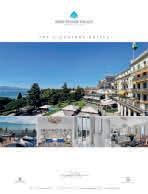

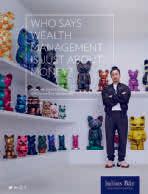





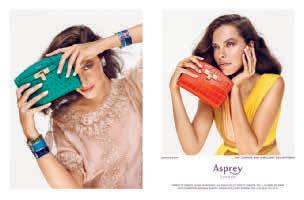
128 VIEWS MAGAZINE VIEWS ADVERTISING PARTNERS
Established some 40 years ago, we handle with excellence and a passion for detail all aspects of collecting historic automobiles. Our services include:
• buying and selling historic motorcars, both on our own account and for clients

• looking after our collector clients and their collections all around the world
• repair work and full restorations, using only the leading specialists and restorers
• maintenance, storage in our Zurich facilities, and transport world-wide
We concentrate in the high end of pre-war and Fifties/Sixties automobiles and specialise in the models that were market leaders and successful in their day. Our preferred marques include Bugatti, Alfa Romeo, Aston Martin, Bentley, Rolls-Royce, Lancia, Ferrari and Maserati. New cars are available on request.
We always have a selection of outstanding automobiles in stock which are either in excellent original condition or restored to perfection. We look forward to talking to you about our current stock, or the car that you are looking for. Please send your inquiry to Yves Boitel on the contact details below.
If you wish to sell an important car, we would be happy to discuss your car and your requirements. Visits to our showroom are by appointment only.
Lindenstrasse 26 CH-8008 Zürich Switzerland Tel (+41) 44- 384 84 00 Fax (+41) 44- 380 74 11 cars@lukashuniag.ch
Lancia Flaminia 2500 Sport Zagato Pre-Series 1959
Copyright




















 “Creation”
Wildlife Photographer of the Year 2021 Grand Title winner © Laurent Ballesta
“Creation”
Wildlife Photographer of the Year 2021 Grand Title winner © Laurent Ballesta
































































































































































 KENNEDY YANKO
Photos by Genevieve Hanson. Courtesy of the artist and Jeffrey Deitch, New York.
KENNEDY YANKO
Photos by Genevieve Hanson. Courtesy of the artist and Jeffrey Deitch, New York.














































 RIVA DEL GARDA, ITALY
RIVA DEL GARDA, ITALY


































 Refik Anadol @Efsun Erkilic
Photos: ‘Glacier Dreams’, 2023, ©Refik Anadol Studio
Refik Anadol @Efsun Erkilic
Photos: ‘Glacier Dreams’, 2023, ©Refik Anadol Studio
















































































































































































































































































































